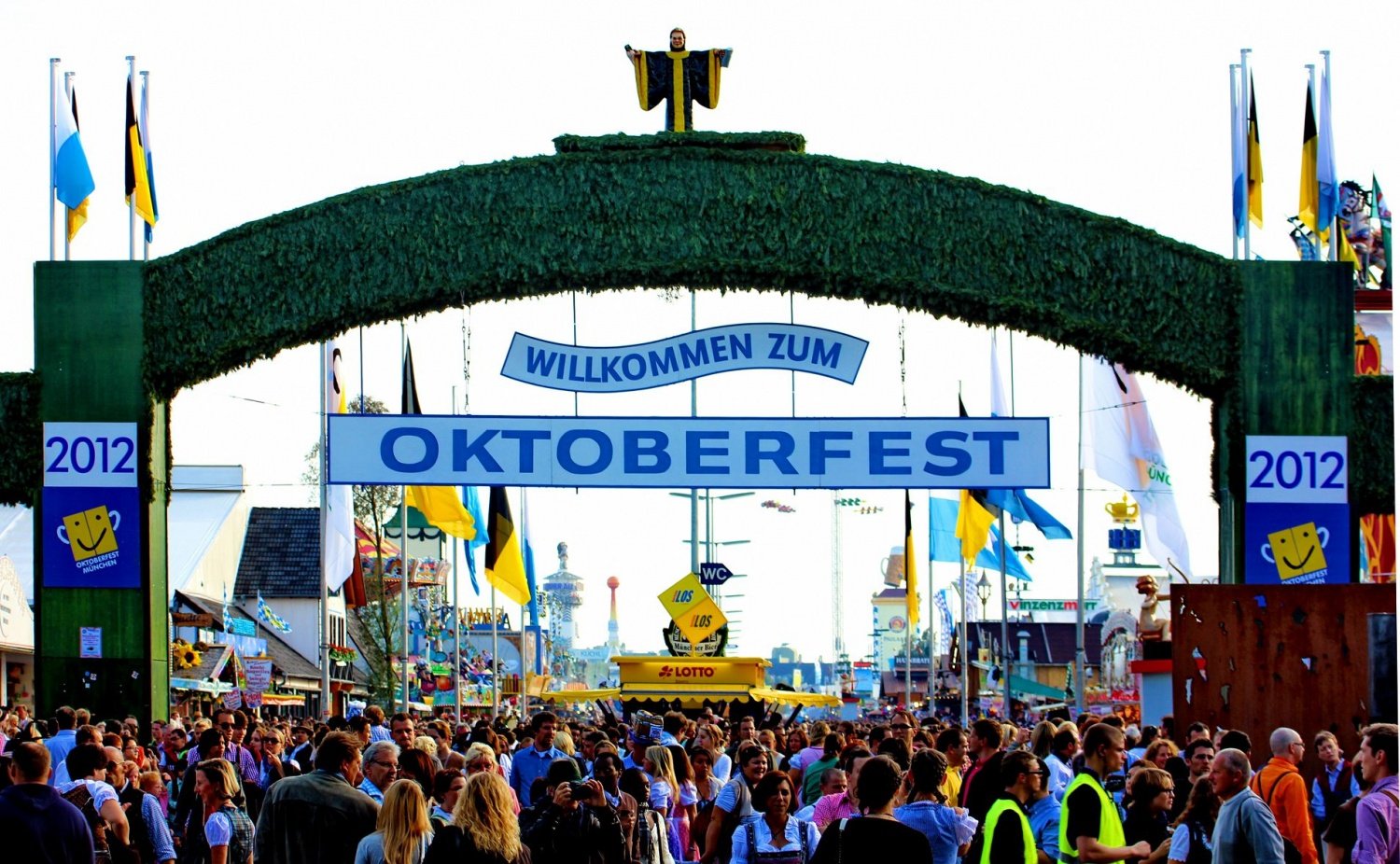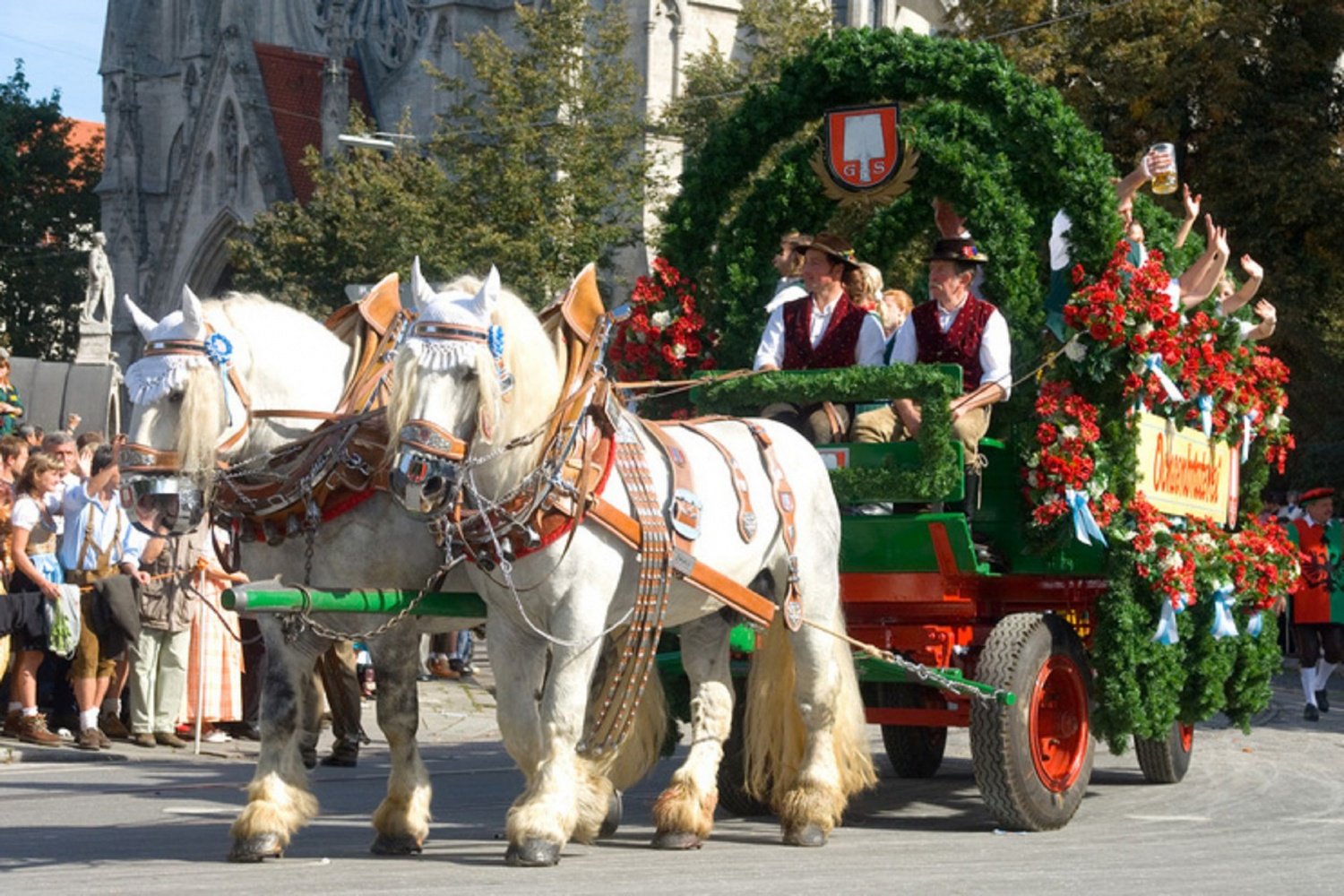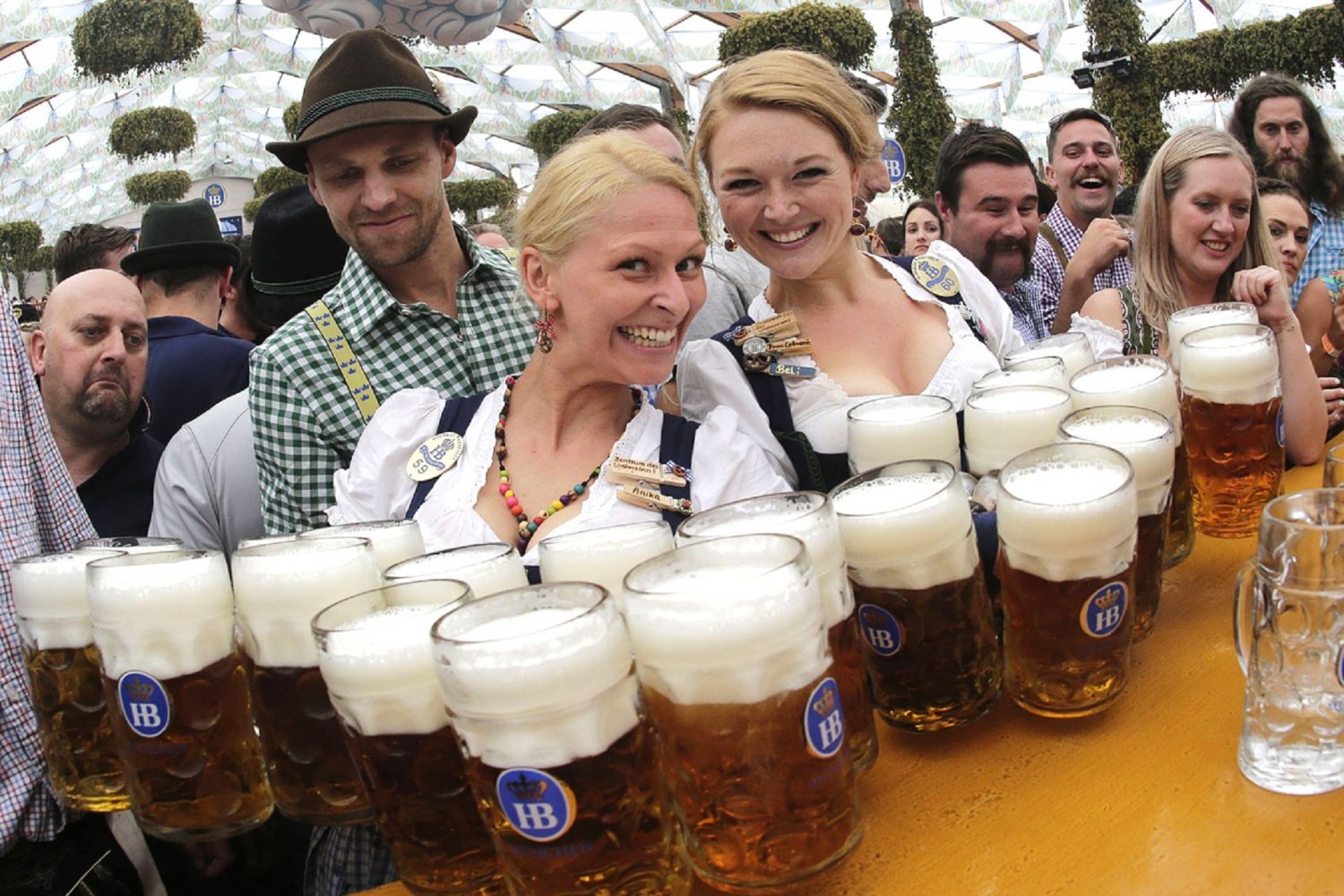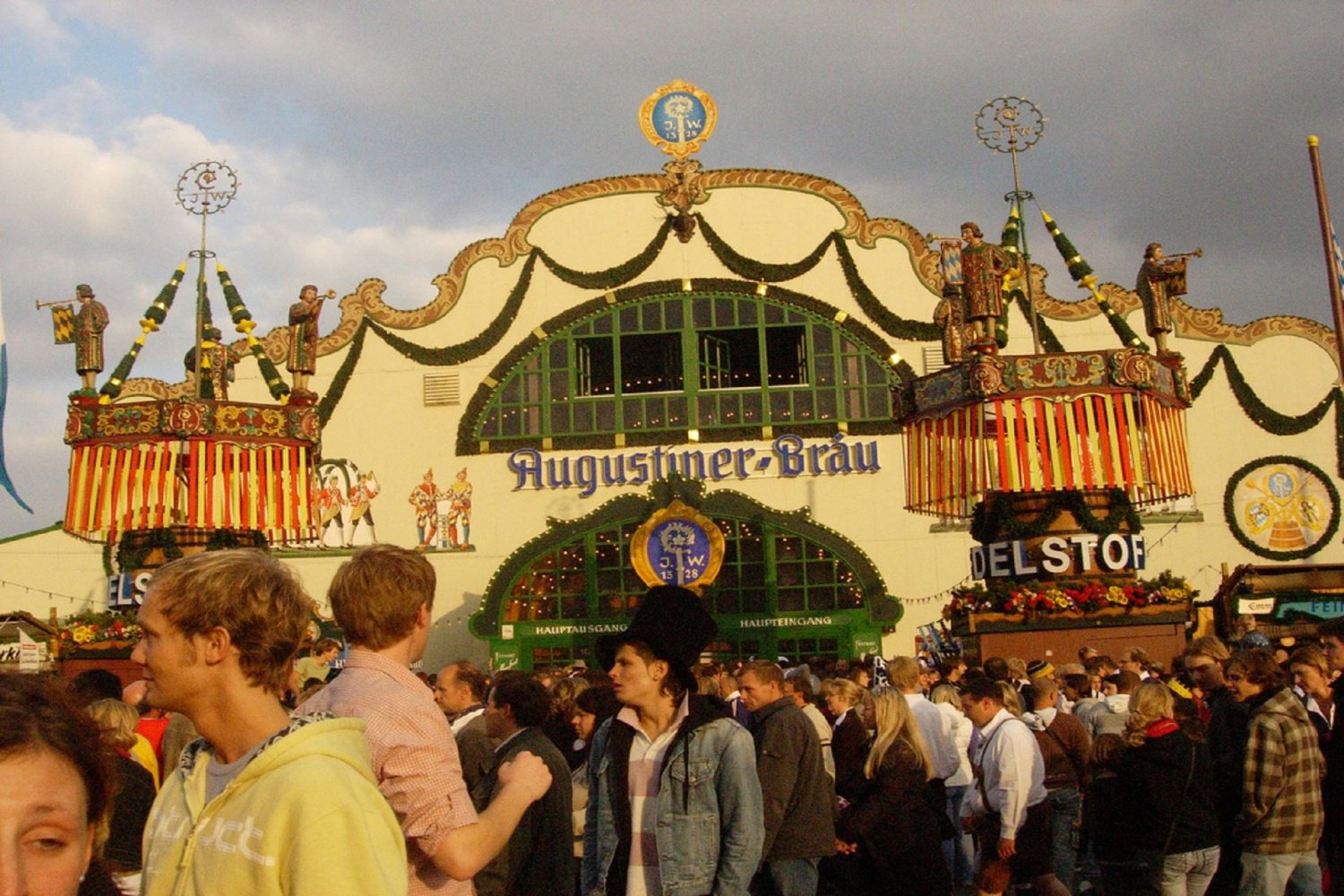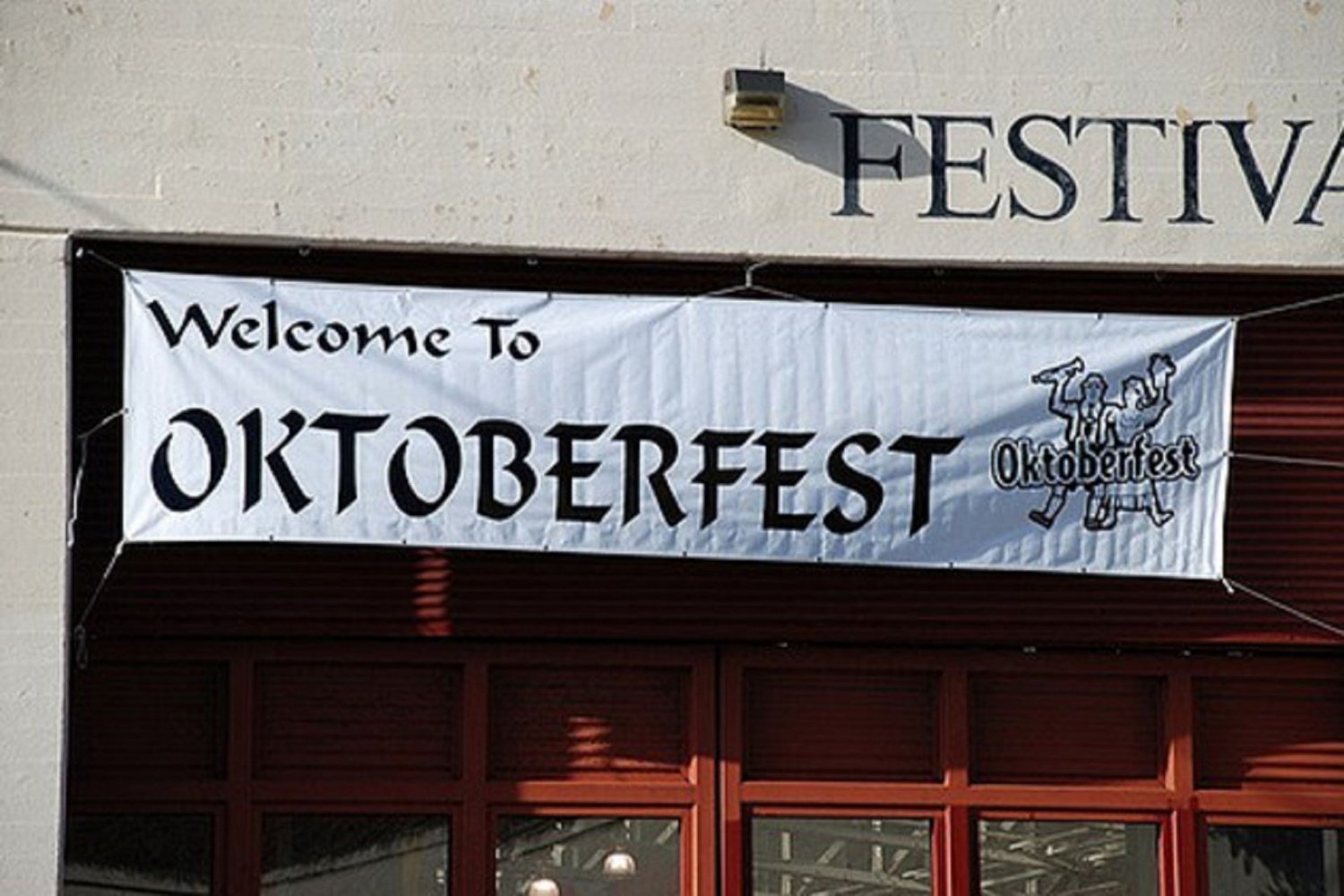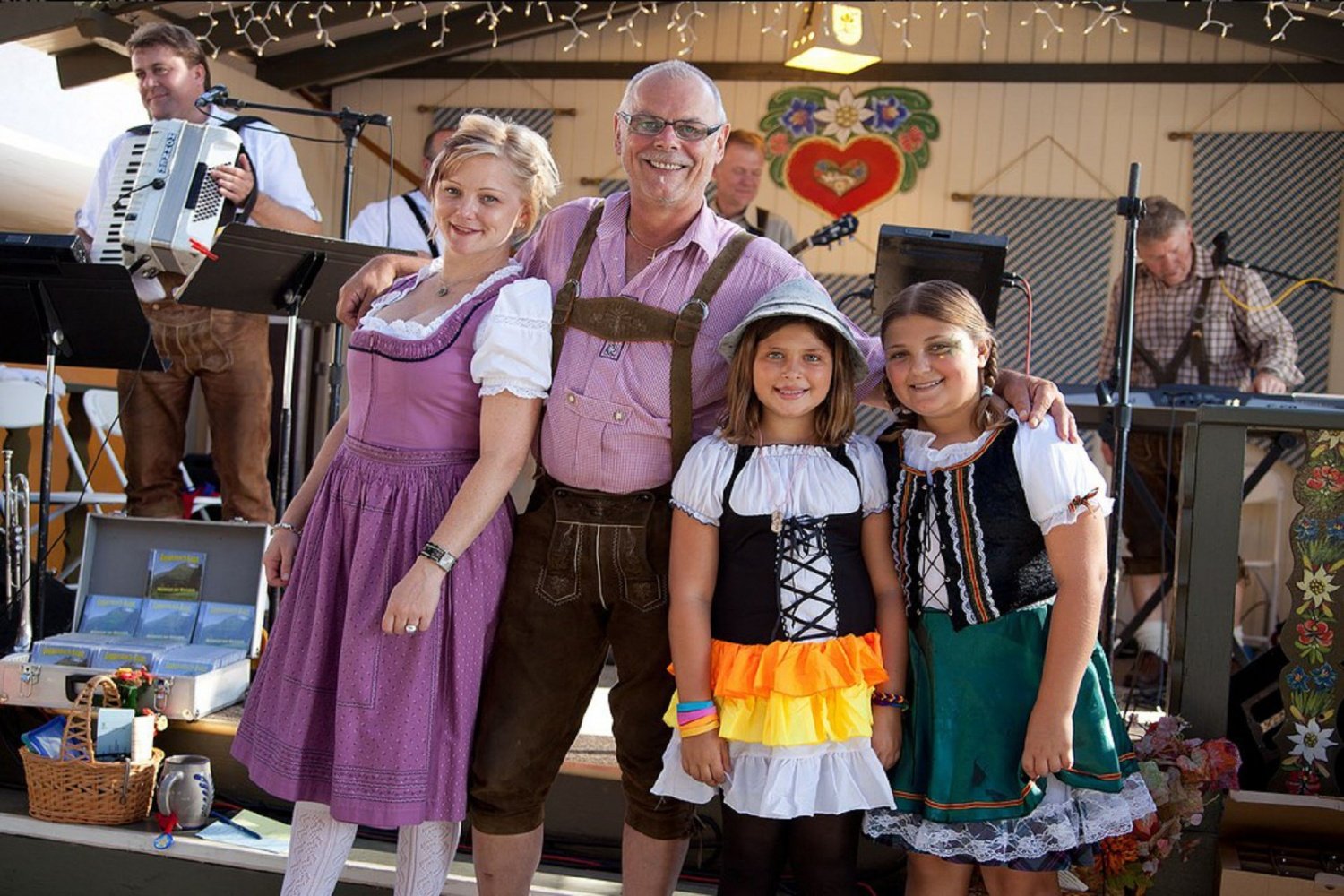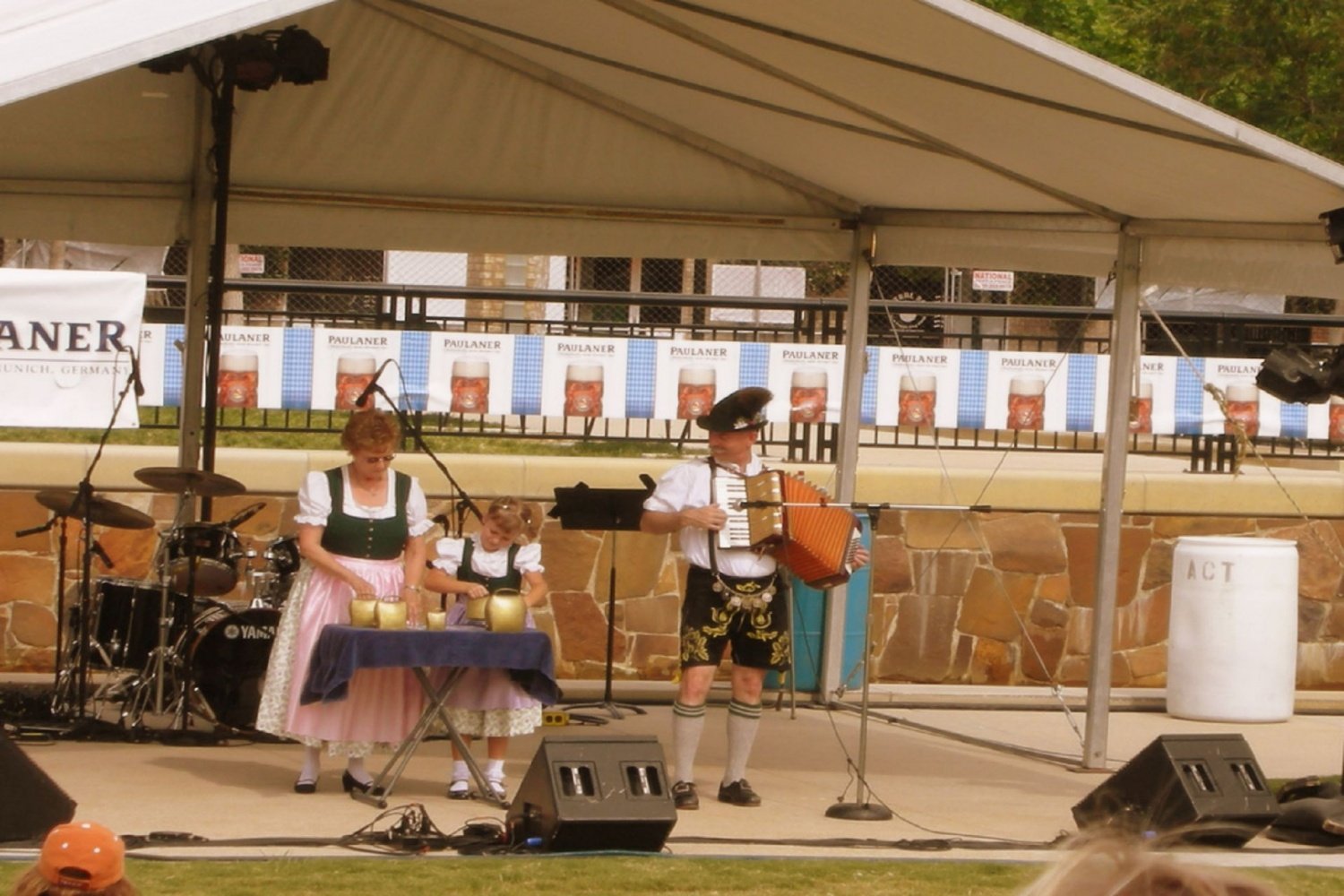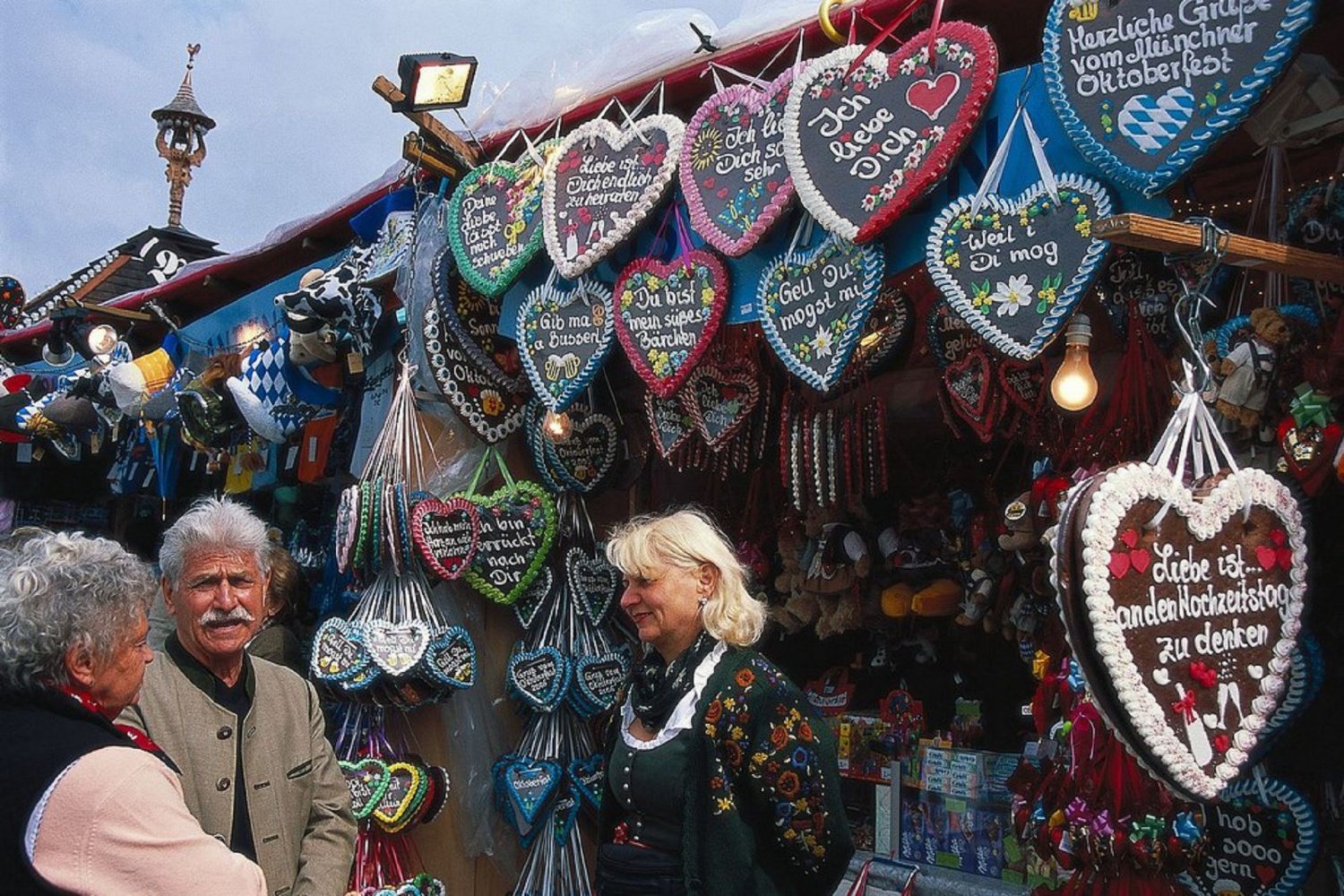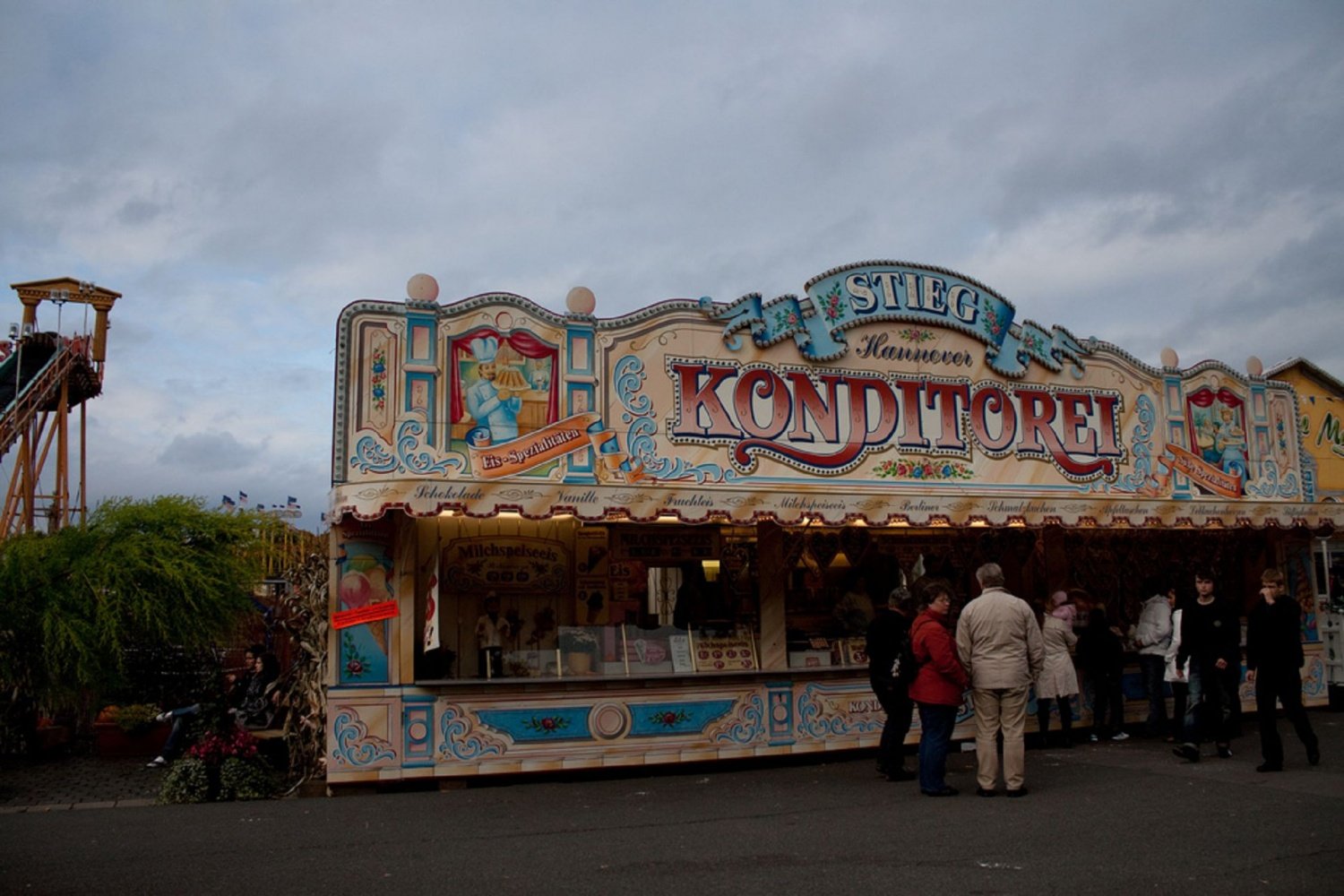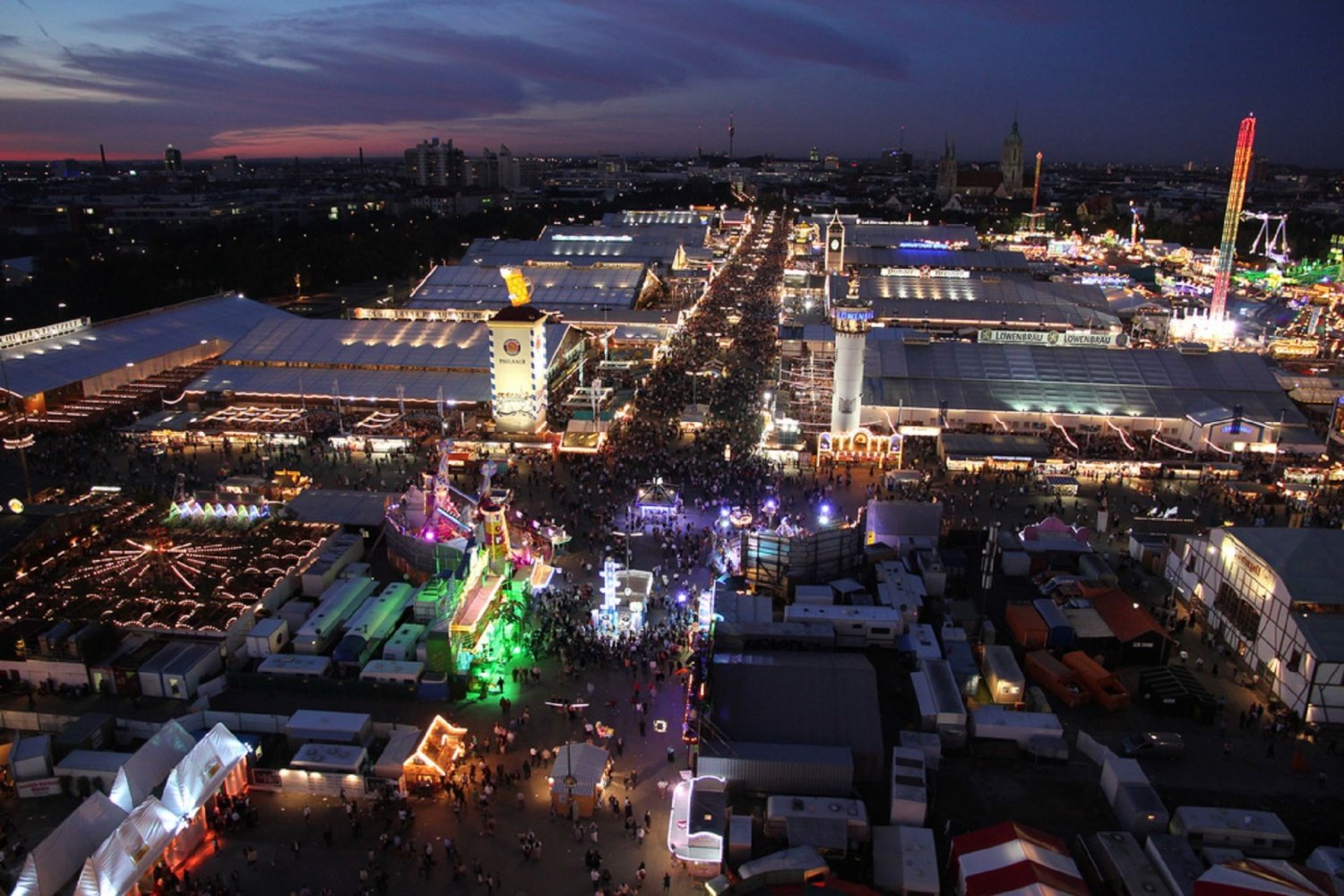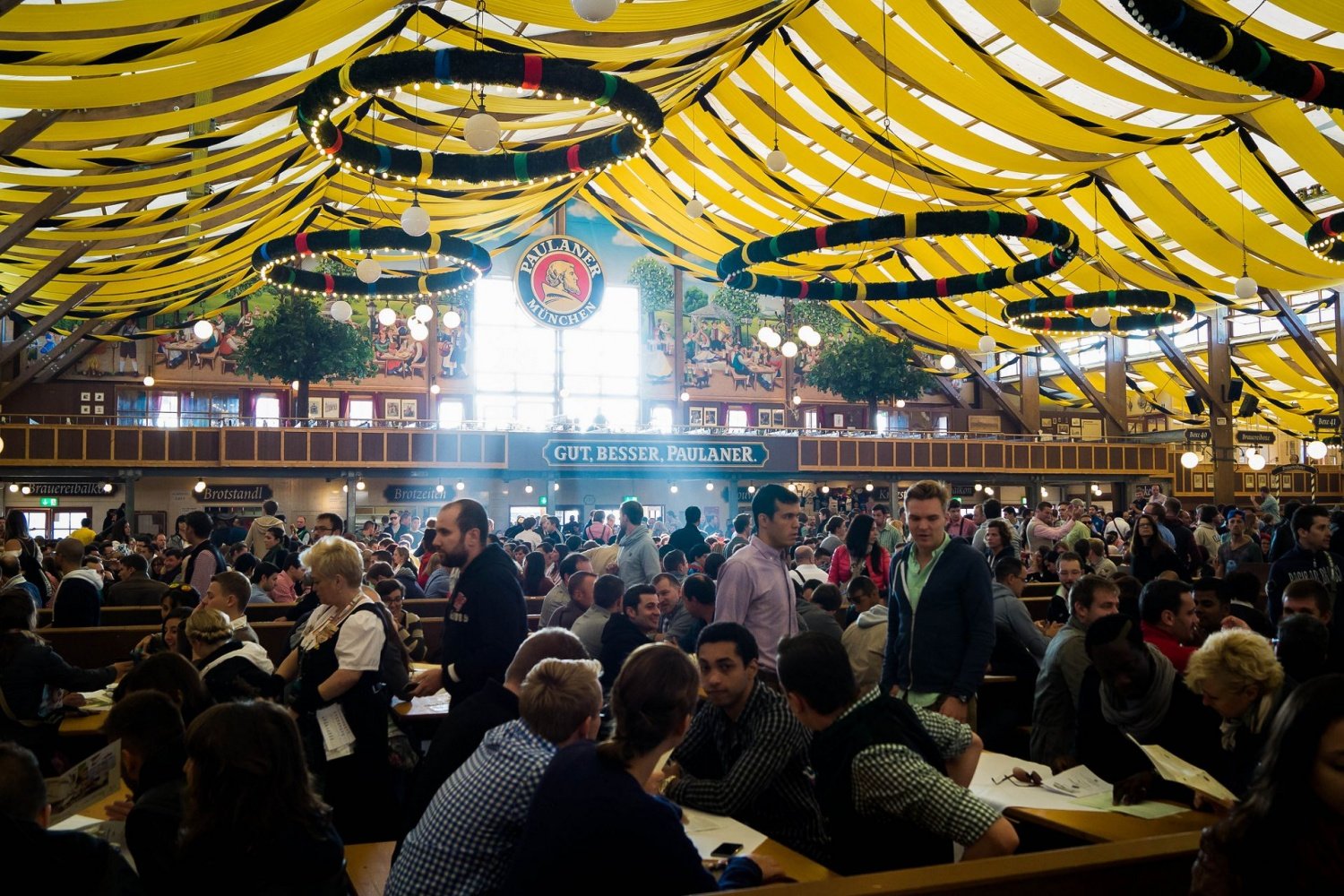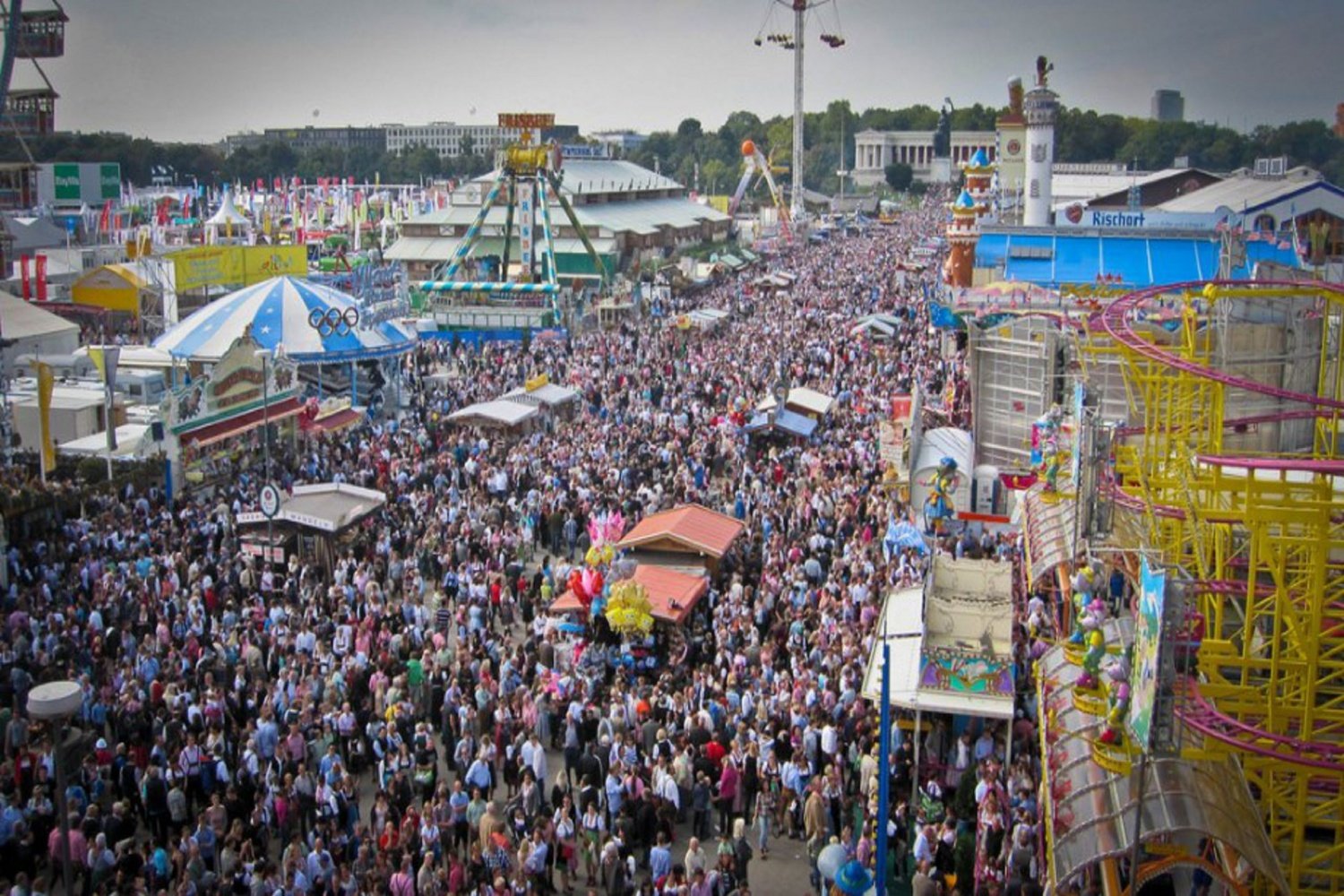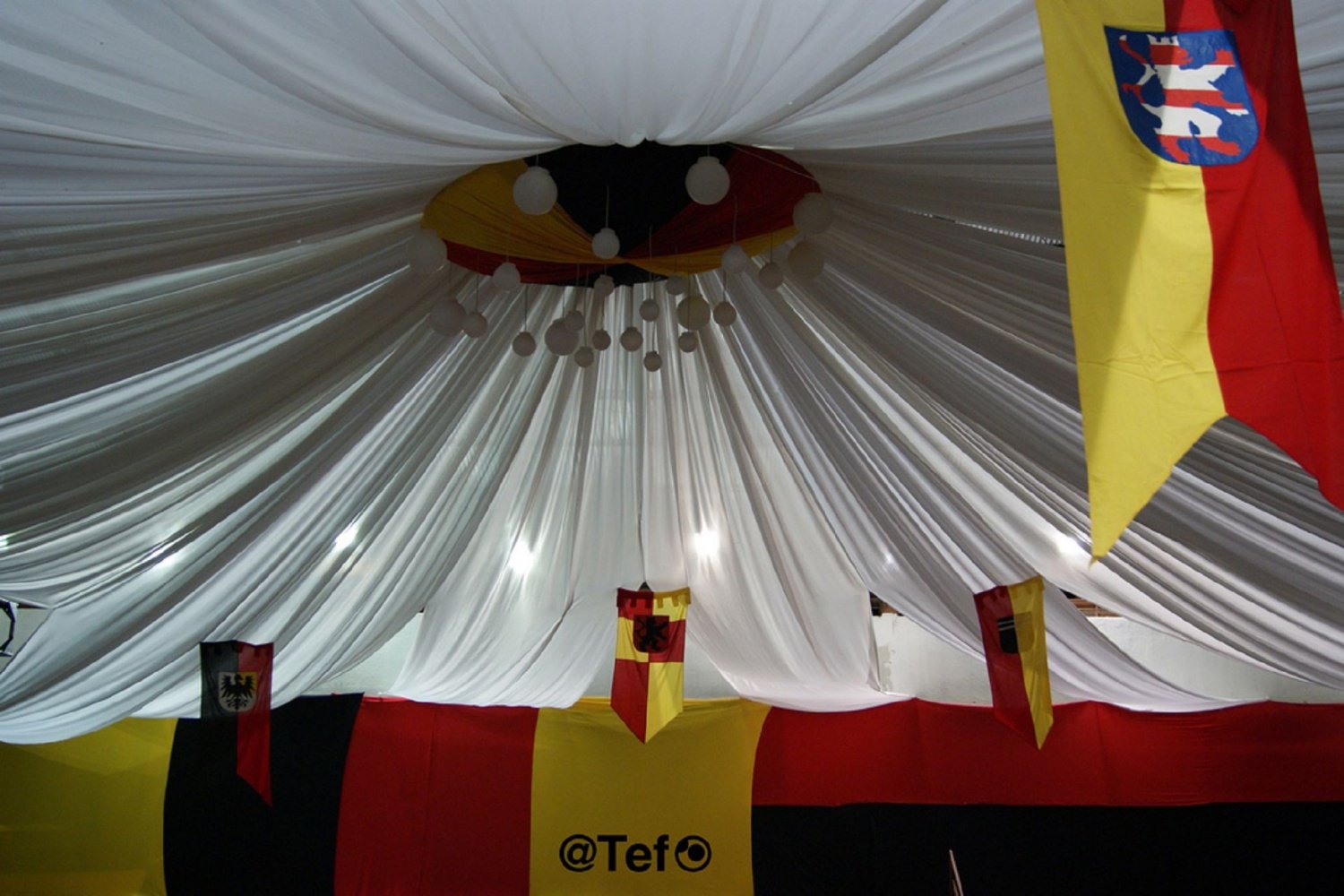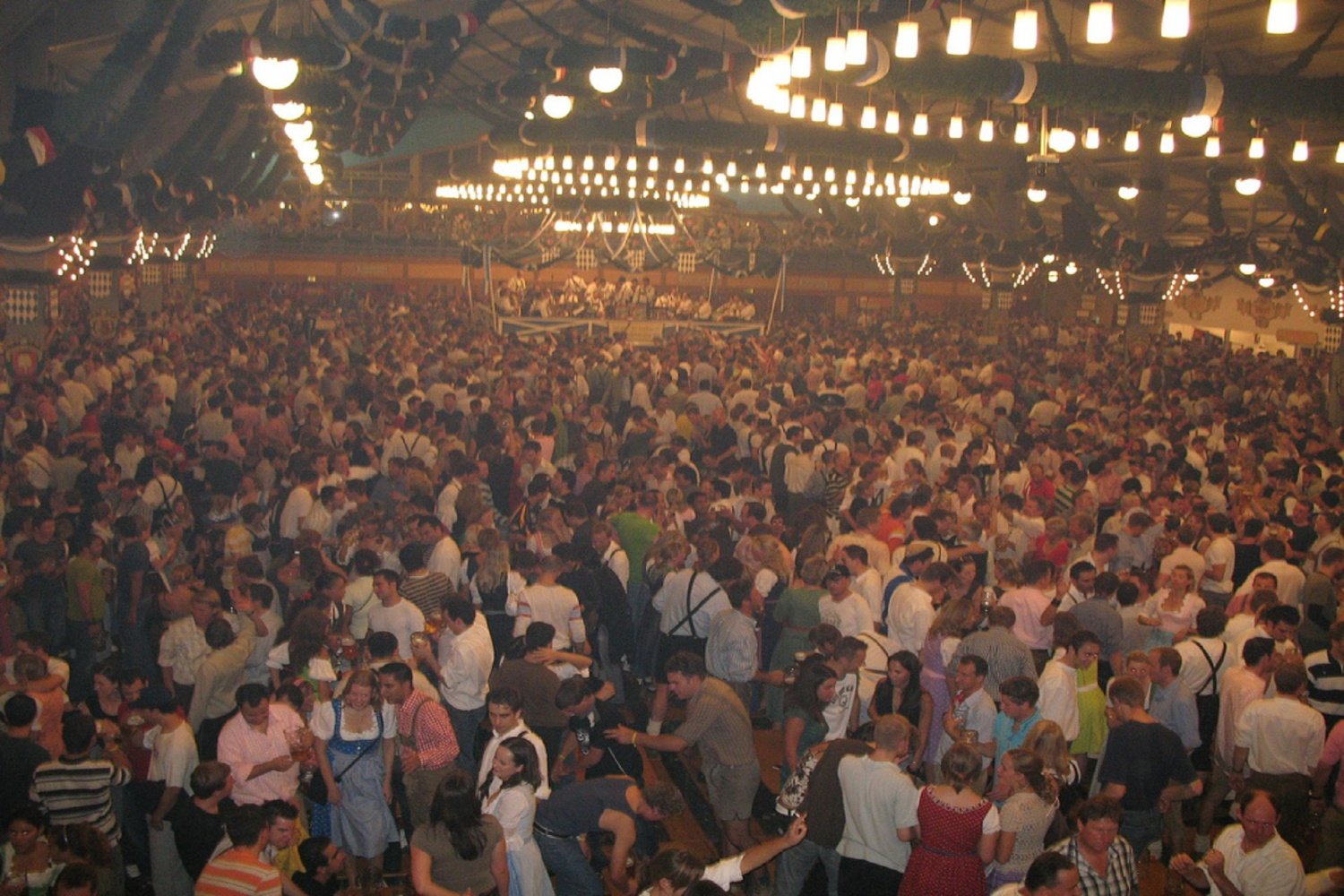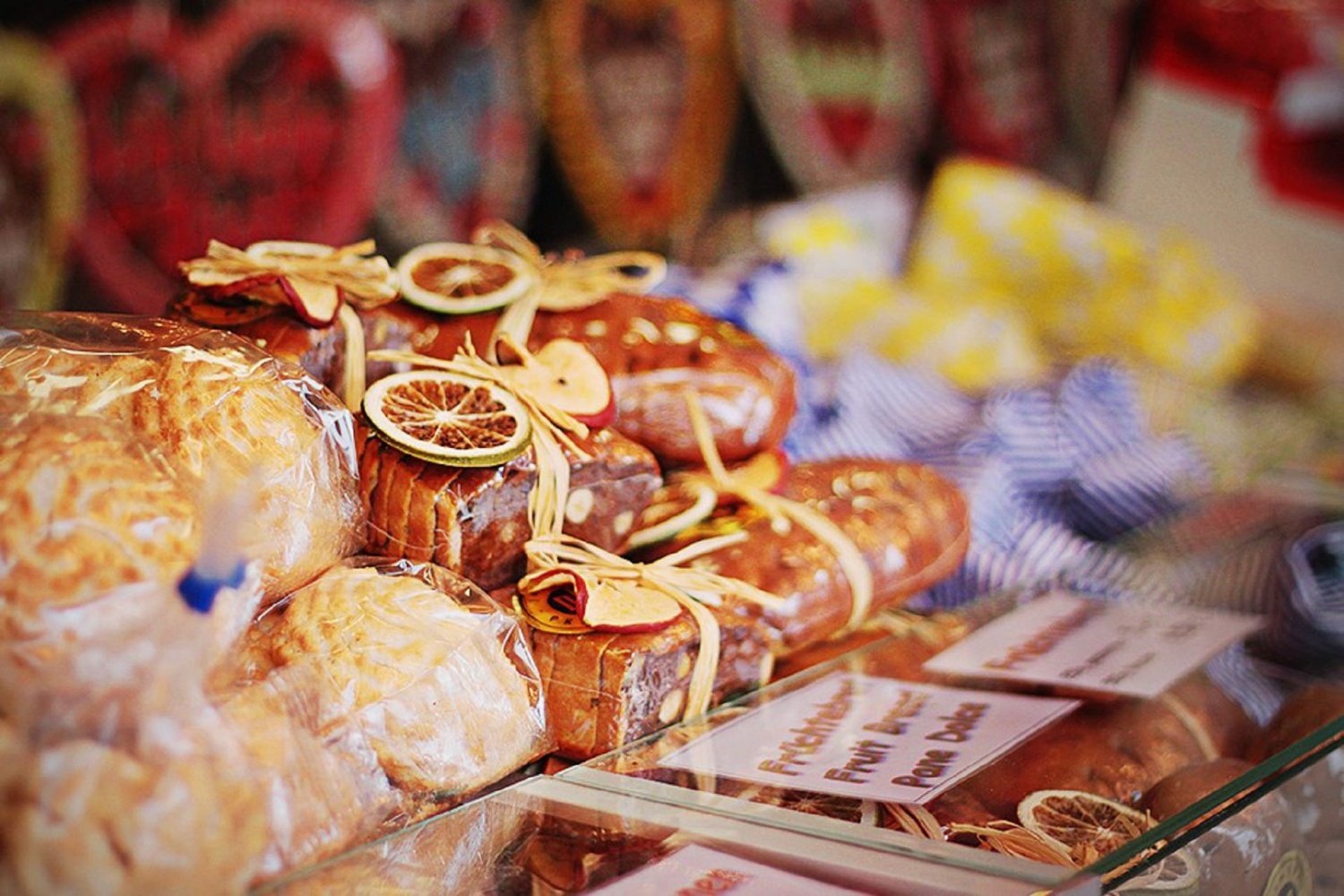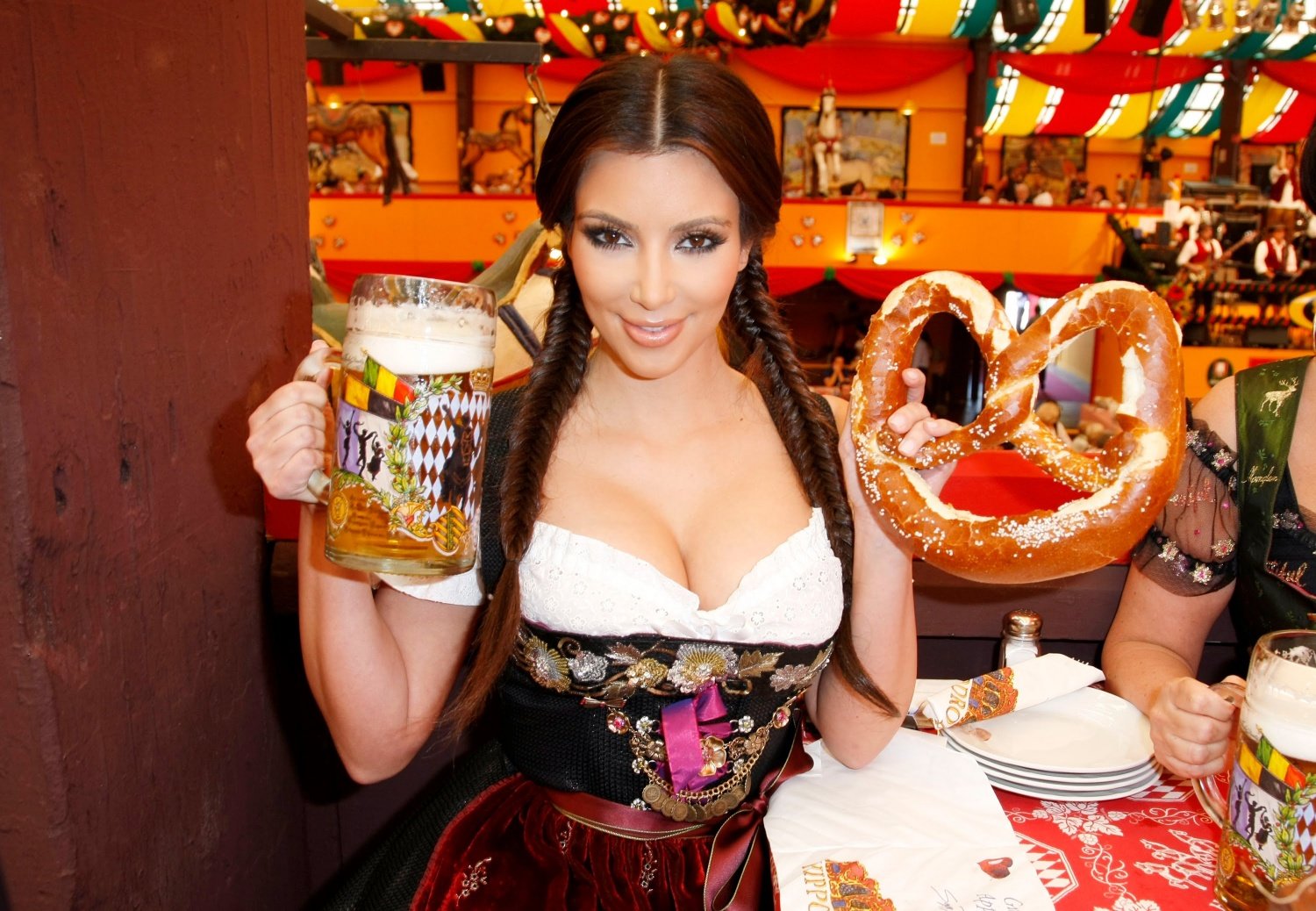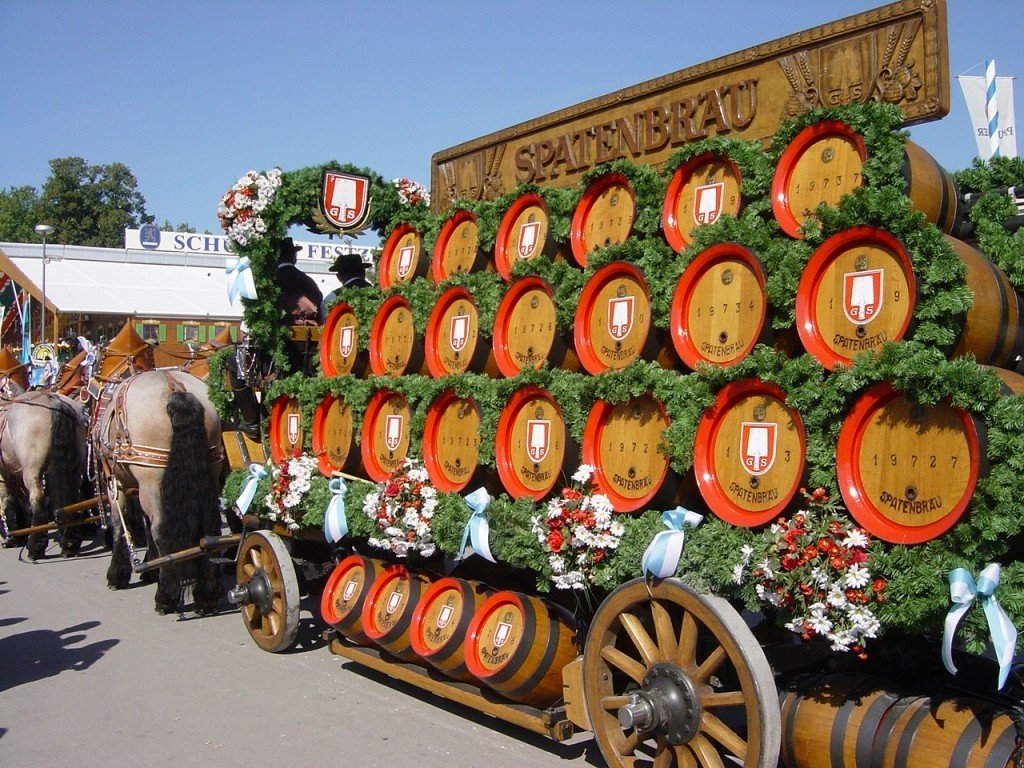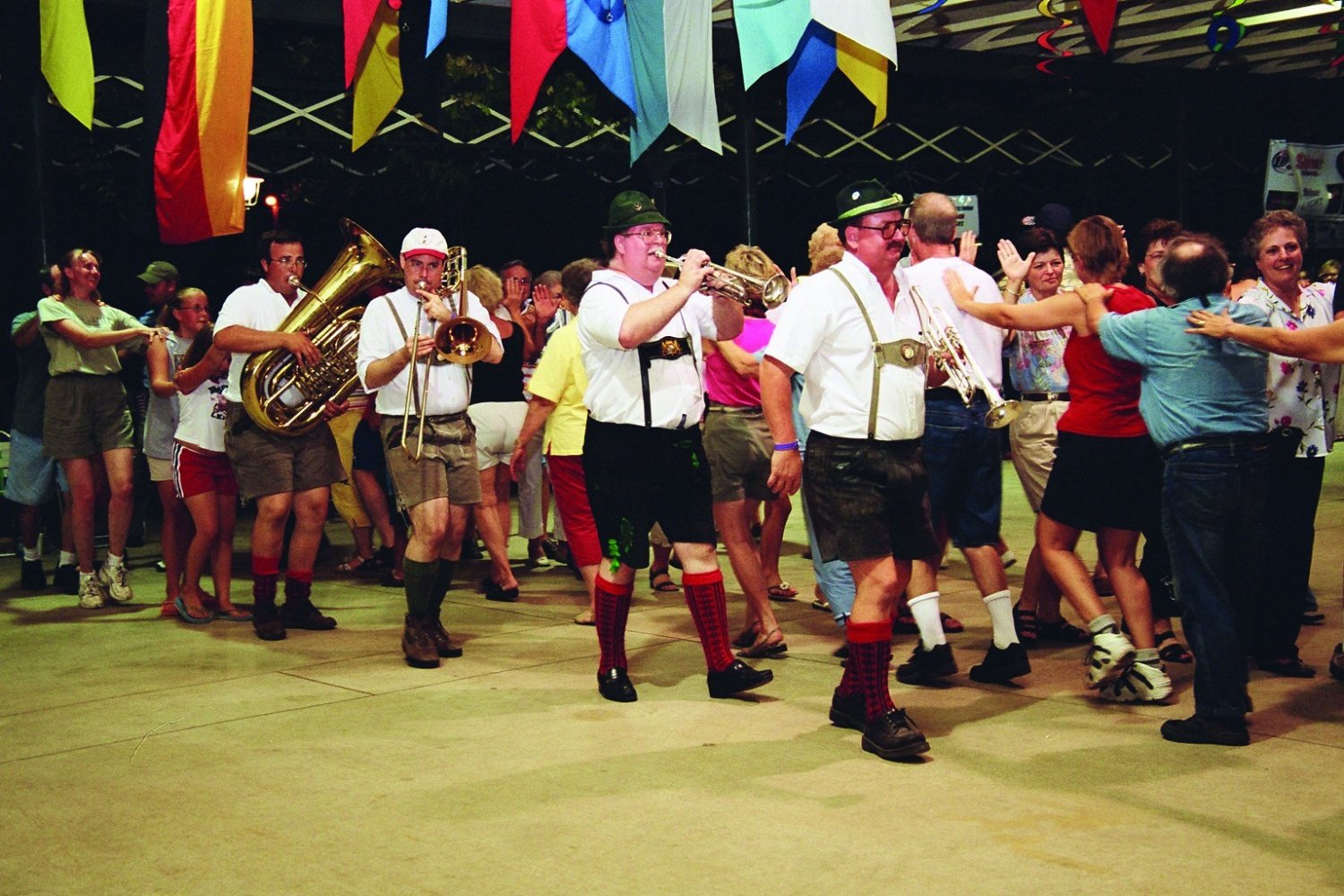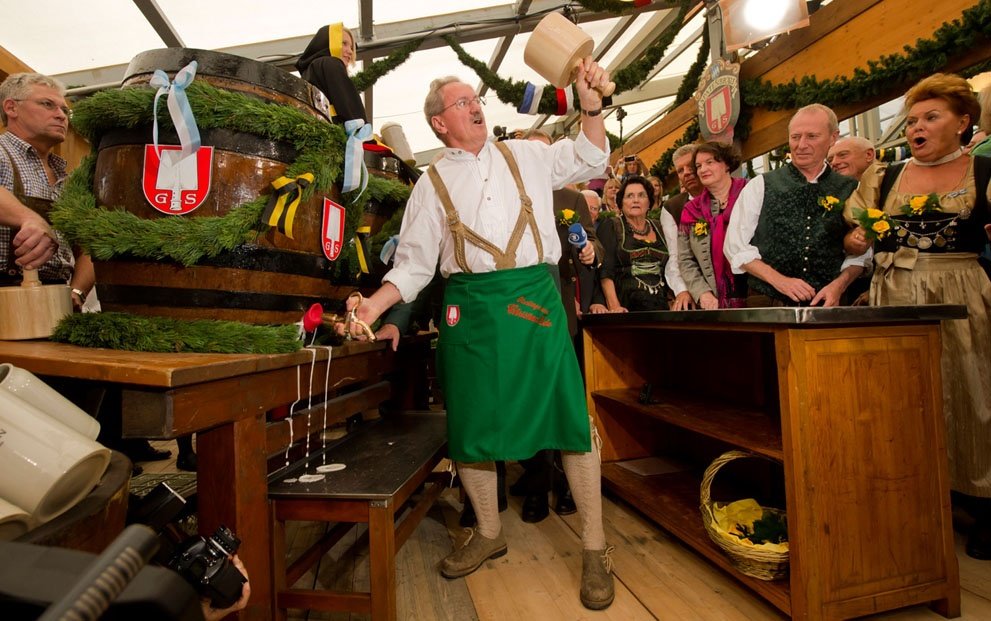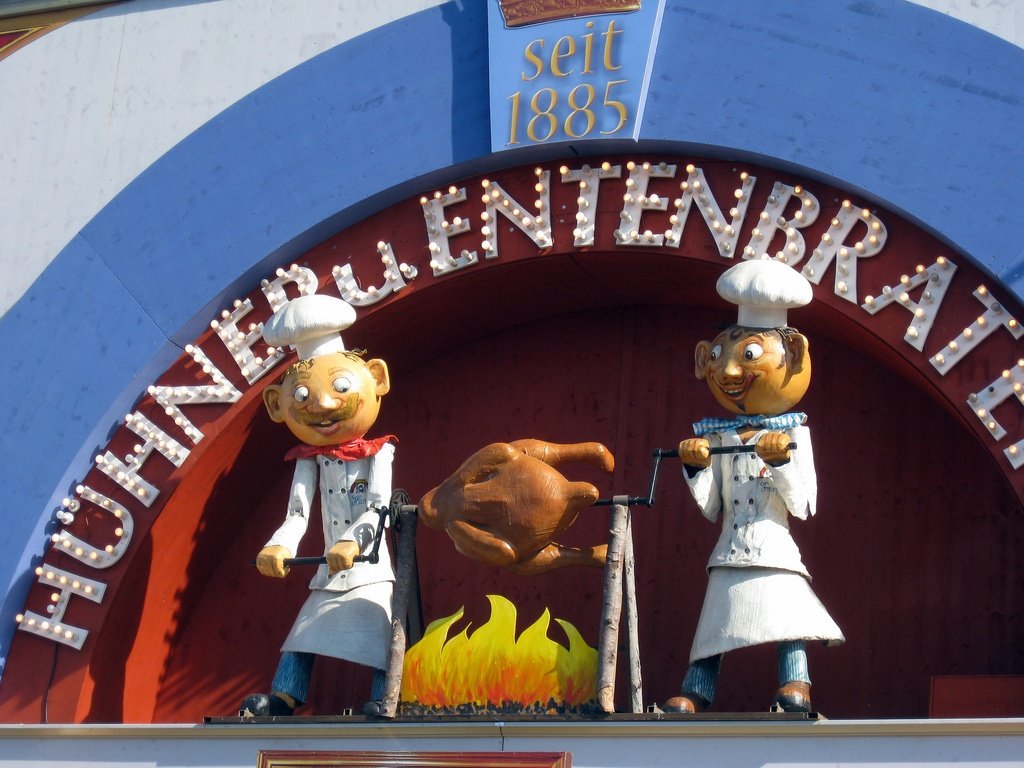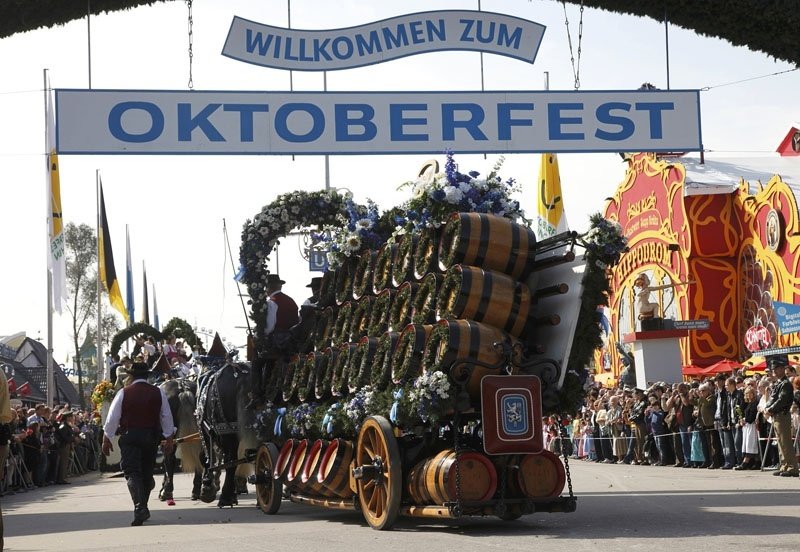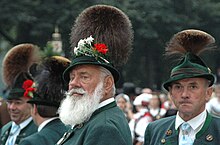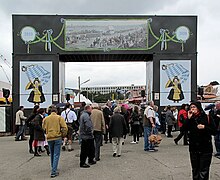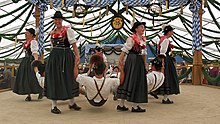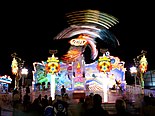Окто́берфест (Октябрьские народные гуляния, нем. Oktoberfest) — фольклорный фестиваль, ежегодно проводимый в Мюнхене (Германия), крупнейший в мире фестиваль пива. Ivbg.ru расскажет об истории праздника и интересных фактах.
Октоберфест организуется и проводится администрацией Мюнхена. К участию в этом фестивале допускаются только мюнхенские пивоваренные компании, которые варят для него специальное октоберфестовское пиво(нем. Oktoberfestbier) с содержанием алкоголя 5,8—6,3 %, которое в другое время года обычно называют мартовским или венским.
На празднике имеется множество аттракционов — от традиционных каруселей, на которых можно покататься вот уже более восьмидесяти лет, до сверхсовременных конструкций вроде «американских горок».

История праздника
Праздник имеет длинную историю проведения. С 1872 года он начинается уже в сентябре. Первым днём традиционно является суббота, из-за чего продолжительность может сильно варьироваться (в среднем 16 дней). Праздник заканчивается в первое воскресенье октября. Если же оно приходится на 1 или 2 октября, то праздник продлевается до 3 октября.
Впервые Октоберфест состоялся 12 октября 1810 года в честь свадьбы кронпринца Людвига (в будущем король Людвиг I) и принцессы Терезы Саксонской-Хильдбургхаузской (её именем назван луг, где проходит праздник). В честь свадьбы 17 октября также были устроены скачки. По этой причине в разных источниках называется разная дата первого Октоберфеста (12 и 17 октября).
Изначально праздник организовывался и проводился частным образом. В 1819 году организация и управление праздником были отданы в руки городского совета Мюнхена. Было решено, что Октоберфест будет проводиться каждый год без исключения.
В 1872 году Октоберфест был впервые перенесён на конец сентября — начало октября, так как в это время погода в Мюнхене более комфортная, чем в середине октября. В 1904 было принято окончательное решение о переносе праздника на конец сентября, однако последнее воскресенье праздника должно было быть в октябре. Эта традиция сохранилась и до наших дней.
В 1881 году открылась первая жарильня курочек, а в 1892 году пиво впервые стали подавать в привычных сейчас стеклянных кружках. Примерно в то же время палатки, в которых продавалось пиво, приняли тот вид, который они имеют сейчас.
В 1910 году Октоберфест отпраздновал столетие. По этому поводу было продано 1,2 млн литров пива. В 1913 году была установлена самая большая в истории праздника палатка на 12 000 мест.
С 1914 по 1918 год Октоберфест не проводился из-за Первой мировой войны. В 1919 и 1920 году Октоберфест был переименован в «Осенний праздник» (нем. Herbstfest).
В 1936—1938 годах баварские бело-голубые флаги, украшавшие праздник, заменялись на нацистские флаги со свастикой.
С 1939 по 1945 год Октоберфест не проводился из-за Второй мировой войны.
С 1946 по 1948 год снова праздновался лишь «Осенний праздник». Был запрещён розлив настоящего «октоберфестовского пива» — посетителям приходилось довольствоваться разрешённым слабоалкогольным (< 2 %) пивом.
С 1950 года существует традиция начинать праздник двенадцатью выстрелами в небо из пушки, а также откупориванием первой бочки праздничного пива обер-бургомистром Мюнхена с характерным восклицанием «O’zapft is!».
С 1960 года начинается приток иностранных туристов на Октоберфест.
В 1980 году в результате теракта у главного входа на Октоберфест погибло 13 и было ранено более 200 посетителей. Тем не менее, этот террористический акт не привёл к отмене праздника.
Террористические акты 11 сентября 2001 года не привели к отмене Октоберфеста, хотя такая возможность всерьёз обсуждалась организаторами. В знак солидарности с жертвами террористических актов организаторы отказались от церемоний выезда хозяев пивных палаток и откупоривания первой бочки. Также был отменён праздничный фейерверк.
Интересные факты
- Ежегодно Октоберфест посещают около 6 миллионов посетителей, которые выпивают около 6 миллионов литров пива и съедают 500 000 жареных кур.
- На Октоберфесте работает 12 000 человек.
- Праздник предлагает 100 000 сидячих мест для посетителей.
- Право принимать участие в празднике имеют шесть пивоварен — Spaten (Шпа́тэн), Augustiner (Аугусти́нэр), Paulaner(Паула́нэр), Hacker-Pschorr (Хаккэр-Пшо́рр), Hofbräuhaus (Хо́фбройхауз), Löwenbräu (Лёвэнброй), которые в 2004 году продали 5,5 миллионов литров пива (6,1 в 2003 году).
- Оборот праздника в 2006 году составил 449 миллионов евро.
- На проживание в отелях и проезд в общественном транспорте гости праздника потратили в 2006 году более 500 миллионов евро.
- Цена литра пива, как правило, каждый год возрастает. Так, в 2007 году она составляла от 7,30 до 7,90 евро, а в 2008 году от 7,80 до 8,30 евро.
- В 2007 году была зарегистрирована 351 карманная кража — на 99 меньше, чем в 2006 году.
- Громкость музыки в палатках до 18 часов не должна превышать 85 децибел.
- Для снабжения праздника электроэнергией используются 18 трансформаторов и 43 километра электрокабеля.
- Потребление энергии составляет примерно 3 миллиона киловатт-часов, что соответствует примерно 13 % ежедневного потребления электроэнергии Мюнхеном.
- Пивная палатка потребляет около 400 киловатт-часов, большие аттракционы — около 300.
- Для обеспечения палаток газом была проложена четырёхкилометровая сеть газовых труб.
- 200 тысяч кубометров газа потребляются кухнями и ещё 20 тысяч уходит на отопление пивных садов, расположенных на открытом воздухе.
- Объём продаваемого пива в кружке не должен отличаться от 1 литра более чем на десятую часть. За соблюдением этого правила следит специальное общество «Verein gegen betrügerisches Einschenken».
- Для посетителей открыты 830 туалетов, оборудованных обычными унитазами, и уриналы, общей длиной 750 метров. Для инвалидов доступны 17 специально оборудованных туалетов.
Вряд ли существует пивной фестиваль, более известный, чем мюнхенский Октоберфест, который ежегодно собирает гигантское количество любителей хмельного напитка. На 16 дней город превращается в одну огромную пивную. На улицах, площадях и аллеях, в парках, бройхаузах и кнайпах гости Октоберфеста выпивают миллионы литровых кружек пива, съедают сотни зажаренных на вертеле быков, тысячи свиней и кур, не считая легендарных баварских сосисок. Сердцем же фестиваля является Луг Терезы, где круглые сутки в 14 павильонах происходит настоящее пивное веселье.
В 2019 году Октоберфест официально начнется 21 сентября в 10.45 утра по местному времени. В преддверии главного пивного праздника мира мы расскажем об его истории, правилах, кухне, традициях и, конечно же, о легендарном пиве фестиваля.
История Октоберфеста
Традиция празднования Октоберфеста насчитывает уже более 200 лет
Название фестиваля переводится с немецкого как «праздник октября». Сами же мюнхенцы называют его Wiesn – от немецкого «луг», «лужайка». Историки пивоварения считают, что своими корнями Октоберфест уходит в традиционный крестьянский праздник сбора урожая и завершения работ на полях.
Официально же началом традиции фестиваля принято считать торжества, которые проводились в течение 6 дней октября 1810 года в связи с бракосочетанием кронпринца Людвига (будущего короля Людвига I) и принцессы Терезии Саксонской-Хильдбургхаузен (именно в ее честь и назван Луг Терезы). Отец невесты, король Максимилиан I Иосиф решил отметить свадьбу пышными народными гуляниями и конными скачками на лугу перед городскими воротами, которые длились 6 дней. По разным источникам первым днем торжества стало 12 или 17 октября.
Праздник настолько понравился местным жителям, что год спустя его решили повторить. В течение 9 лет торжества проводились в частном порядке – исключением стал 1813 год, когда праздник отменили из-за вступления Баварии в Наполеоновские войны. В 1819 году фестивалем стал управлять мюнхенский городской совет. Тогда же градоначальники решили сделать Октоберфест регулярным.
В 1850 году на лугу Терезы патриотично настроенные граждане воздвигли 19-метровую бронзовую статую красавицы Баварии, которая стала неофициальным символом фестиваля. Внутри статуи была построена лестница из 125 ступеней, по которым можно было подняться на смотровую площадку.
За свою историю традиция Октоберфеста прерывалась лишь из-за тяжких бедствий. Например, в 1854 и 1873 годах торжества отменяли из-за эпидемии холеры. В 1866 мюнхенцы остались без праздника из-за Прусско-австрийской, а в 1870 – из-за Франко-прусской войны.
В 1872 году городской совет принял решение перенести на последние дни сентября – в это время в Мюнхене еще стоят теплые дни. В 1904 перенос Октоберфеста закрепился окончательно, однако его последнее воскресенье должно было обязательно выпасть на октябрьский день – эта традиция действует и поныне.
В 1881 году на фестивале появилась первая кухня – была открыта жарильня кур. Первые знаменитые на весь мир литровые кружки «массы» ввели в 1892 году. Примерно в это же время на Октоберфесте участники торжества начали ставить пивные палатки. Сначала в них устраивали аттракционы, однако позднее все развлечения сделали уличными, оставив в палатках лишь столы и скамейки, а также площадки для гостей и музыкантов. В 1901 году на празднике построили настоящую бедуинскую деревню с жителями, что стало тогда настоящей сенсацией.
Интересный факт! В 1886 году на Октоберфесте зажглись первые лампочки. За электрификацию отвечал отец Альберта Эйнштейна. По некоторым данным, будущий гениальный физик-теоретик помогал вкручивать лампочки в шатре Шоттенхаммель.
На столетие Октоберфеста в 1910 году гости праздника выпили 1,2 млн литров пива. 3 года спустя был поставлен непреодолимый до сих пор рекорд – на фестивале поставили палатку Bräurosl на 12 000 мест (для сравнения, крупнейшая палатка наших дней –Hofbräu-Festhalle – рассчитана на 10 000 гостей).
С 1914 по 1918 год из-за Первой мировой войны в традиции Октоберфеста вновь наступила пауза. В 1923 и 1924 годах фестиваль вновь не проводился. На этот раз – из-за колоссальной инфляции в Германии. Некоторые изменения на праздники произошли в 30-х годах, когда к власти пришли национал-социалисты. В частности, были запрещены выставки-кунсткамеры, а баварские бело-голубые флаги сменились на нацистские со свастикой. При этом возобновились скачки, которые к тому времени проводились все реже.
Октоберфест не проводился лишь в годы войн и эпидемий
Самый большой перерыв в истории Октоберфеста произошел с 1939 по 1945 год. С 1946 по 1948 год руководство фестиваля запретило «октоберфестовское пиво» – разливали лишь слабоалкогольное с крепостью менее 2 %.
В 1950 году появилась еще одна традиция, которую ввел тогдашний обер-бургомистр Мюнхена Томас Виммер – праздник пива начинался после 12 пушечных выстрелов и откупоривания первой бочки. Кстати, герр Виммер забил пивной кран лишь с 19 ударов – до сих пор этот результат считается худшим. А рекорд в 2006 году поставил градоначальник Кристиан Уде, который открыл бочку с одного удара.
С 1960 года на Октоберфест начали стекаться иностранные туристы.
В 1980 году произошла главная трагедия фестиваля. Вечером 26 сентября праворадикальный экстремист Гундольф Келлер взорвал у входа в туалет самодельную бомбу. В результате теракта погиб сам подрывник, а вместе с ним – 13 гостей Октоберфеста. Ранения получили более 200 человек. Многие были уверены, что традиция фестиваля прервется навсегда, однако уже на следующий год Октоберфест вновь созвал гостей в свои шатры.
Не отменился фестиваль и после террористических актов 11 сентября 2001 года. Тем не менее, в память о жертвах атак на башни-близнецы организаторы отказались от традиции откупоривания первой бочки и шествия хозяев пивных палаток. Кроме того, были усилены меры безопасности: на Лугу Терезы установили камеры видеонаблюдения, а гостей охраняли около 400 полицейских.
Регламент фестиваля
Процессия, которая начинает Октоберфест, собирает несколько тысяч человек
Октоберфест начинается утром в третью субботу сентября с костюмированного шествия фермеров и пивоваров. Считается, что эта традиция восходит к 1887 году, когда Ханс Штайрер, фермер одного из крупнейших мюнхенских хозяйств, вывел работников своей фермы с груженными пивом телегами под духовой оркестр. В своем нынешнем виде шествие появилось в 1935 году, когда в нем впервые приняли участие местные пивоварни.
Шествие возглавляет символ Мюнхена – молодой монах Münchner Kindl, роль которого играет женщина в желто-черном монашеском одеянии с колокольчиком в руках. В процессии, которая выдвигается из Старого города и растягивается на несколько километров, участвуют кареты обер-бургомистра, главы Баварии и членов городского совета, горожане в национальных одеждах, повозки пивоварен и музыканты – всего более 8 000 человек и около 40 экипажей.
Участники шествия прибывают в основном из Баварии, Австрии, Швейцарии, северной Италии. Однако в последние годы среди участников процессии можно заметить и гостей из Восточной и Северной Европы. Организует шествие, готовит повозки и национальные костюмы баварская ассоциация по сохранению местных традиций Festring Munich.
В полдень на Лугу Терезы в павильоне Шоттенхамель-Фестхалле глава Мюнхена забивает пивной кран с возгласом «O`zapft is!» – «Кран забит!». После этого первые кружки пива подают градоначальникам, а далее свежее фестивальное пиво разливают всем желающим. Попутно с этим жители Мюнхена и гости фестиваля кружатся в танцах под национальную баварскую музыку.
Кстати, ищите немецкое пиво у нас в каталоге!
Какие пивоварни обычно принимают участие
Гостям праздника 6 пивоварен готовят специальное фестивальное пиво
Обычай Октоберфеста велит, чтобы гостям праздника подавали пиво только из мюнхенских пивоварен. При этом напиток должен быть сварен в строгом соответствии с мюнхенским законом о чистоте пива 1487 года и немецким законом о чистоте пива 1516 года (вода, солод, хмель, дрожжи, никаких добавок). На площади в 30 га организаторы выставляют 14 или 15 палаток, спонсорами которых являются 6 главных пивоварен Баварии:
- Augustiner;
- Hacker-Pschorr;
- Hofbräu;
- Löwenbräu;
- Paulaner;
- Spaten.
Augustiner
Монахи Августинского ордена основали старейшую и действующую по сей день пивоварню в 1328 году. В 1817 году производство переехало на улицу Нойхаузер, где сегодня о нем напоминает один из самых популярных в городе ресторанов Augustiner.
В конце XIX века штаб-квартира и пивоваренные заводы были перенесены на Ландсбергерштрассе, где пивоварение продолжается и сегодня. Augustiner – единственная пивоварня на Октоберфесте, которая наливает пиво из традиционных 200-литровых деревянных бочек, тогда как остальные используют современные металлические емкости.
На фестивале пиво Augustiner подают в палатках Augustiner Festzelt, Fischer Vroni и Festzelt Tradition.
Hacker-Pschorr
Данная пивоварня впервые упоминается в источниках 1417 года. В те времена она находилась на улице Зендлингерштрассе, где сейчас располагается ресторан Altes Hackerhaus. В XVIII веке пивоварня под руководством Йозефа Пшорра и Марии Терезии Хакер стала крупнейшей в Мюнхене.
Почти полтора столетия хмельной напиток производился на отдельных пивоварнях, которыми руководили потомки двух фамилий. Только с 1972 года Hacker-Pschorr вновь стал единым брендом. Сегодня пивоварня находится в том же помещении, что и Paulaner. На фестивале самый легкий 5,8%-ный напиток пивоварни можно попробовать в палатках Hacker Festzelt, Pschorr Festzelt Bräurosl и Herzkasperl-Festzelt.
Hofbräu
Пивоварня Hofbräuhaus была основана в Мюнхене в 1589 году при Вильгельме V как герцогский пивоваренный завод. С 1939 года компания является государственным предприятием. Первоначально производство находилось в самом центре города, но в XIX веке из-за нехватки места пивоварня переехала на пару кварталов подальше и разместилась на Иннервейнерштрассе. Сейчас здесь находится одна из главных туристических достопримечательностей Мюнхена – пивной ресторан Hofbräukeller с роскошным пивным садом.
Пиво Hofbräu – самое крепкое 6,3%-ное пиво на фестивале. Найти его можно в палатках Hofbräuzelt и Oide Wiesn.
Löwenbräu
Первое упоминание о пивоварне относится к 1746 году. В XIX веке семья Брау превратила Löwenbräu в одну из крупнейших пивоварен Мюнхена. Производство находится на улице Нимфенбургерштрассе, где также располагается фирменный ресторан Löwenbräukeller. Кстати, пивоварня проводит и свои небольшие фестивали вроде Starkbierfest или Night of Tracht.
Попробовать напиток пивоварни можно в павильоне Löwenbräu-Festzelt, Schützen-Festzelt и Haxnbraterei.
Paulaner
Самая молодая мюнхенская пивоварня, которая была основана в 1634 году монахами ордена Пауланер. Особенностью монастырского пива было то, что подавалось оно публично только по праздникам. В остальное время пили его исключительно в монастыре. Сейчас мюнхенская пивоварня находится в районе Лангвид на северо-западе города. На Октоберфесте пиво Paulaner подают в шатрах Paulaner, Kuffler Weinzelt, Heinz и Hühnerbraterei.
Spaten
Пивоварня основана в 1397 году и до XIX века располагалась на поле Нойхаузер Гассе. С той поры и по сей день мюнхенский завод Spaten работает на Марсштрассе. Именно эта пивоварня выпускает главный бестселлер Баварии – мюнхенский светлый лагер (hell).
Пиво Spaten можно приобрести на Октоберфесте в палатках Schottenhamel-Zelt, Spatenbier, Ochsenbraterei, Glöckle Wirt, Goldenen Hahn, Kalbsbraterei и Wirtshaus.
Это интересно! Для Октоберфеста варят специальное выдержанное светлое пиво Oktoberfestbier с ярко выраженным солодовым вкусом. Содержание алкоголя в нем колеблется от 5,8 до 6,3 %. В другое время года такой хмельной напиток называют мартовским или венским пивом. В среднем оборот пива в одной палатке за 16 дней достигает более 3 млн евро.
Кухня на фестивале
На Октоберфесте невозможно остаться голодным
Помимо пива, гости Октоберфеста могут попробовать молодые баварские вина, настойки, морсы и компоты, а также разнообразные коктейли. Из еды «королем закусок» считаются жареные свиные ножки «швайнехаксе» с кислой капустой. Кроме того, на празднике кормят жареными свиными ребрышками «риппхен», кровяной или ливерной колбасой, белыми мюнхенскими сосисками, запеченной рыбой, жареными быками и жареными курочками. Из более легких блюд подают салаты из картофеля и капусты. А любители выпечки точно оценят огромные кренделя «брецны».
Традиции, обряды и другие интересные факты об Октоберфесте
Октоберфест – это гигантская развлекательная зона с аттракционами на любой вкус
Одной из самых интересных традиций фестиваля являются правила завязывания и размещения узла на дирндле – национальном женском костюме. Например, узел справа от фартука показывает, что носительница дирндля замужем, помолвлена или влюблена. Для мужчин – это знак того, что с девушкой на фестивале вряд ли получится удачно пофлиртовать. И наоборот, узел слева носят барышни, готовые к знакам внимания.
Узел посредине фартука спереди покажет, что девушка еще никогда не была в отношениях либо скрывает свой статус. Узел сзади носят на Октоберфесте дети, официантки и вдовы.
Разгоряченные гости фестиваля нередко устраивают своеобразные азартные игры. Например, популярным развлечением считается пробежка голышом от одной палатки до другой. Кстати, баварское телевидение, которое ведет прямые репортажи с фестиваля, особенно любит фиксировать именно такие пикантные моменты.
Вообще, на Октоберфесте нет недостатка в способах времяпрепровождения. Для гостей организаторы праздника готовят десятки аттракционов – от небольших классических каруселей до гигантских американских горок. Самыми популярными развлечениями считаются:
- Olympia Looping – американские горки длиной более 1 250 метров и высотой 38,5 метра, которые за час могут принять до 3 000 человек. Вагончики на горках способны разогнаться до 100 км/ч.
- Колесо обозрения – впервые появилось на Октоберфесте в 1880 году. Сейчас его высота составляет 50 метров и весит 540 тонн. В хорошую погоду с верхней точки можно даже увидеть Альпы.
- Alpina Bahn – американские горки с длиной трассы 910 метров и максимальной скоростью 79,6 км/ч. Являются самым большим в мире передвижным аттракционом без элементов переворота вниз головой.
- Power Tower II – высочайшая в мире передвижная башня со свободным падением (66 метров на скорости более 79 км/ч).
- Блошиный цирк – действует на фестивале более 50 лет.
Октоберфест в цифрах:
- Ежегодно около 6 миллионов посетителей выпивают около 6 миллионов литров пива и съедают 500 000 жареных кур.
- Фестиваль обслуживают 12 000 человек.
- Оборот Октоберфеста составляет около 600 миллионов евро.
- Литр пива на празднике стоит около 8,30 евро.
- Каждый год гости Октоберфеста воруют около 200 000 пивных кружек.
- По правилам фестиваля громкость музыки в палатках до 6 часов вечера не превышает 85 Дб.
- Праздник пива снабжают электроэнергией 18 трансформаторов, для которых прокладывается 43 км кабеля.
- За 16 дней территория Октоберфеста потребляет около 3 млн киловатт-часов, что составляет примерно 13 % ежедневного потребления электроэнергии Мюнхеном.
- Для снабжения палаток газом прокладывается 4 км труб.
За здоровьем гостей праздника следят сотрудники баварского Красного Креста. За медицинской помощью можно обратиться в сервисный центр или два вспомогательных пункта. Для изрядно перебравших любителей пива предусмотрено отдельное помещение на 15–20 коек. Всего на Октоберфесте работают около 100 санитаров-волонтеров и 10 профессиональных врачей.
За безопасность на фестивале отвечают около 300 полицейских, которым иногда помогают коллеги из Южного Тироля. Кроме того, на территории Октоберфеста размещается не менее 15 видеокамер.
По вторникам до 6 часов вечера на празднике проводятся Семейные дни. В это время в палатках и на аттракционах делают скидки для семейных гостей. Детей в шатры допускают только до 8 вечера. После этого на территории фестиваля дети от 6 до 16 лет могут находиться только в сопровождении взрослых. С детскими колясками можно проехать по территории до 6 вечера, после чего проход с ними запрещен.
Курить на Октоберфесте можно только в специально отведенных местах.
Как добраться до фестиваля:
Проще всего – общественным транспортом, например, на метро до станции Theresienwiese по линиям U3, U4, U5 и U6. От главного вокзала до Луга Терезы можно за 12 минут дойти пешком или доехать на электричке до станции Hackerbrücke и оттуда 10 минут пройтись неспешным шагом.
Дата события уникальна для каждого года. В 2023 году эта дата — 16 сентября
Октоберфест (Oktoberfest) — крупнейший в мире фестиваль пива. Он проходит в столице Баварии — Мюнхене, начинается во второй половине сентября и продолжается более двух недель.
Все началось с бракосочетания Баварского наследника престола, кронпринца Людвига I и принцессы Терезы Саксонской. 12 октября 1810 года, в день, когда состоялась их свадьба, на праздничные гуляния были приглашены все жители города. Их собрали на большом лугу, в то время находившемся за чертой города. Теперь, в честь принцессы, его называют Луг Терезы (Theresienwiese). Для мюнхенцев в тот день были устроены гуляния с бесплатным пивом и конными скачками.
Все прошло настолько живо и весело, что Людвиг отдал распоряжение праздновать Октоберфест ежегодно. С каждым годом традиции прошлых лет сохранялись, а к ним добавлялись новые. Так, в 1811 году к скачкам добавился праздник фермеров с показом красивейших коней и быков. В 1818 были установлены карусели и качели. Тогда же поставили первые пивные ларьки. В 1881 году открылась первая и крупнейшая в мире жаровня цыплят.
С 1810 года традиция ежегодного проведения фестиваля прерывалась только во время мировых войн. После Второй мировой войны фестиваль пива открылся в 1950 году, по распоряжению тогдашнего мэра Мюнхена Томаса Виммера. С тех пор он проходит ежегодно.
Традиция Октоберфеста — открытие гигантских пивных шатров (Фото: Losevsky Pavel, по лицензии Shutterstock.com)
По традиции, в день открытия, ровно в 12 часов, мэр города откупоривает бочку с пивом. Это символическое действие дает старт «пивному марафону». Затем по центральным улицам города начинает движение праздничная процессия. Во главе ее — «Munchner Kindi» — символ города — молоденькая девушка с большим колокольчиком в руке верхом на разукрашенной лошади. Она одета в монашескую одежду желто-черного цвета.
Рядом с ней движутся кареты мэра Мюнхена и администрации Баварии. За ними следует вереница украшенных карет и телег с пивом из всех районов Германии, прежде всего из Баварии. Кроме них в процессии участвуют колонна стрелков, артисты и исполнители фольклора, духовые оркестры, отряды в исторических униформах, а также представители всех земель Германии. В руках участников процессии — музыкальные инструменты разных районов страны, использующиеся с давних времен и по сей день. На ходу разыгрываются традиционные жанровые сценки, люди несут украшенные ветви и гирлянды.
Эта традиционная костюмированная процессия получила почетное звание самой красивой, исторически важной и лучше всего организованной в мире. Шествие всегда проходит по одному и тому же маршруту, длина которого составляет 6 километров. Он начинается в Siegestor и проходит через великолепные улицы внутреннего города к основному месту празднования — Лугу Терезы.
Хозяева и гости не только пьют пиво, но и музицируют… (Фото: Dennis Cox, по лицензии Shutterstock.com)
Другая традиция Октоберфеста — открытие гигантских пивных шатров, именуемых в народе «палатками». Каждый год их ровно 14 больших и около двух десятков средних и маленьких. Первые такие «палатки» появились в 1896 году. В самой большой из них, принадлежащей мюнхенской пивной «Hofbrauhaus», помещается 11000 человек. Причем речь идет только о сидячих местах: немцы предпочитают пить пиво только сидя. Практически во всех шатрах люди располагаются все вместе, за длинными столами.
У каждого шатра — своя вместимость и своя особенность. Например, в пивоварне августинцев (Augustiner-Festhalle), рассчитанной на 10000 человек, подают пиво из деревянных бочек, сваренное монахами. В Schottenhamel (6000 мест) чаще всего ходят студенты. Рядом со старейшей пивной города — пивной стрелков-арбалетчиков (Armbrustschutzenzelt) — тир с 14 стендами для стрельбы из арбалета. А в Winzerer Fahndl можно прийти и с детьми — там тихо, спокойно, по-семейному.
Пиво можно купить не только в шатрах: во время пивного фестиваля в праздник погружается весь город, открываются многочисленные пивные точки на свежем воздухе — биргартены (пивные сады).
Пиво разносят официантки, одетые в старинные немецкие костюмы. Поражает выносливость этих женщин, без труда поднимающих по 3-4 кружки пива. А ведь пиво на Октоберфесте пьют литровыми кружками, называемыми «масс». Впервые «масс» появилась аж в 1892 году. Интересно, что за время праздника посетители уносят с собой, на память о фестивале, более 70 000 таких кружек!
Несмотря на то, что пиво — напиток сугубо для взрослых, о детях в дни праздника тоже не забывают. Для будущих потенциальных участников фестивалей специально строятся карусели, продается мороженое и прочие сладости. Дети катаются по детской железной дороге, ездят в повозках, запряженных лошадьми, для них устраиваются специальные представления. На каждом углу продают светящиеся рожки, сердечки, шапки с мигающими лампочками.
Однако, покупают их не только дети, но и взрослые. Причем иногда из практических соображений. По мигающим в темноте сердечкам и звездочкам специальная служба опознает тех, кто, слегка перебрав пива, заснул на свежем воздухе. На тележках их отвезут в специальное место, где бедолаги смогут выспаться, и откуда их заберут друзья и родственники.
…и поедают разнообразные деликатесы (Фото: Lilyana Vynogradova, по лицензии Shutterstock.com)
Все фестивальные дни распития пива сопровождаются насыщенной шоу-программой. Костюмированные парады, шествия стрелков, скачки, концерты сменяют друг друга. Близ пивных часто можно увидеть танцоров в традиционных баварских костюмах с кожаными штанами, отбивающих чечетку «шуплаттль» тяжелыми альпийскими ботинками. Также вас ждут со своими экскурсиями пивоварни города и музеи пива.
О размахе праздника лучше всего говорят цифры статистики. За время фестиваля выпивается около 7 миллионов литров пива (с каждым годом этот объем увеличивается), съедается порядка 1,5 миллионов жареных цыплят и сосисок, 84 быка. Пиво, предоставляемое шестью пивоварнями Мюнхена, продается в 650 пивных местах. Дополнительно открывается 363 магазина с сувенирами. Посетителей развлекают 200 аттракционов и концертных площадок.
Во время фестиваля Мюнхен посещают более 7 миллионов туристов со всех континентов земли. Сам праздник освящается в прямом эфире телеканалами различных стран мира. За все это пивной фестиваль «Октоберфест» был занесен в Книгу рекордов Гиннесса как самый большой в мире праздник.
«Октоберфест» (Oktoberfest) – крупнейший в мире фестиваль пива. С немецкого переводится как ‑ Октябрьские народные гуляния. Он проходит в столице Баварии – Мюнхене, начинается в третьи выходные сентября и продолжается 16 дней.
Впервые праздник состоялся в октябре 1810 г., когда отмечалась свадьба принца Людвига I (будущего короля Баварии) и принцессы Терезии Саксонской. По высочайшему указу свадебные торжества надлежало отмечать пять дней с парадами, иллюминациями, музыкой, фейерверками и широким застольем. Праздничные гуляния, на которые были приглашены все жители Мюнхена, проходили на лугу, находившемуся за пределами города (а сейчас это почти в самом центре Мюнхена). Позже в честь принцессы, это место стали называть «Луг Терезы» (Theresienwiese), а потому фестиваль называют еще и «визн», то есть «луг». Для мюнхенцев в тот день были устроены гуляния с бесплатным пивом и конными скачками.
Народные гуляния так понравились 14-летнему наследнику, что он отдал распоряжение проводить их ежегодно. Эта традиция прерывалась только несколько раз по причине эпидемии холеры и во время мировых войн, а после Второй мировой войны фестиваль открылся лишь в 1950 г.
С течением времени к старым традициям проведения фестиваля стали добавляться новые. Так, было удлинено время празднования, а дата немного сдвинута на конец сентября – начало октября, так как в Мюнхене в это время стоит обычно хорошая теплая погода.
В 1811 г. к скачкам добавился праздник фермеров с показом красивейших коней и быков. В 1818 г. были установлены карусели и качели. Тогда же поставили первые пивные ларьки. В 1881 г. открылась первая и крупнейшая в мире жаровня цыплят. В 1892 г. пиво впервые стали подавать в стеклянных кружках.
«Октоберфест» отличается от прочих народных гуляний внешним церемониалом, не нарушающимся уже два столетия. По традиции, он начинается в третью субботу сентября ровно в 11 часов по местному времени праздничным шествием по улицам Мюнхена от монументальных «Ворот Победы» на Людвигштрассе до «Луга Терезы» – места проведения фестиваля.
Возглавляет процессию символ Мюнхена – девушка в монашеской одежде с большим колокольчиком в руке, сидящая верхом на разукрашенной лошади. Ее сопровождают праздничные кареты бургомистра, главы правительства Баварии и членов городского совета. За ними следует вереница украшенных карет и телег с пивом из всех районов Германии, прежде всего из Баварии. В процессии также участвуют стрелки, артисты и исполнители фольклора, духовые оркестры, отряды в исторических костюмах, а также представители всех земель Германии. В руках участников – музыкальные инструменты разных районов страны. На ходу разыгрываются традиционные жанровые сценки, люди несут украшенные ветви и гирлянды. Шествие всегда проходит по одному и тому же маршруту, длина которого составляет 6 км.
Ровно в 12.00 на «Лугу Терезы» старший бургомистр Мюнхена выбивает затычку из пивной бочки, после чего фестиваль считается открытым. При этом количество ударов, которые понадобятся для того, чтобы выбить пробку, является предметом ставок тотализатора.
Для фестиваля на «Лугу Терезы» устанавливаются шатры и палатки или просто длинные столы с деревянными лавками под открытым небом. Всегда открывается ровно 14 гигантских пивных шатров (впервые появились в 1896 г.). К празднику готовятся самые знаменитые пивоварни Баварии. Каждая из них по традиции получает на фестивале свой шатер. В самом большом из них, принадлежащем мюнхенскому ресторану Hofbraeuhaus, помещается до 11 тысяч человек.
Каждый шатер имеют свою особенность. Например, в Augustiner-Festhalle, рассчитанном на 10 тысяч человек, подают пиво, сваренное монахами-августинцами. В Schottenhamel (6 тыс. мест) чаще всего ходят студенты. Рядом со старейшей пивной города – пивной стрелков-арбалетчиков (Armbrustschutzenzelt) – расположен тир с 14 стендами для стрельбы из арбалета. А в Winzerer Fahndl можно прийти и с детьми – там тихо и спокойно. Кроме того, публика в шатрах делится по возрастному и национальному признакам. Помимо больших палаток на фестивале есть и небольшие, менее чем на 1000 мест.
Специально к фестивалю варят довольно крепкое полутемное пиво, которое так и называют ‑ «Октоберфестбир». Оно варится в марте, все лето бродит и к началу праздника доходит до готовности. Пиво подается в основном в литровых кружках. Стоимость кружки никогда не бывает круглой (в 2009 году она составляла от 8,1 до 8,6 евро, на 2010 г. предлагаются цены от 8,3 до 8,9 евро), а брать сдачу при покупке не принято.
Примерно за неделю до начала «Октоберфеста» в местных СМИ начинается дискуссия на предмет того, сколько же допускается не доливать пиво в кружки на фестивале. Обычно приходят к выводу, что можно не доливать 1 см до отметки 1 литр. При этом в действительности недолив составляет примерно 2 см. Однако скандалов по поводу обслуживания на этом празднике почти не возникает.
Одной из «фирменных» особенностей «Октоберфеста» являются дородные баварки-официантки, несущие одновременно по 10-12 литровых кружек пива. Успеть сфотографироваться с одной из них является своеобразным аттракционом для посетителей шатров.
Общая площадь, которую занимает фестиваль, превышает 30 гектаров. Работают свыше 200 аттракционов и концертных сцен. К услугам гостей предоставляются традиционные карусели, качели, горки, центрифуги, комнаты смеха и ужаса, колесо обозрения. Вход на каждый аттракцион платный.
О детях в дни праздника тоже не забывают. Для будущих потенциальных участников фестивалей специально строятся карусели, продается мороженое и прочие сладости. Дети катаются по детской железной дороге, ездят в повозках, запряженных лошадьми, для них устраиваются специальные представления.
Во время пивного фестиваля в праздник погружается весь Мюнхен, открываются многочисленные пивные точки на свежем воздухе – биргартены (пивные сады), на каждом углу продаются традиционные сувениры – шапки в форме кружки пива или пивной бочки, настоящие пивные кружки и т.п.
Все дни фестиваля насыщены шоу-программой. Костюмированные парады, шествия стрелков, скачки, концерты сменяют друг друга.
За время проведения «Октоберфеста» его посещает почти 6 млн человек, приезжают туристы со всех континентов земли, выпивается около 7 млн литров пива, съедается порядка 1,5 млн жареных цыплят и сосисок, 84 быка.
Сам праздник освящается в прямом эфире телеканалов различных стран мира. За все это пивной фестиваль «Октоберфест» был занесен в Книгу рекордов Гиннеса как наиболее многолюдный праздник во всем мире.
В 2010 г. фестиваль празднует свой 200-летний юбилей, но по счету он проводится в 177 раз. В честь юбилея решено продлить «Октоберфест» на один день, и закончится он не в воскресенье, а в понедельник, т.е. он пройдет с 18 сентября по 4 октября.
Материал подготовлен на основе информации РИА Новости и открытых источников
Ежегодно в начале осени миллионы людей со всех концов Германии и из многих других стран мира снимаются с мест и устремляются в Мюнхен, чтобы принять участие в грандиозном действе, самом популярном народном гулянии мира – Октоберфесте. Это круговорот веселья, танцев, песен, хороводов, и всё это запивается огромным количеством пива, заедается тоннами жареных колбасок, куриных ножек и кренделей. Октоберфест – празднество свободы и невоздержанности, и посетителям его необходимо забыть о калориях и фигуре, потому что это – величайший мировой фестиваль пива.
Проводится он в Мюнхене во второй половине сентября — начале октября под эгидой городского муниципалитета. Поставлять пиво на Октоберфест имеют право лишь шесть пивоварен Мюнхена, поставляющих особое «фестивальное» пиво, соответствующее требованиям «Закона о чистоте пива» 1516 года. Вне Октоберфеста это пиво именуется «мартовским», крепость его составляет около 6%.
Содержание
- История Октоберфеста
- Главные события фестиваля
- Как проходит Октоберфест
История Октоберфеста
Впервые фестиваль был проведён 12 октября 1810 года. В этот день состоялась свадьба наследного принца Баварии Людвига и принцессы Терезы Саксен-Хильдбургхауз. Это событие принц решил отметить грандиозным праздником для баварцев. Гуляния проходили за городской чертой на поле, которое с тех пор стало называться лугом Терезы. Участие в празднестве приняло свыше 40 тысяч человек. На лугу Терезы (в обиходе просто Луг) Октоберфест проходит и сейчас. По другим сведениям, первый фестиваль состоялся 17 октября, когда в честь свадьбы прошли конные бега.
Гуляния прошли столь удачно, что Людвиг решил проводить их ежегодно. В 1811 году во время празднеств прошла сельскохозяйственная выставка, ставшая традицией фестиваля. Правда, сейчас её проводят в 4 года. 1813 год пришлось пропустить поскольку Европа воевала с Наполеоном, но уже в 1814 фестиваль возобновился. На первый план всё больше выходит пиво – участники праздника сообщают о множестве установленных на Лугу пивных палаток.
Первое время праздник был мероприятием, проводимым королевской семьёй в частном порядке. В 1819 году принц передал организаторские функции мюнхенскому муниципалитету. А в 1850 году Октоберфест обрёл свой символ – статую Баварии, установленную на Лугу.
Праздник отмечался практически каждый год, помешать ему могли разве что столь серьёзные бедствия, как войны или эпидемии. В 1872 году из-за погодных условий было решено перенести фестиваль на более ранний срок, а в 1904-м окончательно определились со сроками празднования Октоберфеста – праздник проводился с 3-ей субботы сентября по 1-е воскресенье октября.
Понемногу Октоберфест обретал свой нынешний вид. В 1881 году появились жареные цыплята, в 1892-м – литровые стеклянные кружки. Раньше в палатках имелись кегельбаны, танцплощадки и прочие объекты «индустрии развлечений», но в конце XIX века их перенесли наружу, поскольку в шатрах становилось тесновато.
ХХ век начинался для Октоберфеста сложно. Перед Первой мировой войной фестиваль находился на пике популярности – так, в 1913 году была установлен рекорд вместимости пивного павильона — 12 тысяч мест. Но затем на долгие годы о празднике пришлось забыть – во время войны он вообще не проводился, а после её окончания сильнейший кризис не позволял организовать по-настоящему массовое празднество. Пришедшие к власти нацисты придали фестивалю свою символику, запретили ряд аттракционов, а с началом Второй мировой в 1939 году фестиваль вновь исчез из календаря. Лишь через 10 лет мюнхенские власти возродили Октоберфест в прежнем виде.
Главные события фестиваля
С 1887 года праздник открывается шествием владельцев пивных павильонов. Возглавляет процессию Мюнхенский ребёнок, символ города, в сопровождении мэра баварской столицы. Они восседают на разукрашенной упряжке, за которой движутся нарядные возки владельцев палаток с семьями в сопровождении своих оркестров. Тележки запряжены лошадьми и буйволами. Каждый владелец везёт бочку своего фирменного пива, которое он будет разливать на Октоберфесте. Непременными участниками процессии являются также хозяева аттракционов.
Маршрут движения процессии проходит по центральным улицам города и заканчивается на лугу Терезы. Шествие представляет собой очень внушительное зрелище. Оно длится около часа и насчитывает обычно порядка 1000 участников. Улицы, по которым движется кортеж, заполонены многими тысячам мюнхенцев и гостей города, по телевидению ведётся прямая трансляция об этом событии, в которой всегда принимают участие многие знаменитые личности Германии и Европы.
После прибытия процессии на Луг в полдень происходит кульминационное событие дня открытия фестиваля – откупоривание первой бочки. Эту почётную обязанность выполняет мэр города, который должен вбить кран в бочку деревянным молотком. Вбив кран, обер-бургомистр возглашает – «Откупорено!» В этот момент со ступеней пьедестала статуи Баварии даётся 12 ружейных залпов. Это сигнал к открытию праздника – теперь владельцы палаток могут начинать продажу пива. А первая кружка традиционно подносится премьер-министру Баварии.
Каждый год заключается множество пари – за сколько ударов мэр откроет бочку. Здесь есть свои рекорды и антирекорды. Рекордсмен — Кристиан Уде, которому в 2006 годк хватило одного удара. Замыкает шеренгу мэров Томас Виммер, которому в 1950 году удача улыбнулась лишь с 19-й попытки.
Старейшая традиция Октоберфеста — это костюмированное шествие, прошедшее в первый раз в 1835 году, в 25-летнюю годовщину свадьбы основателей Октоберфеста Людвига и Терезы. Ежегодным это мероприятие стало в 1950 году. Это, пожалуй, наиболее впечатляющее событие фестиваля, проходящее в первое воскресенье Октоберфеста. В 10 часов утра процессия, насчитывающая 8-9 тысяч участников, отправляется в путь от баварского ландтага к Лугу Терезы. Длина маршрута составляет около 7 км.
Возглавляет процессию традиционно Мюнхенский ребёнок в сопровождении представителей мюнхенского муниципалитета и правительства Баварии. За ними следует свыше сорока повозок и карет, упряжки владельцев пивных павильонов, оркестры и делегации разнообразных исторических и этнографических сообществ, стрелковых ассоциаций и т. п. Они собираются со всей Западной Европы. Все они одеты в свои уникальные национальные и корпоративные одежды. При взгляде на это масштабное, шумное, невообразимо пёстрое и красочное зрелище поневоле напрашивается сравнение со знаменитым бразильским карнавалом.
Как проходит Октоберфест
Как бы ни были привлекательны праздничные мероприятия, не они составляют главную часть Октоберфеста. Подлинную атмосферу праздника можно ощутить, лишь общаясь с его участниками на Лугу Терезы. Невозможно передать словами это заразительное разгульное веселье, царящее в пивных шатрах и вокруг них, с непременным хмельным братанием на разных языках, хоровым пением, танцами на столе и обильными пивными возлияниями.
Главными объектами фестивальной «архитектуры» являются, конечно, знаменитые пивные шатры. Они принадлежат шести мюнхенским пивоварням, названия которых являются брендами, известными любителям пенного напитка всего мира. Это Августинер, Пауланер, Лёвенбрау, Францисканер, Хофбрау и Хакер-Пшорр. Всего на фестивале обычно работает 14 больших (до 10 тысяч мест) и 15-20 малых (менее 1000) павильонов. Они не в состоянии вместить всех желающих, поэтому рядом с павильонами оборудованы пивные лужайки, где также установлены столики.
Пиво на Октоберфесте можно пить только за столиками, которых всегда катастрофически не хватает, поэтому очереди в палатки огромны. Подают напиток исключительно в литровых кружках, поэтому ни российский любитель полулитровой тары, ни англичанин, привыкший к пинтам, не имеет шансов получить любимый объём у колоритных официанток.
Сами официантки – один из своего рода символов Октоберфеста. Они всегда очень симпатичны и одеты в национальные баварские костюмы. При этом они — профессионалы своего дела. Завсегдатаи фестиваля рассказывают о некоей Аните Шварц, которая сумела пронести 19 кружек на 40 метров, не пролив ни капли.
Подаваемые закуски очень вкусны и калорийны. Это традиционные колбаски и сосиски, жареные цыплята, блюда из говядины и свинины, печёная форель, солёные крендельки, а для любителей – разнообразные сладости.
Пиво, безусловно, король фестиваля. За две недели праздника выпивается до трети всего пива, производимого в Мюнхене за год. Помимо пива, в специальных палатках гостям предлагают соки, молодое вино разных сортов, крепкие напитки и много чего ещё.
На фестивале действует целый Луна-парк с качелями, каруселями, американскими горками, «тарзанками» и колесом обозрения. Немало гостей фестиваля проводит здесь весь день, так и не попробовав пива. С недавних пор установлены «детские дни», когда в кафе действует детское меню, а на аттракционах предусмотрены скидки. Проводятся разнообразные конкурсы, выступления самодеятельных оркестров, костюмированные шоу и т. п., так что на Октоберфесте не заскучает и самый отъявленный трезвенник.
Слава Октоберфеста давно перешагнула национальные границы и обрела всемирный масштаб. Каждый третий житель Германии побывал на фестивале минимум один раз, а рекорд был установлен в 1985 году – 7,5 млн гостей. Ни одно гуляние в мире не собирало большего числа участников. Так что стоит приехать сюда хотя бы один раз, чтобы увидеть, что слава эта вполне заслужена.
This article is about the original festival in Munich. For Oktoberfest celebrations around the world, see Oktoberfest celebrations.
| Oktoberfest | |
|---|---|
 |
|
| Observed by | Munich, Bavaria, Germany |
| Type | National |
| Celebrations | Parades, food, music, drinking |
| 2022 date | 17 September |
| Frequency | Annual |
| Related to | Oktoberfest celebrations |
The Oktoberfest (German pronunciation: [ɔkˈtoːbɐˌfɛst]; Bavarian: Wiesn, Oktobafest) is the world’s largest Volksfest, featuring a beer festival and a travelling carnival. It is held annually in Munich, Bavaria, Germany. It is a 16- to 18-day folk festival running from mid- or late-September to around the first Sunday in October, with more than six million international and national visitors attending the event. Locally, it is called d’Wiesn, after the colloquial name for the fairgrounds, Theresienwiese. The Oktoberfest is an important part of Bavarian culture, having been held since the year 1810. Other cities across the world also hold Oktoberfest celebrations that are modeled after the original Munich event.
During the event, large quantities of Oktoberfest Beer are consumed. For example, during the 16-day festival in 2014, 7.7 million litres (2,000,000 US gal) were served,[1] making it the year where the most beer was consumed at the Oktoberfest.[2] Visitors also enjoy numerous attractions, such as amusement rides, sidestalls, and games. There is also a wide variety of traditional foods available.
The Munich Oktoberfest originally took place in the 16-day period leading up to the first Sunday in October. In 1994, this longstanding schedule was modified in response to German reunification. As a result, if the first Sunday in October falls on the 1st or the 2nd, then the festival would run until 3 October (German Unity Day). Thus, the festival now runs for 17 days when the first Sunday is 2 October and 18 days when it is 1 October. In 2010, the festival lasted until the first Monday in October (4 October), to mark the event’s bicentennial.
History[edit]
Horse race at the Oktoberfest in Munich, 1823
Portrait of a girl wearing a Dirndl dress
Kronprinz Ludwig (1786–1868), later King Ludwig I (reign: 1825–1848), married Princess Therese of Saxe-Hildburghausen on 12 October 1810. The citizens of Munich were invited to attend the festivities held on the fields in front of the city gates to celebrate the royal event. The fields were named Theresienwiese («Theresa’s Meadow») in honour of the Crown Princess, and have kept that name ever since, although the locals have abbreviated the name simply to Wiesn.[3] Horse races, in the tradition of the 15th-century Scharlachrennen (Scarlet Race at Karlstor), were held on 18 October to honor the newlyweds. It is widely believed that Andreas Michael Dall’Armi, a major in the National Guard, proposed the idea. However, the origins of the horse races, and Oktoberfest itself, may have stemmed from proposals offered by Franz Baumgartner, a coachman and sergeant in the National Guard. The precise origins of the festival and horse races remain a matter of controversy. However, the decision to repeat the horse races, spectacle, and celebrations in 1811 launched what is now the annual Oktoberfest tradition.
The fairground, once outside the city, was chosen due to its natural suitability, which it still holds today. The Sendlinger Hill (today Theresienhohe) was used as a grandstand for 40,000 race spectators. The festival grounds remained undeveloped, except for the king’s tent. The tastings of «Traiteurs» and other wine and beer took place above the visitors in the stands on the hill. Before the race started, a performance was held in homage of the bridegroom and of the royal family in the form of a train of 16 pairs of children dressed in Wittelsbach costumes, and costumes from the nine Bavarian townships and other regions. This was followed by the punishing race with 30 horses on a 3,400 metres (11,200 ft) long racetrack, and concluded with the singing of a student choir. The first horse to cross the finish line belonged to Franz Baumgartner (one of the purported festival initiators). Horse racing champion and Minister of State Maximilian von Montgelas presented Baumgartner with his gold medal.[4]
Transformation into a public festival[edit]
19th century[edit]
In 1811, a show was added to promote Bavarian agriculture. In 1813, the festival was canceled due to the involvement of Bavaria in the Napoleonic Wars, after which the Oktoberfest grew from year to year. The horse races were accompanied by tree climbing, bowling alleys, and swings and other attractions. In 1818, carnival booths appeared; the main prizes awarded were of silver, porcelain, and jewelry. The city fathers assumed responsibility for festival management in 1819, and it was decided that Oktoberfest become an annual event. In 1832, the date was moved some weeks later, as a Greek delegation came. It inspired them for the Zappas Olympics which became in 1896 the modern Olympic Games.[citation needed] Later,[when?] the Oktoberfest was lengthened and the date pushed forward because days are longer and warmer at the end of September. The horse race continued until 1960, and the agricultural show still exists today and is held every four years in the southern part of the festival grounds.
To honour the marriage of Prince Ludwig and Therese of Saxe-Hildburghausen, a parade took place for the first time in 1810. Since 1850, the parade has become an annual event and an important component of the Oktoberfest. Eight thousand people—mostly from Bavaria—and dressed in traditional costumes walk from Maximilian Street through the centre of Munich to the Oktoberfest grounds. The march is led by the Münchner Kindl.
Since 1850, the statue of Bavaria has watched over the Oktoberfest. This worldly Bavarian patron was first sketched by Leo von Klenze in a classic style and Ludwig Michael Schwanthaler romanticised and Germanised the draft.[citation needed] The statue was constructed by Johann Baptist Stiglmaier and Ferdinand von Miller.
In 1853, the Bavarian Ruhmeshalle was completed. In 1854, the festival was cancelled after 3,000 residents of Munich including the queen consort died during a cholera epidemic. There was no Oktoberfest in 1866 because Bavaria was involved in the Austro-Prussian War. In 1870, the Franco-Prussian War again forced the cancellation of the festival. In 1873, the festival was cancelled due to yet another cholera epidemic. In 1880, electric light illuminated more than 400 booths and tents. In 1881, booths selling Bratwurst opened and the first beer was served in glass mugs in 1892.
At the end of the 19th century, a re-organization took place. Until then, there were games of skittles, large dance floors, and trees for climbing in the beer booths. Organizers wanted more room for guests and musicians which resulted in the booths becoming beer halls which are still used today.
In 1887, the parade of the Oktoberfest staff and breweries took place for the first time. This event showcases the splendidly decorated horse teams of the breweries and the bands that play in the festival tents. This event always takes place on the first Saturday of the Oktoberfest and serves as the official prelude to the Oktoberfest celebration.
20th century[edit]
At the 100th anniversary of Oktoberfest in 1910, an estimated 120,000 litres of beer were consumed. Three years later, the Bräurosl was founded, which at that time was the largest pavilion to have ever been built, accommodating approximately 12,000 people.[5]
Due to World War I, Oktoberfest was temporarily suspended from 1914 to 1918. The two years after the war, in 1919 and 1920, Oktoberfest was replaced by the so-called kleineres Herbstfest (which can be translated as «smaller autumn celebration»), and in 1923 and 1924 the Oktoberfest was cancelled due to hyperinflation.[5]
During National Socialism, Oktoberfest was used as part of Nazi propaganda.[6] In 1933, Jews were forbidden to work on the Wiesn.[citation needed] Two years later, Oktoberfest’s 125th anniversary was celebrated with all the frills. The main event was a big parade.
The slogan proud city—cheerful country was meant to show the alleged overcoming of differences between social classes, and can be seen as an example of the regime’s consolidation of power. In 1938, after Hitler had annexed Austria and won the Sudetenland via the Munich Agreement, Oktoberfest was renamed to Großdeutsches Volksfest (Greater German folk festival), and as a showing of strength, the Nazi regime transported people from Sudetenland to the Wiesn by the score.[7]
During World War II, from 1939 to 1945, no Oktoberfest was celebrated. Following the war, from 1946 to 1948, Munich celebrated only the «Autumn Fest». The sale of proper Oktoberfest beer—2% stronger in gravity than normal beer—was not permitted; guests could only drink normal beer.
Since its foundation, there have been 26 years in which it was declined.[8]
Since 1950, the festival has always been opened with the same traditional procedure: At noon, a 12-gun salute is followed by the tapping of the first keg of Oktoberfest beer by the Mayor of Munich with the proclamation «O’zapft is!» («It’s tapped!» in the Austro-Bavarian dialect). The Mayor then gives the first litre of beer to the Minister-President of the State of Bavaria. The first mayor to tap a keg was Thomas Wimmer.
Gamsbärte at the entry of the Oktoberfest restaurateurs, 2008
Before the festival officially starts, parades are held with the traditional marksmen’s clubs, beer-tent waitresses, and landlords participating. There are two different parades which both end at the Theresienwiese. They start around 9:45 a.m. to 10.50 am.[9]
During Oktoberfest, some locals wear Bavarian hats (Tirolerhüte), which contain a tuft of chamois hair (Gamsbart). Historically, in Bavaria chamois hair was highly valued and prized. The more tufts of chamois hair on one’s hat, the wealthier one was considered to be. Due to modern technology, this tradition has declined with the appearance of chamois hair imitations on the market.[citation needed]
For medical treatment of visitors, the Bavarian branch of the German Red Cross operates an aid facility and provides emergency medical care on the festival grounds, staffed with around 100 volunteer medics and doctors per day.[10]
They serve together with special detachments of Munich police, the fire department and other municipal authorities in the service centre at the Behördenhof (authorities’ court), a large building specially built for the Oktoberfest at the east side of the Theresienwiese, just behind the tents. There is also a station for lost and found children, a lost property office, a security point for women and other public services.[11]
Since the 1970s, local German gay organizations have organized «Gay Days» at Oktoberfest, which since the 21st century always begin in the Bräurosl tent on the first Sunday.[12]
1980 bombing[edit]
A pipe bomb was set off in a dustbin near the toilets at the main entrance on 26 September 1980 at 22:19. The bomb consisted of an empty fire extinguisher filled with 1.39 kilograms of TNT and mortar shells. Thirteen people were killed and over 225 were injured, 68 seriously. The case is still under criminal investigation by the State Police on behalf of the National Prosecutor General as of 2022 which had been stalled for several decades in between.[13]
This is the second-deadliest terrorist attack in the history of Germany after the Munich massacre.
Federal and state law enforcement authorities initiated numerous official inquiries, concluding that a right-wing extremist, Gundolf Köhler, from Donaueschingen, a social outcast who was killed in the explosion, was the sole perpetrator. However, both this account and the number of perpetrators are strongly disputed by various groups.[14]
Oktoberfest today[edit]
Music entertainment at the Oktoberfest, 2015
To keep the Oktoberfest, and especially the beer tents, amicable for the elderly and families, the concept of the «quiet Oktoberfest» was developed in 2005. Until 6:00 pm, the orchestras in the tents only play brass music, for example traditional folk music. Only after that may Schlager pop or electric music be played, which had led to excessively raucous behaviour in earlier years.[15] The music played in the afternoon is limited to 85 decibels. With these rules, the organisers of the Oktoberfest were able to curb[dubious – discuss] the tumultuous party mentality and preserve the traditional beer-tent atmosphere.
In 2005 Germany’s last travelling enterprise amusement ride, the Mondlift, returned to the Oktoberfest.[16]
Starting in 2008, a new Bavarian law was passed to ban smoking in all enclosed spaces open to the public.[17] Because of problems enforcing the anti-smoking law in the big tents, an exception was granted to the Oktoberfest in 2008, although the sale of tobacco was not allowed. After heavy losses in the 2008 local elections, with the smoking ban being a big issue in political debates, the state’s ruling party implemented general exemptions to beer tents and small pubs.
The change in regulations was aimed in particular to benefit the large tents of the Oktoberfest:[18] smoking in the tents is still legal, but the tents usually have non-smoking areas.[19] The sale of tobacco in the tents is now legal, but is widely boycotted by mutual agreement. However, in early 2010, a referendum held in Bavaria as a result of a popular initiative re-instituted the original, strict, smoking ban of 2008; thus, no beer will be sold to people caught smoking in the tents.[20]
The blanket smoking ban did not take effect until 2011,[17] but all tents instituted the smoking ban in 2010 to do a «dry run» to identify any unforeseeable issues.[21]
Celebrating 200 years of Oktoberfest in 2010
The year 2010 marked the Oktoberfest Bicentennial.[22] For the anniversary, a horse race in historical costumes was held on opening day. A so-called historische Wiesn (historical Oktoberfest) took place,[22] starting one day earlier than usual on the southern part of the festival grounds. A specially brewed beer (solely available at the tents of the historical Oktoberfest), horse races, and a museum tent gave visitors an impression of how the event felt two centuries ago.[22]
In 2013, 6.4 million people visited Oktoberfest, and visitors were served 6.7 million litres of beer.[23]
On 21 April 2020, Bavarian Minister-President Markus Söder and the mayor of Munich, Dieter Reiter, announced the official cancellation of the 2020 Oktoberfest due to the ongoing coronavirus pandemic.[24][25] On 3 May 2021, Minister-President Söder and Mayor Reiter announced that the Oktoberfest hiatus will be extended, deferring the next one to 2022. Söder noted the unfeasibility of social distancing in the festival’s beer tents, adding, «Imagine there was a new wave and it then became a super-spreader event. The brand would be damaged forever and we don’t want that.»[26]
Oide Wiesn[edit]
On the occasion of the 200th anniversary in 2010 a so-called Historisches Oktoberfest (Historical Oktoberfest) was designed on the site of the Central Agricultural Festival at the south end of the Theresienwiese. It opened one day before the official Oktoberfest with the traditional keg tapping by the Lord Mayor.[22] Due to the popularity of the Oide Wiesn, it was established as a permanent feature from 2011.[27]
Main entrance to the Historical Oktoberfest
The comprehensive five acres of fenced grounds presented historic rides, beer tents and other historical attractions such as a Steckerlfisch grilling, a chain swing and a cotton candy stand. Included in the price of admission, an animal tent and the racecourse could be visited next to the museum.
The animal tent included, among other things, a petting zoo, and was managed by the Hellabrunn Zoo and the Bavarian Farmers Association. The Munich Stadtmuseum took over the design of the museum tent. The Oktoberfest anniversary was accompanied by an artistic and cultural program, in which for example the Biermösl Blosn (local entertainers) performed.
The bands performing in the relatively small Herzkasperl Festzelt—offering 850 seats—had to do without electrical amplification.[28]
The fest-tent name derives from a famous stage character of the actor Jörg Hube, who died in 2009.[29]
The six main Munich breweries Augustiner, Hacker-Pschorr, Hofbräu, Löwenbräu, Paulaner and Spaten presented a special exclusively brewed dark beer, which was made after a historic recipe from the early 19th century.
Folk dancers performing at the Historisches Oktoberfest
The beer mugs in the beer tents did not have the company logo of the breweries, but rather the inscription «Munich beer». Unlike the usual Oktoberfest, the Historic Wiesn closed at 8 pm. Instead of the 300,000 guests estimated by the city council, well over half a million visitors came. The festival site had to be temporarily closed several times due to overcrowding.
According to the Munich City Council Decision on 16 October 2012, the entry fee for the Historical Oktoberfest, now called Oide Wiesn (Bavarian for «old fairground»), in 2013 was to be three euros again. For the first time a re-entry was possible with the tickets. The historic rides in 2013 required a 1 Euro fee.
Other changes made at that Munich City Council meeting were that the musicians’ tent increased the number of indoor seats from 1000 to 1,500. Outside tent seating increased from 800 to 1,000. They also supported the Showman Foundation with a contribution of €200,000, so it could run a museum tent, a velodrome, as well as a children’s program.[30] Also in 2013, the total festival area was enlarged and attractive entrances were added.
Lastly, according to a City Council decision, there will be an Oide Wiesn again in 2015 before the Central Agricultural Exhibition claims the location again on the Theresienwiese in 2016.[needs update]
Rosa Wiesn[edit]
The Rosa Wiesn, also known as Gay Oktoberfest, refers to a number of annual LGBT events which take place throughout the Oktoberfest period in Munich. The main feature event is in the Bräurosl (Hacker-Pschorr) tent on the first Sunday and is sometimes called ‘Gay Sunday’. Other events take place throughout the weeks of the festival with some requiring a pre-booking. These include meet and greets, Lion’s night (Löwennacht), brunches and cultural programmes.[31][32][33]
The tradition of Rosa Wiesn traces its origins to the 1970s when friends of the Munich Lion’s Club, MLC (Münchner Löwen Club), a leather and fetish society, first booked the balcony at the Bräurosl festival tent and were mistaken to have been a football club. However, the group was welcomed by the owners and waiters who enjoyed having them, and so the meet-up became an annual event. Rosa Wiesn is now one of the major events in the LGBT calendar in Germany with Gay Sunday alone attracting over 8,000 LGBT festival-goers. It is now the second-biggest LGBT event to take place after Christopher Street Day.[34][35]
Highlights[edit]
Entry of the restaurateurs and breweries[edit]
The Hacker-Pschorr Brewery horse team
The story of the entry of the Oktoberfest restaurateurs and breweries for the opening of the Oktoberfest began in 1887, when the then manager, Hans Steyrer, first marched from his meadow to the Tegernseer Landstraße with his staff, a brass band and a load of beer to the Theresienwiese.[citation needed]
In its current form, the parade has taken place since 1935, where all the breweries first took part. Since then, the parade is led by the Münchner Kindl, followed by the incumbent mayor of Munich in the Schottenhammel family carriage since 1950. This is followed by the decorated horse carriages and floats of the breweries and the carriages of the other restaurateurs and showmen. The music bands from the beer tents accompany the parade.[36]
Beer barrel tapping[edit]
After the parade of the restaurateurs on carriages from downtown to the festival grounds, at exactly 12:00 clock the lord mayor opens the first beer barrel in the Schottenhammel tent. With the initial pass and the Bavarian exclamation, «O’zapft is!» (es ist angezapft—It has been tapped!) the Oktoberfest is declared opened.
Twelve gunshots are then fired on the stairway of Ruhmeshalle. This is the signal for the other restaurateurs to start with the serving of beer.[37] Traditionally, the Bavarian Minister-President is served the first litre of beer. Then in the other tents, the first barrels are tapped and beer is served to the visitors.
Every year, visitors eagerly await to see how many strokes the mayor needs to use before the first beer flows. Bets are even made. The best performance is still two strokes (Christian Ude, 2005, 2008, 2009, 2010, 2011, 2012 and 2013; Dieter Reiter, 2015, 2016, 2017, 2018 and 2019),[38] and there was also 19 strokes required (Thomas Wimmer, 1950).
Costume and riflemen parade[edit]
In honor of the silver wedding anniversary of King Ludwig I of Bavaria and Princess Therese, a traditional costume parade took place in 1835 for the first time. In 1895, the Bavarian novelist Maximilian Schmidt organized another parade with 1,400 participants in 150 traditional costume groups.[39] Another parade was organized for the 100th anniversary celebrations in 1910 by Julius and Moritz Wallach, promoters of the Dirndl and Lederhosen as fashion.[40][41]
Participants in the 2013 costume and riflemen parade
From 1950 to 2019 and resuming in 2022, this parade is organized annually and has become one of the highlights of the Oktoberfest and one of the world’s largest parades of its kind. On the first festival Sunday, 8000 participants march in the parade in their historic festival costumes from the Maximilianeum on a seven kilometer stretch to the festival grounds.
This parade is also led by the Münchner Kindl; followed by notables of the city council and the city administration and the state of Bavaria, usually the minister-president and his wife, traditional costume and rifle clubs, musical bands, marching bands, flag-wavers and about 40 carriages with decorated horses and carts. The clubs and groups come mostly out of Bavaria, but also from other German states, Austria, Switzerland, Northern Italy and other European countries. The entry of the Wiesnwirte (innkeepers) and the traditional costume and marksmen procession is organized by the Festring München.[42]
Beers[edit]
A waitress with Hacker-Pschorr, one of the traditional beers allowed to be served at Oktoberfest. She wears a Dirndl, a traditional women’s dress of Bavaria.
Only beer conforming to the Reinheitsgebot, and brewed within the city limits of Munich, can be served at the Munich Oktoberfest.[citation needed]
Beers meeting these criteria are designated Oktoberfest Beer[43][44] although the name ‘Oktoberfest beer’ also denotes two distinct beer styles: a traditional Märzen lager and a paler Festbier that is now more commonly served at Oktoberfest itself.[45][46]
The breweries that can produce Oktoberfest beer under the aforementioned criteria are:[47]
- Augustiner-Bräu
- Hacker-Pschorr-Bräu
- Löwenbräu
- Paulaner
- Spatenbräu
- Staatliches Hofbräu-München
Oktoberfest Beer is a registered trademark by the Club of Munich Brewers, which consists of the above six breweries.[43]
Facts and data[edit]
Size[edit]
The Oktoberfest is known as the largest Volksfest (folk festival) in the world.[48]
In 1999 there were six and a half million visitors[49] to the 42-hectare Theresienwiese. 72% of visitors are from Bavaria.[50] 15% of visitors come from foreign countries including surrounding EU countries and other non-European countries such as the United States, Canada, Australia, New Zealand, and East Asia.[51]
Besides the Oktoberfest, there are other public festivals that take place at the same location. In April and May the Munich Frühlingsfest (spring festival) is held and the Tollwood Festival is held in December with 650,000 visitors.
After the Oktoberfest the next largest public fairs in Germany are: the Cannstatter Volksfest in Stuttgart with about 4.5 million visitors each year; the Cranger Kirmes in Herne (Wanne-Eickel) (the largest fair in North Rhine-Westphalia) with 4.4 million visitors; the Rheinkirmes in Düsseldorf (called the largest fair on the Rhine); and the Freimarkt in Bremen (the biggest fair in northern Germany) with over 4 million visitors per year each. Also noteworthy is the Schützenfest Hannover, the world’s largest marksmen’s fun fair in Hannover with over 1 million visitors per year, and the Kiel Week, the world’s biggest sailing event and Volksfest in Kiel, with about 3 million visitors.
Dates[edit]
Since 1994, the Oktoberfest runs for 16 days with the last day being the first Sunday in October. However, if day 16 falls before 3 October (German Unity Day), then the festival will continue until the 3rd. (see table below)
| Year | Dates | Special Features |
|---|---|---|
| 2000 | 16 Sep – 3 Oct | 18 days, with ZLF* |
| 2001 | 22 Sep – 7 Oct | |
| 2002 | 21 Sep – 6 Oct | |
| 2003 | 20 Sep – 5 Oct | |
| 2004 | 18 Sep – 3 Oct | with ZLF* |
| 2005 | 17 Sep – 3 Oct | 17 days |
| 2006 | 16 Sep – 3 Oct | 18 days |
| 2007 | 22 Sep – 7 Oct | |
| 2008 | 20 Sep – 5 Oct | 175th Oktoberfest (with ZLF*) |
| 2009 | 19 Sep – 4 Oct | |
| 2010 | 18 Sep – 4 Oct | 200th Anniversary (with ZLF*) |
| 2011 | 17 Sep – 3 Oct | 17 days |
| 2012 | 22 Sep – 7 Oct | with ZLF* |
| 2013 | 21 Sep – 6 Oct | |
| 2014 | 20 Sep – 5 Oct | |
| 2015 | 19 Sep – 4 Oct | |
| 2016 | 17 Sep – 3 Oct | 17 days |
| 2017 | 16 Sep – 3 Oct | 18 days |
| 2018 | 22 Sep – 7 Oct | |
| 2019 | 21 Sep – 6 Oct | |
| 2020 | 19 Sep – 4 Oct | Cancelled, due to the COVID-19 pandemic |
| 2021 | 18 Sep – 3 Oct | |
| 2022 | 17 Sep – 3 Oct | 17 days |
* Bayerisches Zentral-Landwirtschaftsfest (Bavarian Central Agriculture Fair)
Security at the Oktoberfest[edit]
Police video surveillance
Technical accidents have rarely occurred throughout Oktoberfest history. The rides are extensively tested in advance, and the examination is performed by the cableways and temporary structures department of today’s TÜV SÜD.
On 30 September 1996, there was a collision on the Euro Star roller coaster, which injured 30, and was caused by a worn safety brake that went unnoticed during inspection. The Munich prosecutor tried to accuse the engineer, from TÜV Munich, of negligent injury, but the proceedings did not come to a conclusion.[52]
To reduce the number of thefts, fights, and sexual assault cases during Oktoberfest, protection measures for visitors have been improved in recent years. For example, in 2003 the campaign Sichere Wiesn für Mädchen und Frauen (Safe Oktoberfest for Girls and Women) was launched.
In 2004, a new service center was placed in the authorities court, in which the police, the Munich Fire Department, medical services, and a department of district administration is located. During the Oktoberfest, a police station specifically for the festival is installed, and can be reached with the emergency number 5003220.
Due to the numerous Italian visitors to the Oktoberfest, since 2005 officers from Bolzano, Italy have also been present. For decades, the Bavarian Red Cross has been responsible for medical service at the Oktoberfest.
Additional medical services are located in the Fischer Vroni tent (Aicher Ambulance), and the Munich U-Bahn has commissioned additional backups in the rapid transit station Theresienwiese provided by the Johanniter-Unfall-Hilfe. In the authorities court, an ambulance and miniature hospital, complete with operating theater, are readily available. During the Oktoberfest, additional emergency vehicles are on the alert at the control centers, and extra staff is on hand in case they are needed.
In 2010, as a public safety measure, a dog and animal ban was put into place. 2012 brought the banning of glass bottles after the increase in the number of injuries and cuts.
The safety concepts of the event have been modified and adapted continuously over the past decades:
- After the bombing in 1980, the main entrance of the Oktoberfest was redesigned in 1981.
- In 2001, a few weeks after 9-11 attacks, security checkpoints were added at the main entrance.
- In 2008, the Theresienwiese was closed off to the public during the construction of the Oktoberfest.
- In 2009, road blocks were raised, and access controls during the festival, due to the perceived threat of attacks by Islamists, were increased.
- 2010 brought the implementation of advances to the security plan, including three lockdown rings around the Theresienwiese as well as access control and flight bans over the festival grounds.[53]
- In addition, 52 two-metre (6 ft 7 in) high concrete bollards were placed in the access roads and pedestrian entrances to prevent vehicle-ramming attacks.
- In 2011, the security measures were once again increased, this time with 170 partially retractable bollards also designed to prevent forcible access to the festival grounds with a vehicle.[54]
- The Bavariaring is closed off to allow security forces adequate space to react. Police can quickly divert the crowds if needed through radio communication, as well as closing down train stations.[55]
- Following the 2016 Munich shooting, a retractable security fence was added. Previously, 350 metres (1,150 ft) of the Oktoberfest were still unfenced.
- Up to 450 security guards will stand at the 13 official entrances and check all incoming guests. Also, backpacks and bags with a volume of more than 3 litres (0.66 imp gal; 0.79 US gal) are no longer allowed on the festival grounds.
- In addition, the front exit of the subway station Theresienwiese has been closed off.[56]
Energy supply[edit]
Oktoberfest 2003 seen at night from the Ferris wheel
The Oktoberfest is powered via 43 kilometers of cable and 18 partially underground transformer stations. The Oktoberfest’s power consumption totals approximately 2.7 million kilowatt hours, not including assembly and dismantling of the attractions.[citation needed]
To supply the tents with natural gas, a four-kilometer long network of gas lines was built. The gas consumption amounts to 180,000 cubic meters for the kitchens of various catering establishments, and 20,000 cubic meters to heat the beer gardens. Most festival tents and rides use green electricity from Stadtwerke München (Munich City Utilities) to reduce pollution.
Because even a short power outage could lead to panic, all power supplies have redundancy and are fed separately. Even the lights of the individual marquees are supplied from two different substations. Despite all the precautions, on 25 September 2007, several hours of power failure occurred after a cable channel had been flooded due to heavy rains. Since the power outage occurred in the morning, there were service shortages in the catering areas, but no panic resulted.[57]
To ensure sufficient capacity of cellular networks, each year several mobile masts are set up in the lawn areas surrounding the festival.
Transportation[edit]
The Münchner Verkehrsgesellschaft (Munich Transport Company) reports transporting almost four million visitors, to and from, the festival grounds each Oktoberfest. Especially at night, the U- and S-Bahn trains are full. The underground station, Theresienwiese, has trains arriving at rush hour in three-minute intervals. The station occasionally needs to be closed due to overcrowding after the closure of the beer tents. To ensure smooth operation and safety of passengers, the Münchner Verkehrsgesellschaft and the Deutsche Bahn have increased their security personnel. People are also encouraged to use the nearby stations Goetheplatz, Schwanthalerhöhe and Hackerbrücke (the latter of the S-Bahn) or walk the short distance from the main railway station on foot.
There are significant negative effects pertaining to traffic. Since numerous festival goers make their way home by car despite having consumed alcohol, the Bavarian State Police carries out large-scale DUI controls. The city ring roads and highways around Munich are periodically blocked to allow only one lane of through traffic, which leads to massive traffic congestion.
Especially during the middle weekend of the festival, many Italians arrive with caravans (this weekend is therefore referred to by the residents of Munich as «the Italians’ weekend»).[58]
In response, the government imposes camping bans in many parts of the city. At the same time, special parking outside the city is established, which can be reached by public transportation. Large parking areas are available, for example, close to the Allianz Arena. Nevertheless, the parking situation around the festival grounds is critical. As a consequence, the effort for controls and towing services is substantial.
2010, in coordination with the new security concept, taxi stands were relocated. They are now found outside of the security ring further away from the fairground.
Trash and toilets[edit]
For safety reasons (bombing 1980), there are no trash bins in public areas.[59]
In 2004, the queues outside the toilets became so long that the police had to regulate access. To keep traffic moving through the toilets, men headed for the toilets were directed first to the urinals (giant enclosed grates) if they only needed to urinate. Consequently, the number of toilets was increased by 20% in 2005. Approximately 1,800 toilets and urinals are available today.[citation needed]
Many guests visit the quiet stalls to use their mobile phones. For this reason, there were plans in 2005 to install a Faraday cage around the toilets or to use Mobile phone jammers to prevent telephoning with those devices. Jamming devices are, however, illegal in Germany, and Faraday cages made of copper would have been too expensive, so these ambitious plans were dropped, and signs were placed instead, warning toilet users not to use cellular phones in the stalls.[citation needed] More recently, amplifying live music in the toilets has led to them no longer representing a quiet retreat for telephoning.
Tents[edit]
There are currently fourteen large tents and twenty small tents at the Oktoberfest. The tents are wooden[60] non-permanent structures which are constructed for and only used during the festival. The beer (or wine) served in each is in the accompanying table.[61]
Large tents[edit]
| Name | Brewery | Seating | |
|---|---|---|---|
| inside | outside | ||
| Large tents | |||
| Marstall | Spaten-Franziskaner-Bräu | 3,200 | 1,000 |
| Armbrustschützenzelt | Paulaner | 5,839 | 1,600 |
| Hofbräu-Festzelt | Hofbräu München | 6,896 | 3,622 |
| Hacker-Festzelt | Hacker-Pschorr | 6,900 | 2,400 |
| Schottenhamel | Spaten-Franziskaner-Bräu | 6,000 | 4,000 |
| Winzerer Fähndl | Paulaner | 8,450 | 2,450 |
| Schützen-Festhalle | Löwenbräu | 4,442 | 0 |
| Käfer Wiesn-Schänke | Paulaner | 1,000 | 1,900 |
| Weinzelt | Nymphenburger Sekt | 1,300 | 600 |
| Paulaner Weißbier | |||
| Löwenbräu-Festhalle | Löwenbräu | 5,700 | 2,800 |
| Bräurosl | Hacker-Pschorr | 6,000 | 2,200 |
| Augustiner-Festhalle | Augustiner Bräu | 6,000 | 2,500 |
| Ochsenbraterei | Spaten | 5,900 | 1,500 |
| Fischer-Vroni | Augustiner | 2,695 | 700 |
- Marstall—one of the larger tents, it is the first tent that many visitors see. Traditionally, in the evening, the Oktoberfest band Münchner Zwietracht plays Oktoberfest classics.[62]
- Armbrustschützenzelt—translates as the «Crossbowman’s Tent», a competition that has been a part of the Oktoberfest since 1895.
- Hofbräu-Festzelt—the counterpart to the famous Hofbräuhaus, this tent is especially popular with Americans, Australians and New Zealanders.[citation needed]
- Hacker-Festzelt—one of the largest tents on the Wiesn, they have a rock band that plays during the brass band’s evening break. This tent markets itself as Himmel der Bayern (Heaven of the Bavarians).
- Schottenhamel—reckoned[by whom?] to be the most important tent at the Oktoberfest, mainly because it is located at the beginning. On the first Saturday of the event, no beer is allowed to be served until the Mayor of Munich (currently Dieter Reiter) taps the first keg, at exactly high noon.[63] Only then can the other tents begin to serve beer. The tent is very popular among younger people. A substantial part of the tent is guaranteed to traditional Studentenverbindungen (a particular form of student fraternities) and outfitted with their distinctive colors and coats of arms.
- Winzerer Fähndl—literally translates as «Winzerer’s little flag» and refers to the name of an old crossbowmen’s guild, itself referring to a military unit for the Thirty Years’ War: Fähnlein being a 16th-17th century German word for the equivalent of a company/battalion of approximately 400 mercenary soldiers. Kaspar III. Winzerer was the famous Bavarian captain of such a unit. This tent is noted for its huge tower, with a Maß of Paulaner beer sitting atop it.
- Schützen-Festhalle—this is a mid-sized tent. Situated under the Bavaria statue, the current tent was newly built in 2004.
- Käfer Wiesn-Schänke—the smallest of the large tents at the Oktoberfest, it is frequented by celebrities, and is known for its especially good—and expensive—food. In contrast to the other tents (which must close by 11 pm), it is open until 12:30 am, and it can be very difficult to gain admittance.
- Weinzelt—translates as «wine tent». This tent offers a selection of more than 15 wines, as well as Weißbier.
- Löwenbräu-Festhalle—above the entrance is a 4.50-meter (15 foot)-high lion who occasionally drinks from his beer. This is overshadowed by yet another tower where an even larger drinking lion sits.
- Bräurosl (Hacker-Pschorr)—translates as «brewer’s Rosemary». Named after the daughter of the original brewery owner (Pschorr), this tent has the usual brass band and yodeler. On the first Sunday of the festival, this tent hosts the hugely popular gay and lesbian party, Rosa Wiesn.
- Augustiner-Festhalle—considered by many locals to be the best tent, due to the fact it sells the favourite local brew, Augustiner, from individually-tapped wooden kegs rather than stainless steel vats used by the other tents.
- Ochsenbraterei—true to its name, this tent offers a great variety of roasted ox dishes.
- Fischer-Vroni—translates as «Fisher’s Veronika». Another of the smaller tents. Fisch is the German word for fish and this tent carries a huge selection on its menu. The main dish is Steckerlfisch, which is grilled outside of the tent.
Small tents[edit]
| Name | Brewery | Seating | |
|---|---|---|---|
| inside | outside | ||
| Small tents | |||
| Able’s Kalbs-Kuchl | Spaten | 300 | 0 |
| Ammer Hühner & Entenbraterei | Augustiner | 450 | 450 |
| Bodo’s Cafezelt | Exotic Cocktails | 450 | 0 |
| Café Kaiserschmarrn | Cocktail bar | 400 | 0 |
| Café Mohrenkopf | XXL cocktails | 420 | 0 |
| Feisingers Ka’s und Weinstubn | Wine & Wheat Beer | 92 | 90 |
| Glöckle Wirt | Spaten | 140 | 0 |
| Heimer Hendl- und Entenbratere | Paulaner | 400 | 0 |
| Heinz Wurst- Und Hühnerbraterei | Paulaner | 360 | 0 |
| Hochreiters Haxnbraterei | Löwenbräu | 250 | 0 |
| Münchner Knödelei | Paulaner | 300 | 90 |
| Poschners Hühner- Und Entenbraterei | Hacker-Pschorr | 350 | 0 |
| Schiebl’s Kaffeehaferl | Irish Coffee | 100 | 0 |
| Wiesn Guglhupf Café-Dreh-Bar | Mix Bar | 60 | 0 |
| Wildmoser Hühnerbraterei | Hacker-Pschorr | 320 | 0 |
| Wildstuben | Augustiner | 271 | 0 |
| Wirtshaus im Schichtl | 120 | 0 | |
| Zum Stiftl | Paulaner | 360 | 0 |
| Zur Bratwurst | Augustiner | 160 | 0 |
- Able’s Kalbs-Kuchl—resembling a large Bavarian hut, the «calf kitchen» has a lively party atmosphere.
- Ammer Hühner & Entenbraterei—in 1885, poultry dealer Joseph Ammer was allowed to construct his small booth at the Oktoberfest, creating the world’s first chicken roastery. Duck is offered as well.
- Bodo’s Cafezelt—this tent offers exotic cocktails, Prosecco, champagne, coffee, donuts, ice cream, pastries, and strudel variations of all kinds.
- Café Kaiserschmarrn—created by Rischart, the café holds a daily commemoration of the occasion of the first Oktoberfest—the wedding of Ludwig I and Therese of Saxony.
- Café Mohrenkopf—since 1950 Café Mohrenkopf has been baking cakes and pies fresh daily in the Oktoberfest tent.
- Feisingers Ka’s und Weinstubn—cheese and everything that complements it is the specialty of the house in this tent.
- Glöckle Wirt—decorated with oil paintings, antique instruments and cooking utensils.
- Heimer Hendl- und Entenbraterei—very popular among the locals, Heimer’s is a family-friendly tent.
- Heinz Wurst- Und Hühnerbraterei—since 1906, the Heinz sausage and chicken grill has been a fixture on the Wiesn, specializing in authentic Oktoberfest tradition.
- Hochreiters Haxnbraterei—barbecue experts prepare pork knuckles in the only Haxenbraterei (pork knuckle roaster) at the Oktoberfest.
- Münchner Knödelei—the dumpling is an icon of Bavarian cuisine, and «preserving and spreading the dumpling culture» is the motto of this smaller tent.
- Poschners Hühner- Und Entenbraterei—Poschner’s roasted chicken and duck have been a tradition of the Wiesn for four generations.
- Schiebl’s Kaffeehaferl—with seating for about 100, Schiebl’s coffeehouse tent is a meeting place for the whole family. Haferl is the Bavarian term for a (coffee or tea) mug or pot.
- Wiesn Guglhupf Café-Dreh-Bar—a Guglhupf is a German cake, like an English bundt cake; this slowly moving carousel bar is easy to spot because it’s shaped like one.
- Wildmoser Hühnerbraterei—owned by the Wildmoser family since 1981, this small tent has been adopted and popularized by the Munich locals.
- Wildstuben—the newest tent at Oktoberfest, featuring intricately detailed woodwork and a hunting lodge ambiance.
- Wirtshaus im Schichtl—»The Schichtl is as essential as beer, radish and chicken,» former mayor Christian Ude once wrote: «An Oktoberfest without Schichtl is inconceivable.»
- Zum Stiftl—famous for its traditional duck and roasted chicken dishes, atmosphere, and daily entertainment.
- Zur Bratwurst—debuting in 2007, the Hochreiter family has brought back the former Bratwurstglöckl.
Other information[edit]
Construction of the marquees
- Experienced waiters need an average of only one and a half seconds to fill a Maß.[64]
- Letters which are placed in the Oktoberfest mailboxes receive a special postmark from the post office.[65]
- One attraction, which does not exist at other festivals, is the flea circus. It has been an attraction at the Wiesn since 1948 and a «team» of about 60 fleas provide for the entertainment especially for the children.[66]
- After the attacks on 11 September 2001, in the same year, the traditional beer tapping was omitted, instead there was a contemplative celebration in Schottenhamel tent.[67]
- Since 2009, the Theresienwiese is closed off during the construction and dismantling of the festival. The city of Munich wants to prevent any accident to visitors at the construction site that the city would be accountable for.[68]
- In 2015, the festival officially served 7.3 million litres (62,000 US bbl) of beer; for perspective, that is enough to fill nearly three (2.9) Olympic-size swimming pools.[69]
- One famous song in a beer tent is «Ein Prosit der Gemütlichkeit» which means translated «A toast to cheer and good times». The band leader plays this song several times to invite the guests to toast and drink.[70]
- With the cancellation of the Oktoberfest since 2020 due to the Coronavirus pandemic, this is the first year that the Oktoberfest has not taken place since 1949.
- In 2022, after 2 years, Oktoberfest was held again in Munich, Germany.[71]
In popular culture[edit]
A German historical drama called Oktoberfest: Beer and Blood was released in 2020.[72] Set in 1900, it focuses on the showman brewer Curt Prank as he transforms the festival into a global tourist attraction by replacing the local brewery stands with one large pavilion.[73] Critics have compared the show’s graphic violence and German new wave music soundtrack to Peaky Blinders.[74] A second season was announced by head writer Ronny Schalk in 2021.[75]
Gallery[edit]
-
Oktoberfest rides and roller coasters
-
-
Gingerbread hearts from Oktoberfest
-
«Skater» at night
See also[edit]
- Beer and Oktoberfest Museum
- Schunkeln (sway dance)
References[edit]
- ^ «Oktoberfest Beer Consumption». 19 October 2014.
- ^ «Oktoberfest in Munich: poured amount of beer 2020». Statista. Retrieved 8 April 2022.
- ^ «Oktoberfestbier». German Beer Institute. Archived from the original on 20 October 2013. Retrieved 16 December 2013.
- ^ «Das erste Oktoberfest». wiesnkini.de (in German). Retrieved 17 January 2015.
- ^ a b «History of the Oktoberfest». Oktoberfest. 24 June 2013. Retrieved 15 November 2021.
- ^ Semmens, Kristin (2005). Seeing Hitler’s Germany: Tourism in the Third Reich. Basingstoke: Palgrave Macmillan. p. 65. ISBN 978-1-349-51958-3.
- ^ Tobias Lill (25 September 2008). «Wie Hitler das Oktoberfest stahl». wiesnkini.de (in German). Retrieved 17 January 2015.
- ^ Julia Meyer. «Das Münchner Oktoberfest» (in German). München-Lese. Retrieved 21 January 2015. Münchner Oktoberfest (21 April 2020). «Oktoberfest 2020 has been cancelled: The Wiesn 2020 cannot take place because of Covid-19». oktoberfest.de. Münchner Oktoberfest. Retrieved 24 September 2020.
- ^ «Parade of the landlords». oktoberfestlederhosen.com.
- ^ «Herzlich Willkommen beim Münchner Roten Kreuz». Bayerisches Rotes Kreuz. Retrieved 28 November 2010.
- ^ «Project «Safe Oktoberfest»«. Project «Safe Oktoberfest» • Oktoberfest.de — The Official Website for the Oktoberfest in Munich. Retrieved 25 June 2022.
- ^ The Guardian: Kate Connolly, «Gay times at Munich’s Oktoberfest,» September 22, 2011, accessed 27 January 2012.
- ^ «Die Bayerische Polizei — 26. September 1980 — das Oktoberfestattentat».
- ^ Ganser, Daniele. «Nato-Geheimarmeen und ihr Terror» (PDF) (in German). danieleganser.ch.
- ^ «Rules for Oktoberfest jeered». www.houblon.net. Retrieved 20 September 2008.
- ^ «Wiesn-Fahrgeschäfte: Mondlift (Zehle)». www.ganz-muenchen.de. Retrieved 28 October 2020.
- ^ a b Welle (www.dw.com), Deutsche. «Germany marks five years of smoking ban | DW | 31 August 2012». DW.COM. Retrieved 28 October 2020.
- ^ «Up in Smoke: Bavarian Politicians Want to Relax Smoking Ban». Spiegel Online International. 6 March 2008. Retrieved 28 November 2010.
- ^ «Smoking at the Oktoberfest». oktoberfest.de. Retrieved 28 November 2010.
- ^ «Oktoberfest 2010 – Raucher sollen kein Bier kriegen». Spiegel Online (in German). 29 July 2010. Retrieved 28 November 2010.
- ^ «Life After the Smoking Ban – Bacteria To Fight Beer Stench at Oktoberfest». Spiegel Online. 9 October 2010. Retrieved 28 November 2010.
- ^ a b c d Schulte-Peevers, Andrea. «Oktoberfest turns 200». www.bbc.com. Retrieved 28 October 2020.
- ^ «A History». oktoberfestbeerfestivals.com. Retrieved 21 January 2015.
- ^ Zeitung, Süddeutsche. «Corona Bayern: Bayern schließt neue Auflagen nicht aus». Süddeutsche.de (in German). Retrieved 28 October 2020.
- ^ Reuters Staff (21 April 2020). «German Oktoberfest cancelled due to coronavirus». Reuters (in French). Archived from the original on 31 October 2020. Retrieved 28 October 2020.
- ^ «Covid: Germany’s Oktoberfest cancelled for the second time». BBC. 3 May 2021. Retrieved 3 May 2021.
- ^ «Das macht die Oide Wiesn so besonders». Das macht die Oide Wiesn so besonders • Oktoberfest.de — The Official Website for the Oktoberfest in Munich. Retrieved 4 November 2022.
- ^ «Infos zur Oidn Wiesn». Oktoberfest.de (in German). Archived from the original on 5 October 2016. Retrieved 21 January 2015.
- ^ «Das Herzkasperl-Festzelt». Oktoberfest.de (in German). Archived from the original on 9 September 2010. Retrieved 21 January 2015.
- ^ Silke Lode (16 October 2012). «Oide Wiesn, junge Kultur» (in German). Süddeutsche Zeitung. Retrieved 21 January 2015.
- ^ «Rosa Wiesn Termine 2021 — die schwule Seite vom Oktoberfest München | Munich Gay Octoberfest Dates — MLC Oktoberfesttreffen».
- ^ Free, Sara (4 October 2018). «What Is Oktoberfest’s Gay Sunday?». Hop Culture. Retrieved 26 May 2021.
- ^ «Oktoberfest meeting – Münchner Löwen Club e.V.»
- ^ Connolly, Kate (22 September 2009). «Gay times at Munich’s Oktoberfest». The Guardian. Retrieved 26 May 2021.
- ^ Porter, Erin (17 September 2020). «Everything You Need to Know About Oktoberfest». Tripsavvy. Retrieved 26 May 2021.
- ^ «Einzug der Wirte». Wiesnkini.de (in German). Retrieved 12 October 2015.
- ^ Beate Wild, Maria Berr. «Drei Schläge zum Glück» (in German). Süddeutsche Zeitung. Retrieved 12 October 2015.
- ^ News.de-Redaktion. «Oktoberfest 2019 News-Ticker aktuell: Millionen Besucher strömen auf das traditionelle Gelage». News.de. Retrieved 22 September 2019.
- ^ Schmidt, Maximilian (1902). Meine Wanderung durch 70 Jahre. Zweiter Teil (in German). Reutlingen: Enßlin & Laiblin. pp. 247–260.
- ^ Monika Ständecke: Dirndl, Truhen, Edelweiss: die Volkskunst der Brüder Wallach. (in German) / Dirndls, Trunks, and Edelweiss. The Folk Art of the Wallach Brothers (in English). Jüdischen Museum, Munich, 2007. ISBN 978-3-9388-3220-2
- ^ Heidi Hagen-Pekdemir (30 September 2015). «Bielefelder machten das Dirndl erst schick». Neue Westfälische (in German). Retrieved 18 April 2020.
- ^ «Geschichte / Über uns» (in German). Festring München e. V. Retrieved 13 October 2020.
- ^ a b «Oktoberfest». Spaten. Retrieved 11 December 2013.
- ^ «10 Things you didn’t know about Oktoberfest». Costume Crazy. Retrieved 7 September 2015.
- ^ «Kein Oktoberfest im Jahr 2021».
- ^ «The Real Oktoberfest Beer».
- ^ «It’s all about the beer…». Oktoberfest.de.
- ^ «How to enjoy Oktoberfest like a local». USA Today. 5 September 2007. Archived from the original on 8 October 2009. Retrieved 20 May 2010.
- ^ «Realbeer.com: Beer News: Oktoberfest visitors set records». realbeer.com. Archived from the original on 31 December 2018. Retrieved 24 August 2007.
- ^ «Informationen zum Oktoberfest» (in German). muenchen.de.
- ^ «Oktoberfest Economics» (Press release). muenchen.de.
- ^ Daniel Aschoff (15 July 2008). «Der Eurostar ist jetzt ein Russe» (in German). Abendzeitung. Retrieved 31 January 2015.
- ^ «Flugverbot über dem Oktoberfest» (in German). Süddeutsche Zeitung. 17 May 2010. Retrieved 31 January 2015.
- ^ Stefan Dorner (16 March 2010). «170 Poller sollen die Wiesn schützen» (in German). tz München. Retrieved 31 January 2015.
- ^ S. Lode, S. Wimmer (14 March 2011). «Es gibt nie eine hundertprozentige Sicherheit» (in German). Süddeutsche Zeitung. Retrieved 31 January 2015.
- ^ S. Menrad, Jasmin (12 September 2016). «Mobiler Rollzaun: Der Wiesn-Käfig steht!» (in German). Abendzeitung. Retrieved 14 September 2016.
- ^ «Dauerregen: Umsatz-Killer und Stromausfall» (in German). Augsburger Allgemeine. 26 September 2007. Retrieved 3 July 2015.
- ^ «The Italian Weekend – Oktoberfest, ti amo!». Oktoberfest.de. Retrieved 16 July 2015.
- ^ Stern.de, 2022-06-09
- ^ «Oktoberfest construction – Bavaria’s biggest building project». Building Radar. 16 September 2015.
- ^ «Beer Tents». The Oktoberfest Website.
- ^ «The Marstall».
- ^ «Anzapfen, the opening ritual of Oktoberfest» (in German). Wiesnkini. Retrieved 18 January 2014.
- ^ «O’zapft is – Kurioses um das Oktoberfest». Uniturm.de (in German). 17 September 2011. Retrieved 20 October 2015.
- ^ «Oktoberfest fun facts». State of Bavaria Quebec Office. Retrieved 20 October 2015.
- ^ «Flohzirkus». Wiesenkini.de (in German). Retrieved 20 October 2015.
- ^ Karin Truscheit (21 September 2013). «Kraft allein reicht nicht». Faz.net (in German). Frankfurter Allgemeine. Retrieved 20 October 2015.
- ^ «Aufbau des Oktoberfests: Die Theresienwiese wird zur Baustelle». Oktoberfest.de (in German). Retrieved 20 October 2015.
- ^ «History of Oktoberfest – How It Began in Munich Germany». Retrieved 3 July 2016.
- ^ «Octoberfest Customs». Retrieved 29 August 2016.
- ^ «Germany’s 200-year-old beer festival returns to its rhythm after 2 years». News Riddle. 27 October 2022.
- ^ Oktoberfest on IMDB
- ^ Inverse
- ^ Oktoberfest tastes like Peaky Blinders with beer
- ^ Oktoberfest Season 2 release
External links[edit]
This audio file was created from a revision of this article dated 26 September 2013, and does not reflect subsequent edits.
- Oktoberfest website (in German)
- Oktoberfest Map
- Oktoberfest Traditions
- Virtual exhibition: Oktoberfest – History, Background, Highlights, in the culture portal bavarikon
Coordinates: 48°7′53″N 11°32′57″E / 48.13139°N 11.54917°E
This article is about the original festival in Munich. For Oktoberfest celebrations around the world, see Oktoberfest celebrations.
| Oktoberfest | |
|---|---|
 |
|
| Observed by | Munich, Bavaria, Germany |
| Type | National |
| Celebrations | Parades, food, music, drinking |
| 2022 date | 17 September |
| Frequency | Annual |
| Related to | Oktoberfest celebrations |
The Oktoberfest (German pronunciation: [ɔkˈtoːbɐˌfɛst]; Bavarian: Wiesn, Oktobafest) is the world’s largest Volksfest, featuring a beer festival and a travelling carnival. It is held annually in Munich, Bavaria, Germany. It is a 16- to 18-day folk festival running from mid- or late-September to around the first Sunday in October, with more than six million international and national visitors attending the event. Locally, it is called d’Wiesn, after the colloquial name for the fairgrounds, Theresienwiese. The Oktoberfest is an important part of Bavarian culture, having been held since the year 1810. Other cities across the world also hold Oktoberfest celebrations that are modeled after the original Munich event.
During the event, large quantities of Oktoberfest Beer are consumed. For example, during the 16-day festival in 2014, 7.7 million litres (2,000,000 US gal) were served,[1] making it the year where the most beer was consumed at the Oktoberfest.[2] Visitors also enjoy numerous attractions, such as amusement rides, sidestalls, and games. There is also a wide variety of traditional foods available.
The Munich Oktoberfest originally took place in the 16-day period leading up to the first Sunday in October. In 1994, this longstanding schedule was modified in response to German reunification. As a result, if the first Sunday in October falls on the 1st or the 2nd, then the festival would run until 3 October (German Unity Day). Thus, the festival now runs for 17 days when the first Sunday is 2 October and 18 days when it is 1 October. In 2010, the festival lasted until the first Monday in October (4 October), to mark the event’s bicentennial.
History[edit]
Horse race at the Oktoberfest in Munich, 1823
Portrait of a girl wearing a Dirndl dress
Kronprinz Ludwig (1786–1868), later King Ludwig I (reign: 1825–1848), married Princess Therese of Saxe-Hildburghausen on 12 October 1810. The citizens of Munich were invited to attend the festivities held on the fields in front of the city gates to celebrate the royal event. The fields were named Theresienwiese («Theresa’s Meadow») in honour of the Crown Princess, and have kept that name ever since, although the locals have abbreviated the name simply to Wiesn.[3] Horse races, in the tradition of the 15th-century Scharlachrennen (Scarlet Race at Karlstor), were held on 18 October to honor the newlyweds. It is widely believed that Andreas Michael Dall’Armi, a major in the National Guard, proposed the idea. However, the origins of the horse races, and Oktoberfest itself, may have stemmed from proposals offered by Franz Baumgartner, a coachman and sergeant in the National Guard. The precise origins of the festival and horse races remain a matter of controversy. However, the decision to repeat the horse races, spectacle, and celebrations in 1811 launched what is now the annual Oktoberfest tradition.
The fairground, once outside the city, was chosen due to its natural suitability, which it still holds today. The Sendlinger Hill (today Theresienhohe) was used as a grandstand for 40,000 race spectators. The festival grounds remained undeveloped, except for the king’s tent. The tastings of «Traiteurs» and other wine and beer took place above the visitors in the stands on the hill. Before the race started, a performance was held in homage of the bridegroom and of the royal family in the form of a train of 16 pairs of children dressed in Wittelsbach costumes, and costumes from the nine Bavarian townships and other regions. This was followed by the punishing race with 30 horses on a 3,400 metres (11,200 ft) long racetrack, and concluded with the singing of a student choir. The first horse to cross the finish line belonged to Franz Baumgartner (one of the purported festival initiators). Horse racing champion and Minister of State Maximilian von Montgelas presented Baumgartner with his gold medal.[4]
Transformation into a public festival[edit]
19th century[edit]
In 1811, a show was added to promote Bavarian agriculture. In 1813, the festival was canceled due to the involvement of Bavaria in the Napoleonic Wars, after which the Oktoberfest grew from year to year. The horse races were accompanied by tree climbing, bowling alleys, and swings and other attractions. In 1818, carnival booths appeared; the main prizes awarded were of silver, porcelain, and jewelry. The city fathers assumed responsibility for festival management in 1819, and it was decided that Oktoberfest become an annual event. In 1832, the date was moved some weeks later, as a Greek delegation came. It inspired them for the Zappas Olympics which became in 1896 the modern Olympic Games.[citation needed] Later,[when?] the Oktoberfest was lengthened and the date pushed forward because days are longer and warmer at the end of September. The horse race continued until 1960, and the agricultural show still exists today and is held every four years in the southern part of the festival grounds.
To honour the marriage of Prince Ludwig and Therese of Saxe-Hildburghausen, a parade took place for the first time in 1810. Since 1850, the parade has become an annual event and an important component of the Oktoberfest. Eight thousand people—mostly from Bavaria—and dressed in traditional costumes walk from Maximilian Street through the centre of Munich to the Oktoberfest grounds. The march is led by the Münchner Kindl.
Since 1850, the statue of Bavaria has watched over the Oktoberfest. This worldly Bavarian patron was first sketched by Leo von Klenze in a classic style and Ludwig Michael Schwanthaler romanticised and Germanised the draft.[citation needed] The statue was constructed by Johann Baptist Stiglmaier and Ferdinand von Miller.
In 1853, the Bavarian Ruhmeshalle was completed. In 1854, the festival was cancelled after 3,000 residents of Munich including the queen consort died during a cholera epidemic. There was no Oktoberfest in 1866 because Bavaria was involved in the Austro-Prussian War. In 1870, the Franco-Prussian War again forced the cancellation of the festival. In 1873, the festival was cancelled due to yet another cholera epidemic. In 1880, electric light illuminated more than 400 booths and tents. In 1881, booths selling Bratwurst opened and the first beer was served in glass mugs in 1892.
At the end of the 19th century, a re-organization took place. Until then, there were games of skittles, large dance floors, and trees for climbing in the beer booths. Organizers wanted more room for guests and musicians which resulted in the booths becoming beer halls which are still used today.
In 1887, the parade of the Oktoberfest staff and breweries took place for the first time. This event showcases the splendidly decorated horse teams of the breweries and the bands that play in the festival tents. This event always takes place on the first Saturday of the Oktoberfest and serves as the official prelude to the Oktoberfest celebration.
20th century[edit]
At the 100th anniversary of Oktoberfest in 1910, an estimated 120,000 litres of beer were consumed. Three years later, the Bräurosl was founded, which at that time was the largest pavilion to have ever been built, accommodating approximately 12,000 people.[5]
Due to World War I, Oktoberfest was temporarily suspended from 1914 to 1918. The two years after the war, in 1919 and 1920, Oktoberfest was replaced by the so-called kleineres Herbstfest (which can be translated as «smaller autumn celebration»), and in 1923 and 1924 the Oktoberfest was cancelled due to hyperinflation.[5]
During National Socialism, Oktoberfest was used as part of Nazi propaganda.[6] In 1933, Jews were forbidden to work on the Wiesn.[citation needed] Two years later, Oktoberfest’s 125th anniversary was celebrated with all the frills. The main event was a big parade.
The slogan proud city—cheerful country was meant to show the alleged overcoming of differences between social classes, and can be seen as an example of the regime’s consolidation of power. In 1938, after Hitler had annexed Austria and won the Sudetenland via the Munich Agreement, Oktoberfest was renamed to Großdeutsches Volksfest (Greater German folk festival), and as a showing of strength, the Nazi regime transported people from Sudetenland to the Wiesn by the score.[7]
During World War II, from 1939 to 1945, no Oktoberfest was celebrated. Following the war, from 1946 to 1948, Munich celebrated only the «Autumn Fest». The sale of proper Oktoberfest beer—2% stronger in gravity than normal beer—was not permitted; guests could only drink normal beer.
Since its foundation, there have been 26 years in which it was declined.[8]
Since 1950, the festival has always been opened with the same traditional procedure: At noon, a 12-gun salute is followed by the tapping of the first keg of Oktoberfest beer by the Mayor of Munich with the proclamation «O’zapft is!» («It’s tapped!» in the Austro-Bavarian dialect). The Mayor then gives the first litre of beer to the Minister-President of the State of Bavaria. The first mayor to tap a keg was Thomas Wimmer.
Gamsbärte at the entry of the Oktoberfest restaurateurs, 2008
Before the festival officially starts, parades are held with the traditional marksmen’s clubs, beer-tent waitresses, and landlords participating. There are two different parades which both end at the Theresienwiese. They start around 9:45 a.m. to 10.50 am.[9]
During Oktoberfest, some locals wear Bavarian hats (Tirolerhüte), which contain a tuft of chamois hair (Gamsbart). Historically, in Bavaria chamois hair was highly valued and prized. The more tufts of chamois hair on one’s hat, the wealthier one was considered to be. Due to modern technology, this tradition has declined with the appearance of chamois hair imitations on the market.[citation needed]
For medical treatment of visitors, the Bavarian branch of the German Red Cross operates an aid facility and provides emergency medical care on the festival grounds, staffed with around 100 volunteer medics and doctors per day.[10]
They serve together with special detachments of Munich police, the fire department and other municipal authorities in the service centre at the Behördenhof (authorities’ court), a large building specially built for the Oktoberfest at the east side of the Theresienwiese, just behind the tents. There is also a station for lost and found children, a lost property office, a security point for women and other public services.[11]
Since the 1970s, local German gay organizations have organized «Gay Days» at Oktoberfest, which since the 21st century always begin in the Bräurosl tent on the first Sunday.[12]
1980 bombing[edit]
A pipe bomb was set off in a dustbin near the toilets at the main entrance on 26 September 1980 at 22:19. The bomb consisted of an empty fire extinguisher filled with 1.39 kilograms of TNT and mortar shells. Thirteen people were killed and over 225 were injured, 68 seriously. The case is still under criminal investigation by the State Police on behalf of the National Prosecutor General as of 2022 which had been stalled for several decades in between.[13]
This is the second-deadliest terrorist attack in the history of Germany after the Munich massacre.
Federal and state law enforcement authorities initiated numerous official inquiries, concluding that a right-wing extremist, Gundolf Köhler, from Donaueschingen, a social outcast who was killed in the explosion, was the sole perpetrator. However, both this account and the number of perpetrators are strongly disputed by various groups.[14]
Oktoberfest today[edit]
Music entertainment at the Oktoberfest, 2015
To keep the Oktoberfest, and especially the beer tents, amicable for the elderly and families, the concept of the «quiet Oktoberfest» was developed in 2005. Until 6:00 pm, the orchestras in the tents only play brass music, for example traditional folk music. Only after that may Schlager pop or electric music be played, which had led to excessively raucous behaviour in earlier years.[15] The music played in the afternoon is limited to 85 decibels. With these rules, the organisers of the Oktoberfest were able to curb[dubious – discuss] the tumultuous party mentality and preserve the traditional beer-tent atmosphere.
In 2005 Germany’s last travelling enterprise amusement ride, the Mondlift, returned to the Oktoberfest.[16]
Starting in 2008, a new Bavarian law was passed to ban smoking in all enclosed spaces open to the public.[17] Because of problems enforcing the anti-smoking law in the big tents, an exception was granted to the Oktoberfest in 2008, although the sale of tobacco was not allowed. After heavy losses in the 2008 local elections, with the smoking ban being a big issue in political debates, the state’s ruling party implemented general exemptions to beer tents and small pubs.
The change in regulations was aimed in particular to benefit the large tents of the Oktoberfest:[18] smoking in the tents is still legal, but the tents usually have non-smoking areas.[19] The sale of tobacco in the tents is now legal, but is widely boycotted by mutual agreement. However, in early 2010, a referendum held in Bavaria as a result of a popular initiative re-instituted the original, strict, smoking ban of 2008; thus, no beer will be sold to people caught smoking in the tents.[20]
The blanket smoking ban did not take effect until 2011,[17] but all tents instituted the smoking ban in 2010 to do a «dry run» to identify any unforeseeable issues.[21]
Celebrating 200 years of Oktoberfest in 2010
The year 2010 marked the Oktoberfest Bicentennial.[22] For the anniversary, a horse race in historical costumes was held on opening day. A so-called historische Wiesn (historical Oktoberfest) took place,[22] starting one day earlier than usual on the southern part of the festival grounds. A specially brewed beer (solely available at the tents of the historical Oktoberfest), horse races, and a museum tent gave visitors an impression of how the event felt two centuries ago.[22]
In 2013, 6.4 million people visited Oktoberfest, and visitors were served 6.7 million litres of beer.[23]
On 21 April 2020, Bavarian Minister-President Markus Söder and the mayor of Munich, Dieter Reiter, announced the official cancellation of the 2020 Oktoberfest due to the ongoing coronavirus pandemic.[24][25] On 3 May 2021, Minister-President Söder and Mayor Reiter announced that the Oktoberfest hiatus will be extended, deferring the next one to 2022. Söder noted the unfeasibility of social distancing in the festival’s beer tents, adding, «Imagine there was a new wave and it then became a super-spreader event. The brand would be damaged forever and we don’t want that.»[26]
Oide Wiesn[edit]
On the occasion of the 200th anniversary in 2010 a so-called Historisches Oktoberfest (Historical Oktoberfest) was designed on the site of the Central Agricultural Festival at the south end of the Theresienwiese. It opened one day before the official Oktoberfest with the traditional keg tapping by the Lord Mayor.[22] Due to the popularity of the Oide Wiesn, it was established as a permanent feature from 2011.[27]
Main entrance to the Historical Oktoberfest
The comprehensive five acres of fenced grounds presented historic rides, beer tents and other historical attractions such as a Steckerlfisch grilling, a chain swing and a cotton candy stand. Included in the price of admission, an animal tent and the racecourse could be visited next to the museum.
The animal tent included, among other things, a petting zoo, and was managed by the Hellabrunn Zoo and the Bavarian Farmers Association. The Munich Stadtmuseum took over the design of the museum tent. The Oktoberfest anniversary was accompanied by an artistic and cultural program, in which for example the Biermösl Blosn (local entertainers) performed.
The bands performing in the relatively small Herzkasperl Festzelt—offering 850 seats—had to do without electrical amplification.[28]
The fest-tent name derives from a famous stage character of the actor Jörg Hube, who died in 2009.[29]
The six main Munich breweries Augustiner, Hacker-Pschorr, Hofbräu, Löwenbräu, Paulaner and Spaten presented a special exclusively brewed dark beer, which was made after a historic recipe from the early 19th century.
Folk dancers performing at the Historisches Oktoberfest
The beer mugs in the beer tents did not have the company logo of the breweries, but rather the inscription «Munich beer». Unlike the usual Oktoberfest, the Historic Wiesn closed at 8 pm. Instead of the 300,000 guests estimated by the city council, well over half a million visitors came. The festival site had to be temporarily closed several times due to overcrowding.
According to the Munich City Council Decision on 16 October 2012, the entry fee for the Historical Oktoberfest, now called Oide Wiesn (Bavarian for «old fairground»), in 2013 was to be three euros again. For the first time a re-entry was possible with the tickets. The historic rides in 2013 required a 1 Euro fee.
Other changes made at that Munich City Council meeting were that the musicians’ tent increased the number of indoor seats from 1000 to 1,500. Outside tent seating increased from 800 to 1,000. They also supported the Showman Foundation with a contribution of €200,000, so it could run a museum tent, a velodrome, as well as a children’s program.[30] Also in 2013, the total festival area was enlarged and attractive entrances were added.
Lastly, according to a City Council decision, there will be an Oide Wiesn again in 2015 before the Central Agricultural Exhibition claims the location again on the Theresienwiese in 2016.[needs update]
Rosa Wiesn[edit]
The Rosa Wiesn, also known as Gay Oktoberfest, refers to a number of annual LGBT events which take place throughout the Oktoberfest period in Munich. The main feature event is in the Bräurosl (Hacker-Pschorr) tent on the first Sunday and is sometimes called ‘Gay Sunday’. Other events take place throughout the weeks of the festival with some requiring a pre-booking. These include meet and greets, Lion’s night (Löwennacht), brunches and cultural programmes.[31][32][33]
The tradition of Rosa Wiesn traces its origins to the 1970s when friends of the Munich Lion’s Club, MLC (Münchner Löwen Club), a leather and fetish society, first booked the balcony at the Bräurosl festival tent and were mistaken to have been a football club. However, the group was welcomed by the owners and waiters who enjoyed having them, and so the meet-up became an annual event. Rosa Wiesn is now one of the major events in the LGBT calendar in Germany with Gay Sunday alone attracting over 8,000 LGBT festival-goers. It is now the second-biggest LGBT event to take place after Christopher Street Day.[34][35]
Highlights[edit]
Entry of the restaurateurs and breweries[edit]
The Hacker-Pschorr Brewery horse team
The story of the entry of the Oktoberfest restaurateurs and breweries for the opening of the Oktoberfest began in 1887, when the then manager, Hans Steyrer, first marched from his meadow to the Tegernseer Landstraße with his staff, a brass band and a load of beer to the Theresienwiese.[citation needed]
In its current form, the parade has taken place since 1935, where all the breweries first took part. Since then, the parade is led by the Münchner Kindl, followed by the incumbent mayor of Munich in the Schottenhammel family carriage since 1950. This is followed by the decorated horse carriages and floats of the breweries and the carriages of the other restaurateurs and showmen. The music bands from the beer tents accompany the parade.[36]
Beer barrel tapping[edit]
After the parade of the restaurateurs on carriages from downtown to the festival grounds, at exactly 12:00 clock the lord mayor opens the first beer barrel in the Schottenhammel tent. With the initial pass and the Bavarian exclamation, «O’zapft is!» (es ist angezapft—It has been tapped!) the Oktoberfest is declared opened.
Twelve gunshots are then fired on the stairway of Ruhmeshalle. This is the signal for the other restaurateurs to start with the serving of beer.[37] Traditionally, the Bavarian Minister-President is served the first litre of beer. Then in the other tents, the first barrels are tapped and beer is served to the visitors.
Every year, visitors eagerly await to see how many strokes the mayor needs to use before the first beer flows. Bets are even made. The best performance is still two strokes (Christian Ude, 2005, 2008, 2009, 2010, 2011, 2012 and 2013; Dieter Reiter, 2015, 2016, 2017, 2018 and 2019),[38] and there was also 19 strokes required (Thomas Wimmer, 1950).
Costume and riflemen parade[edit]
In honor of the silver wedding anniversary of King Ludwig I of Bavaria and Princess Therese, a traditional costume parade took place in 1835 for the first time. In 1895, the Bavarian novelist Maximilian Schmidt organized another parade with 1,400 participants in 150 traditional costume groups.[39] Another parade was organized for the 100th anniversary celebrations in 1910 by Julius and Moritz Wallach, promoters of the Dirndl and Lederhosen as fashion.[40][41]
Participants in the 2013 costume and riflemen parade
From 1950 to 2019 and resuming in 2022, this parade is organized annually and has become one of the highlights of the Oktoberfest and one of the world’s largest parades of its kind. On the first festival Sunday, 8000 participants march in the parade in their historic festival costumes from the Maximilianeum on a seven kilometer stretch to the festival grounds.
This parade is also led by the Münchner Kindl; followed by notables of the city council and the city administration and the state of Bavaria, usually the minister-president and his wife, traditional costume and rifle clubs, musical bands, marching bands, flag-wavers and about 40 carriages with decorated horses and carts. The clubs and groups come mostly out of Bavaria, but also from other German states, Austria, Switzerland, Northern Italy and other European countries. The entry of the Wiesnwirte (innkeepers) and the traditional costume and marksmen procession is organized by the Festring München.[42]
Beers[edit]
A waitress with Hacker-Pschorr, one of the traditional beers allowed to be served at Oktoberfest. She wears a Dirndl, a traditional women’s dress of Bavaria.
Only beer conforming to the Reinheitsgebot, and brewed within the city limits of Munich, can be served at the Munich Oktoberfest.[citation needed]
Beers meeting these criteria are designated Oktoberfest Beer[43][44] although the name ‘Oktoberfest beer’ also denotes two distinct beer styles: a traditional Märzen lager and a paler Festbier that is now more commonly served at Oktoberfest itself.[45][46]
The breweries that can produce Oktoberfest beer under the aforementioned criteria are:[47]
- Augustiner-Bräu
- Hacker-Pschorr-Bräu
- Löwenbräu
- Paulaner
- Spatenbräu
- Staatliches Hofbräu-München
Oktoberfest Beer is a registered trademark by the Club of Munich Brewers, which consists of the above six breweries.[43]
Facts and data[edit]
Size[edit]
The Oktoberfest is known as the largest Volksfest (folk festival) in the world.[48]
In 1999 there were six and a half million visitors[49] to the 42-hectare Theresienwiese. 72% of visitors are from Bavaria.[50] 15% of visitors come from foreign countries including surrounding EU countries and other non-European countries such as the United States, Canada, Australia, New Zealand, and East Asia.[51]
Besides the Oktoberfest, there are other public festivals that take place at the same location. In April and May the Munich Frühlingsfest (spring festival) is held and the Tollwood Festival is held in December with 650,000 visitors.
After the Oktoberfest the next largest public fairs in Germany are: the Cannstatter Volksfest in Stuttgart with about 4.5 million visitors each year; the Cranger Kirmes in Herne (Wanne-Eickel) (the largest fair in North Rhine-Westphalia) with 4.4 million visitors; the Rheinkirmes in Düsseldorf (called the largest fair on the Rhine); and the Freimarkt in Bremen (the biggest fair in northern Germany) with over 4 million visitors per year each. Also noteworthy is the Schützenfest Hannover, the world’s largest marksmen’s fun fair in Hannover with over 1 million visitors per year, and the Kiel Week, the world’s biggest sailing event and Volksfest in Kiel, with about 3 million visitors.
Dates[edit]
Since 1994, the Oktoberfest runs for 16 days with the last day being the first Sunday in October. However, if day 16 falls before 3 October (German Unity Day), then the festival will continue until the 3rd. (see table below)
| Year | Dates | Special Features |
|---|---|---|
| 2000 | 16 Sep – 3 Oct | 18 days, with ZLF* |
| 2001 | 22 Sep – 7 Oct | |
| 2002 | 21 Sep – 6 Oct | |
| 2003 | 20 Sep – 5 Oct | |
| 2004 | 18 Sep – 3 Oct | with ZLF* |
| 2005 | 17 Sep – 3 Oct | 17 days |
| 2006 | 16 Sep – 3 Oct | 18 days |
| 2007 | 22 Sep – 7 Oct | |
| 2008 | 20 Sep – 5 Oct | 175th Oktoberfest (with ZLF*) |
| 2009 | 19 Sep – 4 Oct | |
| 2010 | 18 Sep – 4 Oct | 200th Anniversary (with ZLF*) |
| 2011 | 17 Sep – 3 Oct | 17 days |
| 2012 | 22 Sep – 7 Oct | with ZLF* |
| 2013 | 21 Sep – 6 Oct | |
| 2014 | 20 Sep – 5 Oct | |
| 2015 | 19 Sep – 4 Oct | |
| 2016 | 17 Sep – 3 Oct | 17 days |
| 2017 | 16 Sep – 3 Oct | 18 days |
| 2018 | 22 Sep – 7 Oct | |
| 2019 | 21 Sep – 6 Oct | |
| 2020 | 19 Sep – 4 Oct | Cancelled, due to the COVID-19 pandemic |
| 2021 | 18 Sep – 3 Oct | |
| 2022 | 17 Sep – 3 Oct | 17 days |
* Bayerisches Zentral-Landwirtschaftsfest (Bavarian Central Agriculture Fair)
Security at the Oktoberfest[edit]
Police video surveillance
Technical accidents have rarely occurred throughout Oktoberfest history. The rides are extensively tested in advance, and the examination is performed by the cableways and temporary structures department of today’s TÜV SÜD.
On 30 September 1996, there was a collision on the Euro Star roller coaster, which injured 30, and was caused by a worn safety brake that went unnoticed during inspection. The Munich prosecutor tried to accuse the engineer, from TÜV Munich, of negligent injury, but the proceedings did not come to a conclusion.[52]
To reduce the number of thefts, fights, and sexual assault cases during Oktoberfest, protection measures for visitors have been improved in recent years. For example, in 2003 the campaign Sichere Wiesn für Mädchen und Frauen (Safe Oktoberfest for Girls and Women) was launched.
In 2004, a new service center was placed in the authorities court, in which the police, the Munich Fire Department, medical services, and a department of district administration is located. During the Oktoberfest, a police station specifically for the festival is installed, and can be reached with the emergency number 5003220.
Due to the numerous Italian visitors to the Oktoberfest, since 2005 officers from Bolzano, Italy have also been present. For decades, the Bavarian Red Cross has been responsible for medical service at the Oktoberfest.
Additional medical services are located in the Fischer Vroni tent (Aicher Ambulance), and the Munich U-Bahn has commissioned additional backups in the rapid transit station Theresienwiese provided by the Johanniter-Unfall-Hilfe. In the authorities court, an ambulance and miniature hospital, complete with operating theater, are readily available. During the Oktoberfest, additional emergency vehicles are on the alert at the control centers, and extra staff is on hand in case they are needed.
In 2010, as a public safety measure, a dog and animal ban was put into place. 2012 brought the banning of glass bottles after the increase in the number of injuries and cuts.
The safety concepts of the event have been modified and adapted continuously over the past decades:
- After the bombing in 1980, the main entrance of the Oktoberfest was redesigned in 1981.
- In 2001, a few weeks after 9-11 attacks, security checkpoints were added at the main entrance.
- In 2008, the Theresienwiese was closed off to the public during the construction of the Oktoberfest.
- In 2009, road blocks were raised, and access controls during the festival, due to the perceived threat of attacks by Islamists, were increased.
- 2010 brought the implementation of advances to the security plan, including three lockdown rings around the Theresienwiese as well as access control and flight bans over the festival grounds.[53]
- In addition, 52 two-metre (6 ft 7 in) high concrete bollards were placed in the access roads and pedestrian entrances to prevent vehicle-ramming attacks.
- In 2011, the security measures were once again increased, this time with 170 partially retractable bollards also designed to prevent forcible access to the festival grounds with a vehicle.[54]
- The Bavariaring is closed off to allow security forces adequate space to react. Police can quickly divert the crowds if needed through radio communication, as well as closing down train stations.[55]
- Following the 2016 Munich shooting, a retractable security fence was added. Previously, 350 metres (1,150 ft) of the Oktoberfest were still unfenced.
- Up to 450 security guards will stand at the 13 official entrances and check all incoming guests. Also, backpacks and bags with a volume of more than 3 litres (0.66 imp gal; 0.79 US gal) are no longer allowed on the festival grounds.
- In addition, the front exit of the subway station Theresienwiese has been closed off.[56]
Energy supply[edit]
Oktoberfest 2003 seen at night from the Ferris wheel
The Oktoberfest is powered via 43 kilometers of cable and 18 partially underground transformer stations. The Oktoberfest’s power consumption totals approximately 2.7 million kilowatt hours, not including assembly and dismantling of the attractions.[citation needed]
To supply the tents with natural gas, a four-kilometer long network of gas lines was built. The gas consumption amounts to 180,000 cubic meters for the kitchens of various catering establishments, and 20,000 cubic meters to heat the beer gardens. Most festival tents and rides use green electricity from Stadtwerke München (Munich City Utilities) to reduce pollution.
Because even a short power outage could lead to panic, all power supplies have redundancy and are fed separately. Even the lights of the individual marquees are supplied from two different substations. Despite all the precautions, on 25 September 2007, several hours of power failure occurred after a cable channel had been flooded due to heavy rains. Since the power outage occurred in the morning, there were service shortages in the catering areas, but no panic resulted.[57]
To ensure sufficient capacity of cellular networks, each year several mobile masts are set up in the lawn areas surrounding the festival.
Transportation[edit]
The Münchner Verkehrsgesellschaft (Munich Transport Company) reports transporting almost four million visitors, to and from, the festival grounds each Oktoberfest. Especially at night, the U- and S-Bahn trains are full. The underground station, Theresienwiese, has trains arriving at rush hour in three-minute intervals. The station occasionally needs to be closed due to overcrowding after the closure of the beer tents. To ensure smooth operation and safety of passengers, the Münchner Verkehrsgesellschaft and the Deutsche Bahn have increased their security personnel. People are also encouraged to use the nearby stations Goetheplatz, Schwanthalerhöhe and Hackerbrücke (the latter of the S-Bahn) or walk the short distance from the main railway station on foot.
There are significant negative effects pertaining to traffic. Since numerous festival goers make their way home by car despite having consumed alcohol, the Bavarian State Police carries out large-scale DUI controls. The city ring roads and highways around Munich are periodically blocked to allow only one lane of through traffic, which leads to massive traffic congestion.
Especially during the middle weekend of the festival, many Italians arrive with caravans (this weekend is therefore referred to by the residents of Munich as «the Italians’ weekend»).[58]
In response, the government imposes camping bans in many parts of the city. At the same time, special parking outside the city is established, which can be reached by public transportation. Large parking areas are available, for example, close to the Allianz Arena. Nevertheless, the parking situation around the festival grounds is critical. As a consequence, the effort for controls and towing services is substantial.
2010, in coordination with the new security concept, taxi stands were relocated. They are now found outside of the security ring further away from the fairground.
Trash and toilets[edit]
For safety reasons (bombing 1980), there are no trash bins in public areas.[59]
In 2004, the queues outside the toilets became so long that the police had to regulate access. To keep traffic moving through the toilets, men headed for the toilets were directed first to the urinals (giant enclosed grates) if they only needed to urinate. Consequently, the number of toilets was increased by 20% in 2005. Approximately 1,800 toilets and urinals are available today.[citation needed]
Many guests visit the quiet stalls to use their mobile phones. For this reason, there were plans in 2005 to install a Faraday cage around the toilets or to use Mobile phone jammers to prevent telephoning with those devices. Jamming devices are, however, illegal in Germany, and Faraday cages made of copper would have been too expensive, so these ambitious plans were dropped, and signs were placed instead, warning toilet users not to use cellular phones in the stalls.[citation needed] More recently, amplifying live music in the toilets has led to them no longer representing a quiet retreat for telephoning.
Tents[edit]
There are currently fourteen large tents and twenty small tents at the Oktoberfest. The tents are wooden[60] non-permanent structures which are constructed for and only used during the festival. The beer (or wine) served in each is in the accompanying table.[61]
Large tents[edit]
| Name | Brewery | Seating | |
|---|---|---|---|
| inside | outside | ||
| Large tents | |||
| Marstall | Spaten-Franziskaner-Bräu | 3,200 | 1,000 |
| Armbrustschützenzelt | Paulaner | 5,839 | 1,600 |
| Hofbräu-Festzelt | Hofbräu München | 6,896 | 3,622 |
| Hacker-Festzelt | Hacker-Pschorr | 6,900 | 2,400 |
| Schottenhamel | Spaten-Franziskaner-Bräu | 6,000 | 4,000 |
| Winzerer Fähndl | Paulaner | 8,450 | 2,450 |
| Schützen-Festhalle | Löwenbräu | 4,442 | 0 |
| Käfer Wiesn-Schänke | Paulaner | 1,000 | 1,900 |
| Weinzelt | Nymphenburger Sekt | 1,300 | 600 |
| Paulaner Weißbier | |||
| Löwenbräu-Festhalle | Löwenbräu | 5,700 | 2,800 |
| Bräurosl | Hacker-Pschorr | 6,000 | 2,200 |
| Augustiner-Festhalle | Augustiner Bräu | 6,000 | 2,500 |
| Ochsenbraterei | Spaten | 5,900 | 1,500 |
| Fischer-Vroni | Augustiner | 2,695 | 700 |
- Marstall—one of the larger tents, it is the first tent that many visitors see. Traditionally, in the evening, the Oktoberfest band Münchner Zwietracht plays Oktoberfest classics.[62]
- Armbrustschützenzelt—translates as the «Crossbowman’s Tent», a competition that has been a part of the Oktoberfest since 1895.
- Hofbräu-Festzelt—the counterpart to the famous Hofbräuhaus, this tent is especially popular with Americans, Australians and New Zealanders.[citation needed]
- Hacker-Festzelt—one of the largest tents on the Wiesn, they have a rock band that plays during the brass band’s evening break. This tent markets itself as Himmel der Bayern (Heaven of the Bavarians).
- Schottenhamel—reckoned[by whom?] to be the most important tent at the Oktoberfest, mainly because it is located at the beginning. On the first Saturday of the event, no beer is allowed to be served until the Mayor of Munich (currently Dieter Reiter) taps the first keg, at exactly high noon.[63] Only then can the other tents begin to serve beer. The tent is very popular among younger people. A substantial part of the tent is guaranteed to traditional Studentenverbindungen (a particular form of student fraternities) and outfitted with their distinctive colors and coats of arms.
- Winzerer Fähndl—literally translates as «Winzerer’s little flag» and refers to the name of an old crossbowmen’s guild, itself referring to a military unit for the Thirty Years’ War: Fähnlein being a 16th-17th century German word for the equivalent of a company/battalion of approximately 400 mercenary soldiers. Kaspar III. Winzerer was the famous Bavarian captain of such a unit. This tent is noted for its huge tower, with a Maß of Paulaner beer sitting atop it.
- Schützen-Festhalle—this is a mid-sized tent. Situated under the Bavaria statue, the current tent was newly built in 2004.
- Käfer Wiesn-Schänke—the smallest of the large tents at the Oktoberfest, it is frequented by celebrities, and is known for its especially good—and expensive—food. In contrast to the other tents (which must close by 11 pm), it is open until 12:30 am, and it can be very difficult to gain admittance.
- Weinzelt—translates as «wine tent». This tent offers a selection of more than 15 wines, as well as Weißbier.
- Löwenbräu-Festhalle—above the entrance is a 4.50-meter (15 foot)-high lion who occasionally drinks from his beer. This is overshadowed by yet another tower where an even larger drinking lion sits.
- Bräurosl (Hacker-Pschorr)—translates as «brewer’s Rosemary». Named after the daughter of the original brewery owner (Pschorr), this tent has the usual brass band and yodeler. On the first Sunday of the festival, this tent hosts the hugely popular gay and lesbian party, Rosa Wiesn.
- Augustiner-Festhalle—considered by many locals to be the best tent, due to the fact it sells the favourite local brew, Augustiner, from individually-tapped wooden kegs rather than stainless steel vats used by the other tents.
- Ochsenbraterei—true to its name, this tent offers a great variety of roasted ox dishes.
- Fischer-Vroni—translates as «Fisher’s Veronika». Another of the smaller tents. Fisch is the German word for fish and this tent carries a huge selection on its menu. The main dish is Steckerlfisch, which is grilled outside of the tent.
Small tents[edit]
| Name | Brewery | Seating | |
|---|---|---|---|
| inside | outside | ||
| Small tents | |||
| Able’s Kalbs-Kuchl | Spaten | 300 | 0 |
| Ammer Hühner & Entenbraterei | Augustiner | 450 | 450 |
| Bodo’s Cafezelt | Exotic Cocktails | 450 | 0 |
| Café Kaiserschmarrn | Cocktail bar | 400 | 0 |
| Café Mohrenkopf | XXL cocktails | 420 | 0 |
| Feisingers Ka’s und Weinstubn | Wine & Wheat Beer | 92 | 90 |
| Glöckle Wirt | Spaten | 140 | 0 |
| Heimer Hendl- und Entenbratere | Paulaner | 400 | 0 |
| Heinz Wurst- Und Hühnerbraterei | Paulaner | 360 | 0 |
| Hochreiters Haxnbraterei | Löwenbräu | 250 | 0 |
| Münchner Knödelei | Paulaner | 300 | 90 |
| Poschners Hühner- Und Entenbraterei | Hacker-Pschorr | 350 | 0 |
| Schiebl’s Kaffeehaferl | Irish Coffee | 100 | 0 |
| Wiesn Guglhupf Café-Dreh-Bar | Mix Bar | 60 | 0 |
| Wildmoser Hühnerbraterei | Hacker-Pschorr | 320 | 0 |
| Wildstuben | Augustiner | 271 | 0 |
| Wirtshaus im Schichtl | 120 | 0 | |
| Zum Stiftl | Paulaner | 360 | 0 |
| Zur Bratwurst | Augustiner | 160 | 0 |
- Able’s Kalbs-Kuchl—resembling a large Bavarian hut, the «calf kitchen» has a lively party atmosphere.
- Ammer Hühner & Entenbraterei—in 1885, poultry dealer Joseph Ammer was allowed to construct his small booth at the Oktoberfest, creating the world’s first chicken roastery. Duck is offered as well.
- Bodo’s Cafezelt—this tent offers exotic cocktails, Prosecco, champagne, coffee, donuts, ice cream, pastries, and strudel variations of all kinds.
- Café Kaiserschmarrn—created by Rischart, the café holds a daily commemoration of the occasion of the first Oktoberfest—the wedding of Ludwig I and Therese of Saxony.
- Café Mohrenkopf—since 1950 Café Mohrenkopf has been baking cakes and pies fresh daily in the Oktoberfest tent.
- Feisingers Ka’s und Weinstubn—cheese and everything that complements it is the specialty of the house in this tent.
- Glöckle Wirt—decorated with oil paintings, antique instruments and cooking utensils.
- Heimer Hendl- und Entenbraterei—very popular among the locals, Heimer’s is a family-friendly tent.
- Heinz Wurst- Und Hühnerbraterei—since 1906, the Heinz sausage and chicken grill has been a fixture on the Wiesn, specializing in authentic Oktoberfest tradition.
- Hochreiters Haxnbraterei—barbecue experts prepare pork knuckles in the only Haxenbraterei (pork knuckle roaster) at the Oktoberfest.
- Münchner Knödelei—the dumpling is an icon of Bavarian cuisine, and «preserving and spreading the dumpling culture» is the motto of this smaller tent.
- Poschners Hühner- Und Entenbraterei—Poschner’s roasted chicken and duck have been a tradition of the Wiesn for four generations.
- Schiebl’s Kaffeehaferl—with seating for about 100, Schiebl’s coffeehouse tent is a meeting place for the whole family. Haferl is the Bavarian term for a (coffee or tea) mug or pot.
- Wiesn Guglhupf Café-Dreh-Bar—a Guglhupf is a German cake, like an English bundt cake; this slowly moving carousel bar is easy to spot because it’s shaped like one.
- Wildmoser Hühnerbraterei—owned by the Wildmoser family since 1981, this small tent has been adopted and popularized by the Munich locals.
- Wildstuben—the newest tent at Oktoberfest, featuring intricately detailed woodwork and a hunting lodge ambiance.
- Wirtshaus im Schichtl—»The Schichtl is as essential as beer, radish and chicken,» former mayor Christian Ude once wrote: «An Oktoberfest without Schichtl is inconceivable.»
- Zum Stiftl—famous for its traditional duck and roasted chicken dishes, atmosphere, and daily entertainment.
- Zur Bratwurst—debuting in 2007, the Hochreiter family has brought back the former Bratwurstglöckl.
Other information[edit]
Construction of the marquees
- Experienced waiters need an average of only one and a half seconds to fill a Maß.[64]
- Letters which are placed in the Oktoberfest mailboxes receive a special postmark from the post office.[65]
- One attraction, which does not exist at other festivals, is the flea circus. It has been an attraction at the Wiesn since 1948 and a «team» of about 60 fleas provide for the entertainment especially for the children.[66]
- After the attacks on 11 September 2001, in the same year, the traditional beer tapping was omitted, instead there was a contemplative celebration in Schottenhamel tent.[67]
- Since 2009, the Theresienwiese is closed off during the construction and dismantling of the festival. The city of Munich wants to prevent any accident to visitors at the construction site that the city would be accountable for.[68]
- In 2015, the festival officially served 7.3 million litres (62,000 US bbl) of beer; for perspective, that is enough to fill nearly three (2.9) Olympic-size swimming pools.[69]
- One famous song in a beer tent is «Ein Prosit der Gemütlichkeit» which means translated «A toast to cheer and good times». The band leader plays this song several times to invite the guests to toast and drink.[70]
- With the cancellation of the Oktoberfest since 2020 due to the Coronavirus pandemic, this is the first year that the Oktoberfest has not taken place since 1949.
- In 2022, after 2 years, Oktoberfest was held again in Munich, Germany.[71]
In popular culture[edit]
A German historical drama called Oktoberfest: Beer and Blood was released in 2020.[72] Set in 1900, it focuses on the showman brewer Curt Prank as he transforms the festival into a global tourist attraction by replacing the local brewery stands with one large pavilion.[73] Critics have compared the show’s graphic violence and German new wave music soundtrack to Peaky Blinders.[74] A second season was announced by head writer Ronny Schalk in 2021.[75]
Gallery[edit]
-
Oktoberfest rides and roller coasters
-
-
Gingerbread hearts from Oktoberfest
-
«Skater» at night
See also[edit]
- Beer and Oktoberfest Museum
- Schunkeln (sway dance)
References[edit]
- ^ «Oktoberfest Beer Consumption». 19 October 2014.
- ^ «Oktoberfest in Munich: poured amount of beer 2020». Statista. Retrieved 8 April 2022.
- ^ «Oktoberfestbier». German Beer Institute. Archived from the original on 20 October 2013. Retrieved 16 December 2013.
- ^ «Das erste Oktoberfest». wiesnkini.de (in German). Retrieved 17 January 2015.
- ^ a b «History of the Oktoberfest». Oktoberfest. 24 June 2013. Retrieved 15 November 2021.
- ^ Semmens, Kristin (2005). Seeing Hitler’s Germany: Tourism in the Third Reich. Basingstoke: Palgrave Macmillan. p. 65. ISBN 978-1-349-51958-3.
- ^ Tobias Lill (25 September 2008). «Wie Hitler das Oktoberfest stahl». wiesnkini.de (in German). Retrieved 17 January 2015.
- ^ Julia Meyer. «Das Münchner Oktoberfest» (in German). München-Lese. Retrieved 21 January 2015. Münchner Oktoberfest (21 April 2020). «Oktoberfest 2020 has been cancelled: The Wiesn 2020 cannot take place because of Covid-19». oktoberfest.de. Münchner Oktoberfest. Retrieved 24 September 2020.
- ^ «Parade of the landlords». oktoberfestlederhosen.com.
- ^ «Herzlich Willkommen beim Münchner Roten Kreuz». Bayerisches Rotes Kreuz. Retrieved 28 November 2010.
- ^ «Project «Safe Oktoberfest»«. Project «Safe Oktoberfest» • Oktoberfest.de — The Official Website for the Oktoberfest in Munich. Retrieved 25 June 2022.
- ^ The Guardian: Kate Connolly, «Gay times at Munich’s Oktoberfest,» September 22, 2011, accessed 27 January 2012.
- ^ «Die Bayerische Polizei — 26. September 1980 — das Oktoberfestattentat».
- ^ Ganser, Daniele. «Nato-Geheimarmeen und ihr Terror» (PDF) (in German). danieleganser.ch.
- ^ «Rules for Oktoberfest jeered». www.houblon.net. Retrieved 20 September 2008.
- ^ «Wiesn-Fahrgeschäfte: Mondlift (Zehle)». www.ganz-muenchen.de. Retrieved 28 October 2020.
- ^ a b Welle (www.dw.com), Deutsche. «Germany marks five years of smoking ban | DW | 31 August 2012». DW.COM. Retrieved 28 October 2020.
- ^ «Up in Smoke: Bavarian Politicians Want to Relax Smoking Ban». Spiegel Online International. 6 March 2008. Retrieved 28 November 2010.
- ^ «Smoking at the Oktoberfest». oktoberfest.de. Retrieved 28 November 2010.
- ^ «Oktoberfest 2010 – Raucher sollen kein Bier kriegen». Spiegel Online (in German). 29 July 2010. Retrieved 28 November 2010.
- ^ «Life After the Smoking Ban – Bacteria To Fight Beer Stench at Oktoberfest». Spiegel Online. 9 October 2010. Retrieved 28 November 2010.
- ^ a b c d Schulte-Peevers, Andrea. «Oktoberfest turns 200». www.bbc.com. Retrieved 28 October 2020.
- ^ «A History». oktoberfestbeerfestivals.com. Retrieved 21 January 2015.
- ^ Zeitung, Süddeutsche. «Corona Bayern: Bayern schließt neue Auflagen nicht aus». Süddeutsche.de (in German). Retrieved 28 October 2020.
- ^ Reuters Staff (21 April 2020). «German Oktoberfest cancelled due to coronavirus». Reuters (in French). Archived from the original on 31 October 2020. Retrieved 28 October 2020.
- ^ «Covid: Germany’s Oktoberfest cancelled for the second time». BBC. 3 May 2021. Retrieved 3 May 2021.
- ^ «Das macht die Oide Wiesn so besonders». Das macht die Oide Wiesn so besonders • Oktoberfest.de — The Official Website for the Oktoberfest in Munich. Retrieved 4 November 2022.
- ^ «Infos zur Oidn Wiesn». Oktoberfest.de (in German). Archived from the original on 5 October 2016. Retrieved 21 January 2015.
- ^ «Das Herzkasperl-Festzelt». Oktoberfest.de (in German). Archived from the original on 9 September 2010. Retrieved 21 January 2015.
- ^ Silke Lode (16 October 2012). «Oide Wiesn, junge Kultur» (in German). Süddeutsche Zeitung. Retrieved 21 January 2015.
- ^ «Rosa Wiesn Termine 2021 — die schwule Seite vom Oktoberfest München | Munich Gay Octoberfest Dates — MLC Oktoberfesttreffen».
- ^ Free, Sara (4 October 2018). «What Is Oktoberfest’s Gay Sunday?». Hop Culture. Retrieved 26 May 2021.
- ^ «Oktoberfest meeting – Münchner Löwen Club e.V.»
- ^ Connolly, Kate (22 September 2009). «Gay times at Munich’s Oktoberfest». The Guardian. Retrieved 26 May 2021.
- ^ Porter, Erin (17 September 2020). «Everything You Need to Know About Oktoberfest». Tripsavvy. Retrieved 26 May 2021.
- ^ «Einzug der Wirte». Wiesnkini.de (in German). Retrieved 12 October 2015.
- ^ Beate Wild, Maria Berr. «Drei Schläge zum Glück» (in German). Süddeutsche Zeitung. Retrieved 12 October 2015.
- ^ News.de-Redaktion. «Oktoberfest 2019 News-Ticker aktuell: Millionen Besucher strömen auf das traditionelle Gelage». News.de. Retrieved 22 September 2019.
- ^ Schmidt, Maximilian (1902). Meine Wanderung durch 70 Jahre. Zweiter Teil (in German). Reutlingen: Enßlin & Laiblin. pp. 247–260.
- ^ Monika Ständecke: Dirndl, Truhen, Edelweiss: die Volkskunst der Brüder Wallach. (in German) / Dirndls, Trunks, and Edelweiss. The Folk Art of the Wallach Brothers (in English). Jüdischen Museum, Munich, 2007. ISBN 978-3-9388-3220-2
- ^ Heidi Hagen-Pekdemir (30 September 2015). «Bielefelder machten das Dirndl erst schick». Neue Westfälische (in German). Retrieved 18 April 2020.
- ^ «Geschichte / Über uns» (in German). Festring München e. V. Retrieved 13 October 2020.
- ^ a b «Oktoberfest». Spaten. Retrieved 11 December 2013.
- ^ «10 Things you didn’t know about Oktoberfest». Costume Crazy. Retrieved 7 September 2015.
- ^ «Kein Oktoberfest im Jahr 2021».
- ^ «The Real Oktoberfest Beer».
- ^ «It’s all about the beer…». Oktoberfest.de.
- ^ «How to enjoy Oktoberfest like a local». USA Today. 5 September 2007. Archived from the original on 8 October 2009. Retrieved 20 May 2010.
- ^ «Realbeer.com: Beer News: Oktoberfest visitors set records». realbeer.com. Archived from the original on 31 December 2018. Retrieved 24 August 2007.
- ^ «Informationen zum Oktoberfest» (in German). muenchen.de.
- ^ «Oktoberfest Economics» (Press release). muenchen.de.
- ^ Daniel Aschoff (15 July 2008). «Der Eurostar ist jetzt ein Russe» (in German). Abendzeitung. Retrieved 31 January 2015.
- ^ «Flugverbot über dem Oktoberfest» (in German). Süddeutsche Zeitung. 17 May 2010. Retrieved 31 January 2015.
- ^ Stefan Dorner (16 March 2010). «170 Poller sollen die Wiesn schützen» (in German). tz München. Retrieved 31 January 2015.
- ^ S. Lode, S. Wimmer (14 March 2011). «Es gibt nie eine hundertprozentige Sicherheit» (in German). Süddeutsche Zeitung. Retrieved 31 January 2015.
- ^ S. Menrad, Jasmin (12 September 2016). «Mobiler Rollzaun: Der Wiesn-Käfig steht!» (in German). Abendzeitung. Retrieved 14 September 2016.
- ^ «Dauerregen: Umsatz-Killer und Stromausfall» (in German). Augsburger Allgemeine. 26 September 2007. Retrieved 3 July 2015.
- ^ «The Italian Weekend – Oktoberfest, ti amo!». Oktoberfest.de. Retrieved 16 July 2015.
- ^ Stern.de, 2022-06-09
- ^ «Oktoberfest construction – Bavaria’s biggest building project». Building Radar. 16 September 2015.
- ^ «Beer Tents». The Oktoberfest Website.
- ^ «The Marstall».
- ^ «Anzapfen, the opening ritual of Oktoberfest» (in German). Wiesnkini. Retrieved 18 January 2014.
- ^ «O’zapft is – Kurioses um das Oktoberfest». Uniturm.de (in German). 17 September 2011. Retrieved 20 October 2015.
- ^ «Oktoberfest fun facts». State of Bavaria Quebec Office. Retrieved 20 October 2015.
- ^ «Flohzirkus». Wiesenkini.de (in German). Retrieved 20 October 2015.
- ^ Karin Truscheit (21 September 2013). «Kraft allein reicht nicht». Faz.net (in German). Frankfurter Allgemeine. Retrieved 20 October 2015.
- ^ «Aufbau des Oktoberfests: Die Theresienwiese wird zur Baustelle». Oktoberfest.de (in German). Retrieved 20 October 2015.
- ^ «History of Oktoberfest – How It Began in Munich Germany». Retrieved 3 July 2016.
- ^ «Octoberfest Customs». Retrieved 29 August 2016.
- ^ «Germany’s 200-year-old beer festival returns to its rhythm after 2 years». News Riddle. 27 October 2022.
- ^ Oktoberfest on IMDB
- ^ Inverse
- ^ Oktoberfest tastes like Peaky Blinders with beer
- ^ Oktoberfest Season 2 release
External links[edit]
This audio file was created from a revision of this article dated 26 September 2013, and does not reflect subsequent edits.
- Oktoberfest website (in German)
- Oktoberfest Map
- Oktoberfest Traditions
- Virtual exhibition: Oktoberfest – History, Background, Highlights, in the culture portal bavarikon
Coordinates: 48°7′53″N 11°32′57″E / 48.13139°N 11.54917°E
Oktoberfest — фестиваль пива в Германии, который является самым крупным народным праздником. На гулянье каждый год приезжают не только немецкие жители, но и гости многих стран.
Около 70% посетителей составляют жители Баварии, остальные 30% — приезжие из других земель Германии и туристы со всего света.
В 2018 году Октоберфест проходит с 22 сентября по 7 октября. Пивные палатки будут открыты в 10.00 и заканчивают работу в 22.30. Праздник проводится на Theresienwiese («луг Терезы»), в центре Мюнхена, неподалеку от Главного вокзала. Площадь Луга составляет около 26 гектаров!
Организаторами Октоберфеста является администрация Мюнхена. Она допускает к участию в фестивале только мюнхенские пивоваренные компании, которые варят к празднику специальное Oktoberfestbier (октоберфестовское пиво) с содержанием алкоголя 5,8-6,3%.
Впервые Октоберфест состоялся 205 лет назад 12 октября 1810 года в честь свадьбы кронпринца Людвига (в будущем король Людвиг I) и принцессы Терезы Саксонской-Хильдбургхаузской. На праздник в честь их бракосочетания были приглашены все жители Мюнхена. В честь свадьбы 17 октября также были устроены скачки.
По этой причине в разных источниках называется разная дата первого Октоберфеста (12 и 17 октября). Праздник проходил на лугах, которые в те времена находились за пределами города (а сейчас это почти в самом центре города), и в честь невесты эти луга получили название Theresienwiese.
На следующий, 1811 год, к празднику добавилась фермерская ярмарка с показом и награждением красивейших коней и быков. В 1813 году праздник не состоялся, так как в это время Бавария была втянута в Наполеоновские войны.А в 1818 году на очередном празднике была установлена первая карусель и качели. И конечно же то, что типично для Баварии — первые пивные ларьки. Но людям и этого было мало для веселья.
Изначально праздник организовывался и проводился частным образом. В 1819 году организация и управление праздником были отданы в руки городского совета Мюнхена. Было решено, что Октоберфест будет проводиться каждый год без исключения.
В 1896 году владельцы кабачков и трактиров Мюнхена построили вместе с пивоварнями настоящие пивные палатки и «крепости», и установили ещё больше разнообразных аттракционов.
В 1872 году Октоберфест был продлён и перенесён на конец сентября — начало октября, так как в это время погода в Мюнхене в большинстве случаев устойчиво хорошая и дневная температура поднимается до +30 °C, что способствует увеличению жажды у посетителей и увеличению дохода устроителей мероприятия. Однако последнее воскресенье праздника должно было остаться в октябре. Эта традиция сохранилась и до наших дней.
В 1910 году Октоберфест отпраздновал столетие. По этому поводу было продано 1,2 млн. литров пива. В 1913 году была установлена самая большая в истории праздника палатка на 12000 мест — Bräurosl, сейчас имеет около 6000 мест, самая большая палатка на сегодняшний день Hofbräu-Festhalle имеет около 10000 мест.
Первая и вторая мировая войны внесли вынужденный перерыв в праздновании «самого народного праздника». Только в 1950 году мэр Мюнхена Томас Виммер возобновил традицию праздника, которая поддерживается и сегодня.
В первый день праздника ровно в 12 час с 12 выстрелами в небо и откупориванием первой бочки праздничного пива бургомистром Мюнхена с характерным восклицанием «Ozapft is!» (в переводе с баварского что-то вроде «Откупорено!») глава города торжественно начинает праздник.
Октоберфестовское пиво и еда
При избытке прочих радостей, Октоберфест — праздник пива. На фестивале разрешено продавать только местное пиво, сваренное по региональному закону Райнхайтсгебот.
Напиток выдерживается дольше обычного, имеет выраженный солодовый вкус, темный и крепкий — 6,5 процентов. Варить пиво начинают в марте с расчётом успеть к празднику. Подают алкоголь литровыми кружками — «масскруг». Цены на фестивале растут ежегодно.
В 2017 кружка стоила 10-11 евро. Специальное октоберфестовское пиво (Oktoberfestbier) представляют шесть мюнхенских пивоварен: Paulaner, Augustiner-Bräu, Lowenbräu, Hofbräu, Hacker-Pschorr-Bräu и Spaten-Franziskaner-Bräu. Каждая пивоварня ставит на лугу брендированные палатки, в которых помещается до десяти тысяч человек.
Платят на Октоберфесте наличными или собственной валютой — купонами. Кредитки не принимают.
На Октоберфесте пьют только сидя. Места в палатках надо бронировать заранее через интернет, иначе можно оказаться перед закрытыми дверьми уже в 11 утра. Когда места за столиками разобраны, двери работают только на выход.
Бронь обойдется в 100-200 евро, в сумму входит два литра пива и половина жареного цыпленка. Забронировать можно и стол целиком. Выгоднее резервировать на 8-10 персон. На выходных бронь дороже чем в будни, днем дешевле, чем вечером.
Например, стол на 10 персон в большой палатке в понедельник днем стоит 476 евро. Вечером — от 702 евро. В сумму входят 20 пивных марок и 10 марок на еду. Стол на 8 человек в Schützenzelt (палатке стрелков) с 8 кружками пива и 8 порциями еды стоит 889 евро. В субботу стол обойдётся в 1059 евро, независимо от времени суток.
Пить надо не торопясь — растягивая процесс и запивая водой, так сбережете силы для других сортов и аттракционов. Огромные кружки принято держать за середину, продев ладонь в ручку. Держать бокал за ручку довольно утомительно. Чокаться нужно дном – там стекло толще и кружка не разобьется. Традиционный немецкий тост: Prost! (что-то вроде «Будем здоровы!»).
К пиву традиционно подают брецели (фирменные крендели, посыпанные крупной солью), белые баварские колбаски (Weisswurst), свиную рульку (Schweinshaxe), жаренное на вертеле мясо, картофельный салат. Можно заказать курицу-гриль (Wiesn-Hendl), запеченную на палочке рыбу или даже жареного вола (Ochsenbraten). Быков жарят на вертеле целиком посреди больших палаток. Порция еды стоит 10 — 20 евро.
Чем заняться на Октоберфест, кроме пива
Помимо потребления пива в немыслимых количествах, гостям предлагают и другие развлечения. Это аттракционы — от традиционных каруселей, которые не менялись последние 80 лет, до огромных «американских горок».
На площади традиционно устанавливают колесо обозрения. Впервые аттракцион высотой 12 метров появился в 1880. Сейчас высота уже 50 метров, с вершины видны отдаленные окрестности Мюнхена и Альпы.
Если даже после пары литровых кружек колесо кажется слишком скучным — попробуйте американские горки длиной больше километра, на которых посетители пять раз за поездку переворачиваются вниз головой.
Если и этого будет мало — отправляйтесь на Power Tower — башню симуляции свободного падения, чтобы рухнув с высоты 66 метров испытать состояние невесомости. Но не переоценивайте себя и учитывайте, что многочасовые возлияния усложняют задачу.
На Октоберфесте помимо пива можно развлекаться иначе
Немцы считают Октоберфест семейным праздником. До шести часов вечера в палатках и на открытых площадках негромко играет традиционная музыка. До восьми часов на празднике можно находится с детьми. В специальные «семейные дни» по вторникам снижают цены на аттракционы.
На время фестиваля мюнхенцы наряжаются в традиционные одежды. Женщины носят дирндль — длинное платье со шнуровкой и большим вырезом на груди. Полезные сведения можно извлечь из положения банта на поясе: если узел на левом боку, дама свободна, на правом — замужем, посередине — девушка пока не определилась с планами, узел позади означает обслуживающий персонал или траур.
Мужчины носят знаменитые баварские короткие кожаные штаны с подтяжками. Желательно, чтобы они выглядели так, будто хозяин весь год управлял в них крестьянским хозяйством. Ремень с бляхой изрядного размера добавит наряду органичности.
Модники обоих полов дополняют костюм Charivari — декоративной металлической цепочкой с несколькими брелками в виде монеток, сапожков, баварских львов, башенок, клыков и когтей диких животных.
Приобрести наряды к Октоберфесту можно в интернет-магазинах или в немецких магазинах одежды. В интернете штаны и рубашка мужчине обойдутся в 100-200 евро, дирндль с одним фартуком — 50-150 евро. Сразу после окончания праздника цены падают, а в конце лета подскакивают в 3-5 раз.
Незадолго до или во время фестиваля на наряды в Мюнхене придется потратить уже 5-6 сотен евро. Но наряд не является чем-то обязательным. Если прийти на луг Терезы в джинсах и майке, пропустят без проблем.
Транспорт и жилье
Передвигаться по городу в праздничные дни проще на метро. К Лугу Терезы ближе всего одноименная станция Theresienwiese линии U4/U5. В дни праздника остановка забита до отказа туристами.
Но попасть на фестиваль можно ещё с четырёх станций: Schwanthaler Höhe, Sendlinger Tor, Goetheplatz и Poccistraße. Станции оборудованы лифтами для инвалидов и колясок. Несмотря на дополнительные поезда в дни праздника, вечером метро переполнено.
Ехать на праздник на машине — плохой план: парковок вокруг Луга нет. Искать возможность припарковаться придется долго, а садиться за руль после литровой кружки пива в Германии — нарушение. Никаких послаблений для езды за рулем в состоянии алкогольного опьянения во время праздника нет.
Найти ночлег после приезда будет непросто. За месяц до начала Октоберфеста большинство отелей переполнены. Бронировать номер в гостинице или частное жильё нужно за несколько месяцев до поездки.
Ночлег в городе обойдется в 70 евро минимум, если повезет. Желающим сэкономить остается довольствоваться хостелами. Койка в комнате на 10-20 человек во время фестиваля будет стоить 20-40 евро, чем ближе к центру, тем дороже.
Из близлежащих городков и деревень до центра Мюнхена можно добраться электричкой в пределах часа. Поэтому, чтобы попасть на Октоберфест, селится можно в радиусе 50 километров.
Для жителей Европы неплохой вариант — жить в кемпинге. Молодые люди объединяются в группы и снимают трейлер или жилой прицеп. Площадок для парковки автодома вокруг Мюнхена достаточно, но заказывать лучше заранее. Аренды трейлера сопоставима со стоимостью гостиницы.
Правила поведения на Октоберфест
Главное правило — не напиваться до потери сознания. Сдержать себя сложно, когда повсюду вкусное пиво в огромных стаканах, но знайте меру. Неприлично пьяных охрана выводит прочь. Быстро покидают палатки любители распускать руки, хамить и махать кулаками. Октоберфест ценится дружелюбной и веселой атмосферой, но не разгулом и драками.
Танцевать на столах запрещено. Разрешается становиться на лавки — танцы на скамейках — своего рода традиция. Но столы Октоберфеста для еды, а не для танцев.
Нельзя забирать кружки, стаканы и прочую посуду. Соблазн велик, выглядит пивная тара живописно. Но на выходе охрана обыскивает подозрительных. Обнаруживать кражу кружек — лучшее что они умеют. Кража приводит к вызову полиции, оформлению правонарушения, штрафу в полсотни евро минимум. Дешевле и спокойнее купить сувенир в ларьке.
Большие сумки и рюкзаки на фестивале запрещены. Служба контроля на входе на Луг заворачивает посетителей с баулами. Территория праздника находятся под контролем видеокамер.
Немного цифр
- 30% всей годовой продукции мюнхенских пивоварен выпивается за время праздника;
- 12 000 человек работает на Oktoberfest, из них около 1600 — официантки;
- около 1500 туалетов доступны для посетителей;
- суммарно будет организовано около 100 000 сидячих мест для посетителей праздника.
Первым днём праздника традиционно является суббота, из-за чего продолжительность может немного варьироваться (в среднем 15 дней). Праздник заканчивается в первое воскресенье октября. Если же оно приходится на 1 или 2 октября, то праздник продлевается до 3 октября (день объединения Германии).
Источники:
https://www.de-online.ru/oktoberfest
https://www.tupa-germania.ru/prazdniki/oktoberfest.html












